In this article, we’ll go over all the best things to do in Rome in 3 days. Discover 4 different but amazing 3-day Rome itineraries that showcase the must-see attractions as well as some hidden gems in Rome. Find out some of the best tips to explore the best landmarks in Rome for 3 days.
Roma. Rome. The Eternal City. Italy’s capital. One of the most beautiful places on earth. This city, although ancient, is teaming with amazing things to do, and new activities popping up each week.
Whether you’re looking to explore the top attractions for your first trip to Rome, or if you’re an Italy pro looking for some hidden gems, we’ve got you covered with our 3-day Rome itinerary.
We’ve been to Rome quite a few times, and have spent a good amount of time in the city. Every time we go back, we discover something new and exciting so we figured why not share it with you, especially if you’re looking to explore Rome for the first time.
There’s a plethora of things to do in Rome. It’s easy to get overwhelmed and confused about how to spend your 3 days in Rome. But our main word of advice is: Don’t try to do everything.
You won’t be able to.
You know how they say ‘Rome wasn’t built in a day’?
Well, it wasn’t visited in 3 either!
An important note, if you plan on visiting Rome in 2025
Starting on December 24, 2024, and running until January 6, 2026, the Catholic Church will be celebrating the Holy Year 2025. It is observed every 25 years as a time for spiritual renewal and celebration. This year’s theme is Pilgrims of Hope and the event will start with Pope Francis opening the Holy Door of St. Peter’s Basilica.
During this time, millions of pilgrims are expected to visit Rome to participate in religious events. There are major concerns about the readiness of infrastructure and the impact on local residents, including housing shortages due to the conversion of apartments into short-term rentals for pilgrims.
This also means that there will be an increased number of tourists in the city.
If you are thinking of visiting Rome during these dates, we highly advise you plan ahead. Book accommodations, restaurants and activities as early as you can. Avoiding crowds might be difficult overall. Start your days early and try to head to the lesser known parts of the city.
For all the even details, check out the official Jubilee site here.
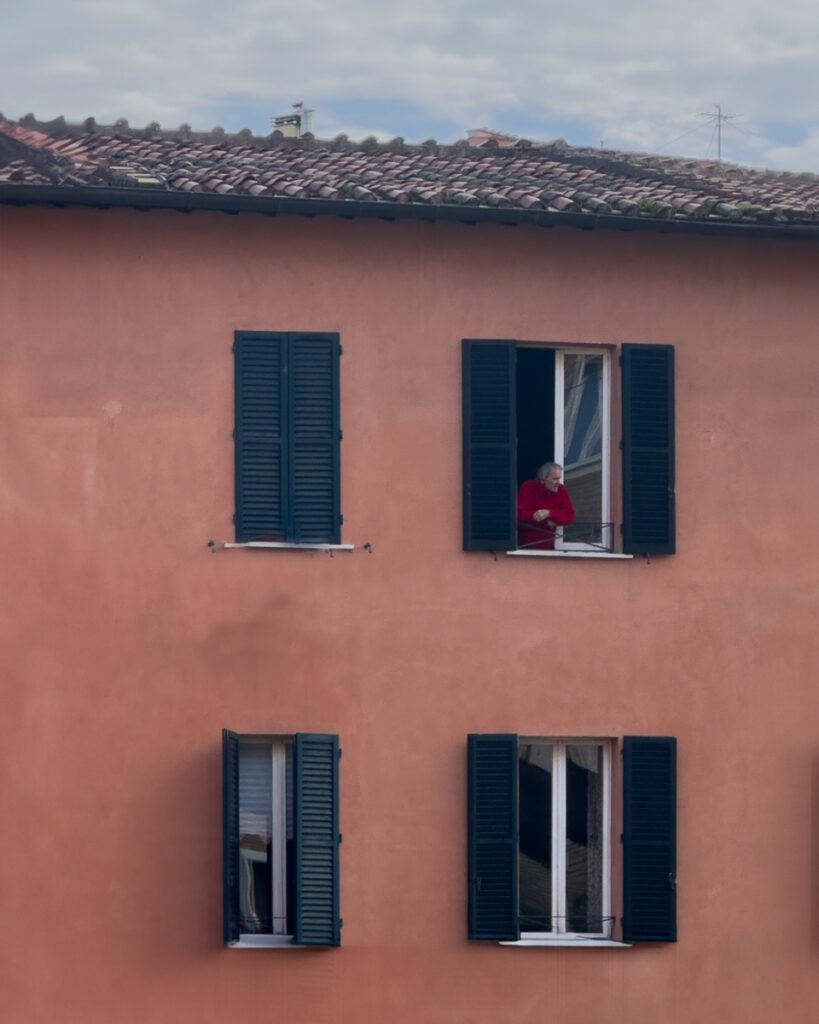
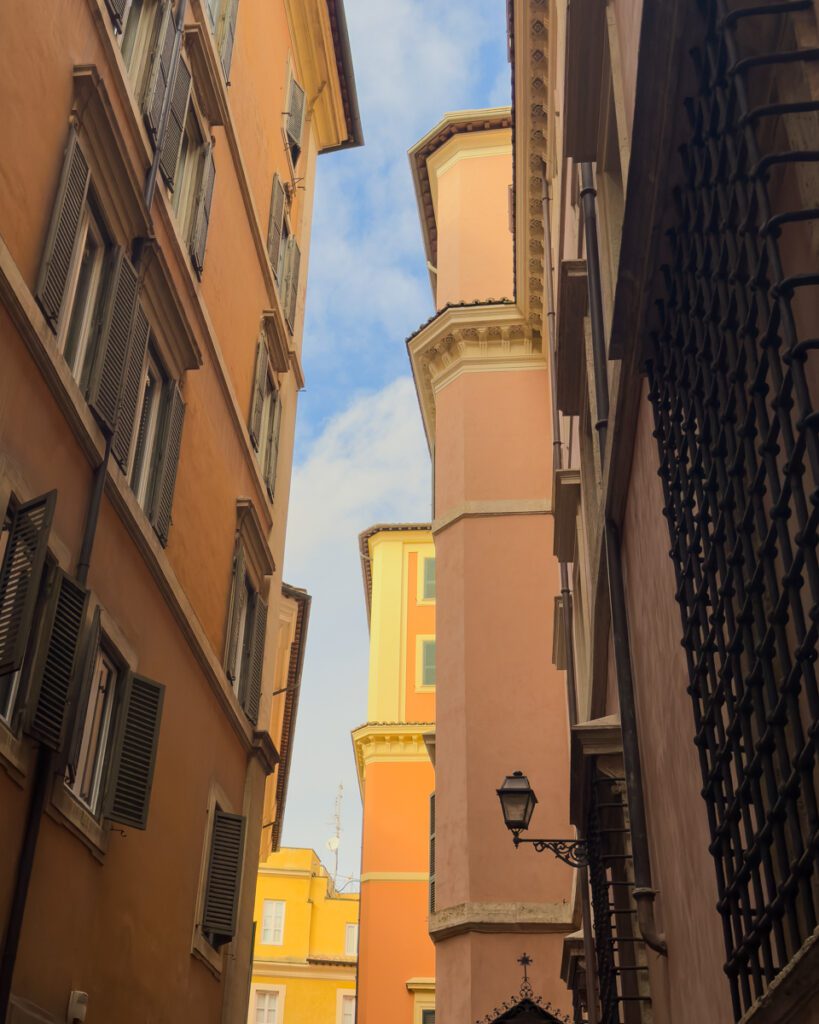
This article may contain affiliate/compensated links. For more information, please see our disclaimer here. We take all the efforts necessary to ensure the information included in this post is accurate, correct and current, sometimes, things just change! Travel information like opening hours, business operations and prices may change. If you find anything in this post that is incorrect or outdated, please let me know in the comments so I can update it for other readers. Cheers!
We love helping you plan amazing trips. If you need any of these services, consider booking them through our affiliate links. Without costing you anything extra, you will be helping support us so we can continue to write these blogs for you.
We thank you again for your continued support.
🏠 Find the perfect place to stay with Booking.com
✈️ Get the cheapest flights with Skyscanner
🚣 Book your favorite activities with Viator
💻 Make sure you have everything you need for your epic trip by checking our store on Amazon
Table of Contents
About the different Rome 3-day itinerary options
With this article, we want to give you a glimpse into the top things to do in Rome, 4 sample 3-day itineraries on how you can spend your time here, where to stay, where to eat, and answer a few important questions you may have.
This is not a checklist of all the things to do in Rome. No one could ever write that article. But this will help you see what the top Rome attractions are, and how you can make this itinerary your own. Depending on how much you want to explore, how busy you want your days to be, and how much walking around you want to do, your plans might vary from what we propose here.
We’ll also share some tips with you for each of the places we recommend. This will help you skip the lines – because depending on when you go, they can get really long, and no one wants to spend their limited time waiting in queues. We’ll also look at how to avoid scams and tourist traps, where to go to escape the crowds and help you have an amazing time in Rome!
If you want even more tips about planning your trip to Rome, or advice for when you’re there, you can check out our full article here.
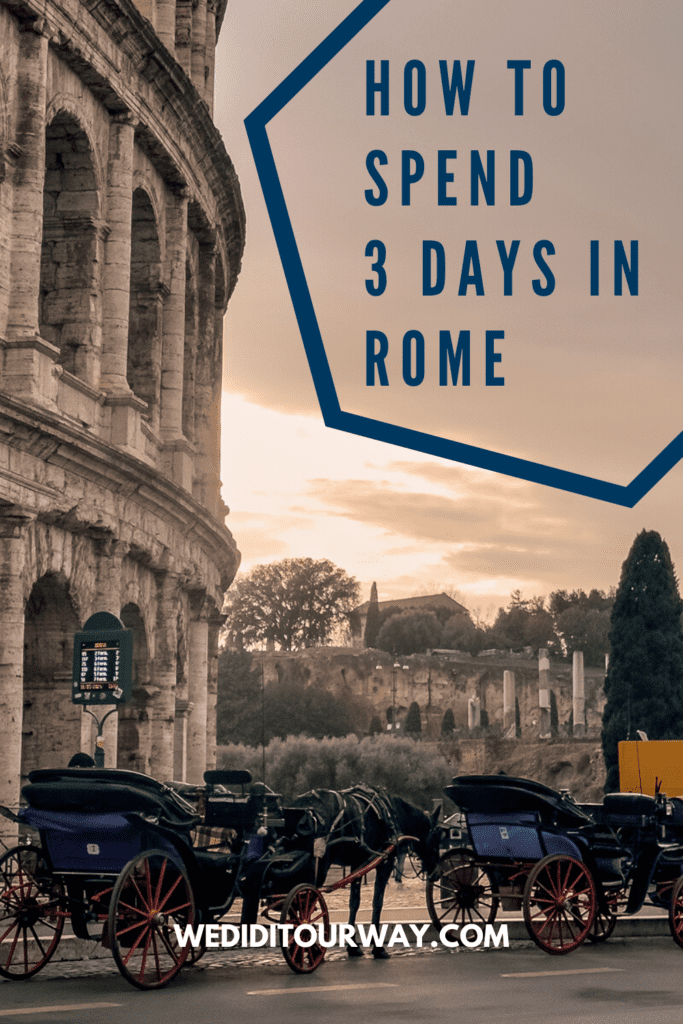
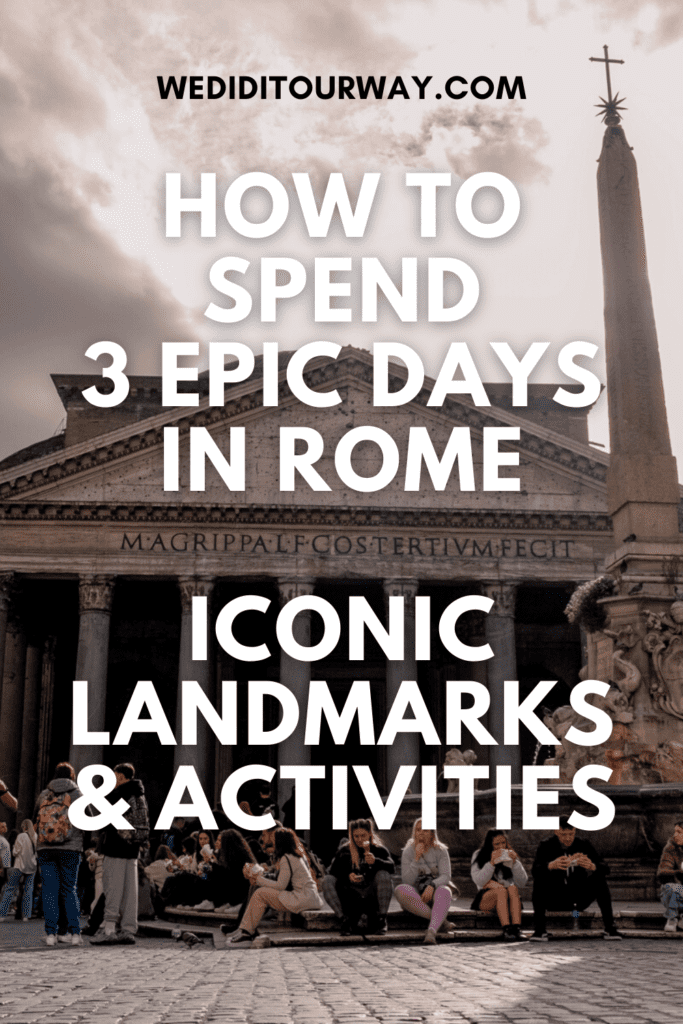
Top tips for visiting Rome
Before we get started, we wanted to share some top tips with you, so you can have an amazing time in Rome:
- Get the Omnia 3-day pass: This pass is a lifesaver to skip the line and get free transportation. With it, you can access Rome’s top sights + Hop-on Hop-off bus tour + 72h travelcard. It’s a two-in-one pass with an OMNIA Card and a Roma Pass. You’ll skip the line at Vatican Museums & in the Sistine Chapel. You can enjoy access to The Colosseum. And, you can take advantage of free unlimited public transport for the validity of your pass.
- If you don’t have a European SIM card, we recommend getting an eSIM with Airalo (if your phone supports it). It’s the easiest way to get data when you travel. The free wifi here is not the safest… you don’t want to get hacked on your first trip to Rome!
Use the code CARINE5115 to get $3 off your package. - Take this airport shuttle: It’s the cheapest and one of the most efficient ways to get to and from the FCO airport to the city.
- Skip the line for the Colosseum, Palatine Hill & Roman Forum: Skip the line and learn all the interesting facts about these historic places in Rome. This tour will help you do just that!
- Don’t wait to see the Sistine Chapel & Vatican: Skip the line to see the works of art in the Vatican Museums and Sistine Chapel.
- Eat like a local: This guided street food tour will let you discover the flavors of Rome. Try local foods as you wander through the city.
If you need even more advice and travel hacks for planning your trip to Rome, make sure you read our full article here.
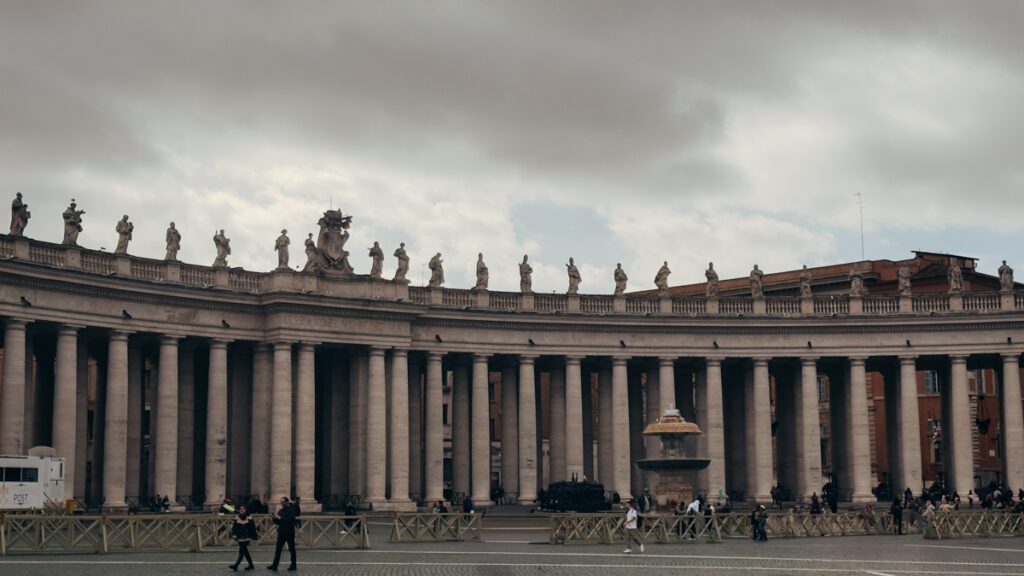
The 21 best things to do in Rome in 3 days – Iconic landmarks & hidden gems
Here is a quick list of all the amazing Rome attractions we’re going to be covering in this article, as well as a few extras. Know that these are the top landmarks to visit, so if this is your first trip to Rome, these are must-sees.
- Colosseum
- Roman Forum
- Altar of the Fatherland
- Vatican Museums & Sistine Chapel
- St. Peter’s Basilica
- Trevi Fountain
- Pantheon
- Spanish Steps
- Piazza Navona
- Castel Sant’Angelo
- The Jewish Quarter
- Villa Borghese
- Appian Way
- Catacombs
- Trastevere
Now that you know the highlights, let’s dig deep into each one! But don’t be surprised if we share some other hidden gems with you too! After all, you know how much we love getting off the beaten path, even in the most touristic places!
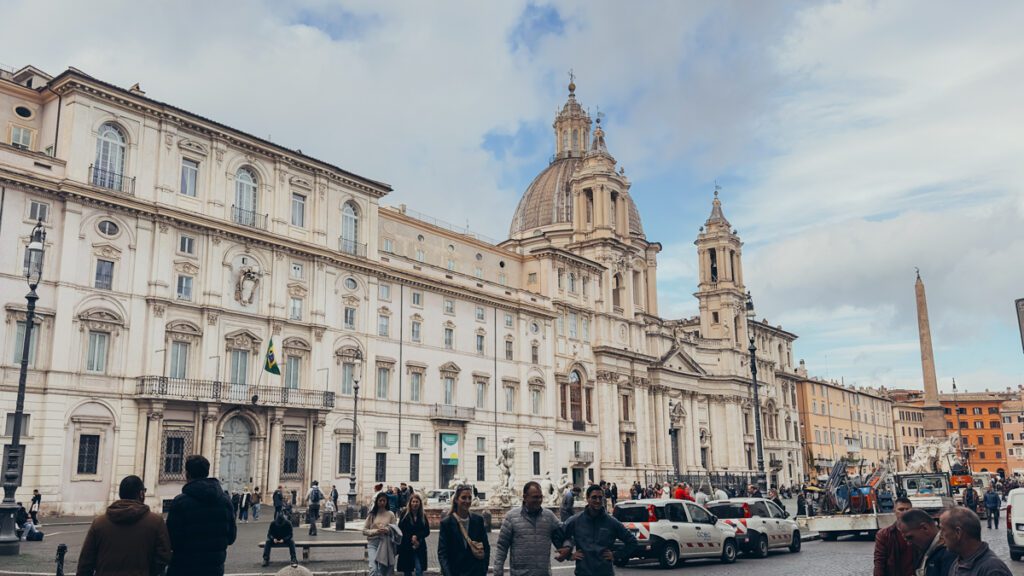
1. Visit the Colosseum, a must-see landmark for your 3 days in Rome
No visit to Rome would be complete without seeing the most imposing structure in the city – The Colosseum. Originally known as the Flavian Amphitheatre, it’s an iconic symbol of the capital and of Italy as a whole. It’s one of the Seven Wonders of the World and a UNESCO World Heritage Site.
Going to the Colosseum is like taking a trip back in time. It’s such an incredible place to discover. If you want to splurge on one landmark in Rome, we recommend getting a guided tour to visit this place. There’s so much history to know about here, that a guide will help you uncover some of its mysteries. It also helps that guided tours don’t have to wait in line and give you access to many other parts of the Colosseum, including the underground, the viewing platform, and the top level.
The Colosseum was built between 72 and 80 AD. Yet, it’s still the largest amphitheater in the world. It stands at 48 meters (157 feet) high with a circumference of 545 meters (1,788 feet). It’s as tall as a 12-story building. Pretty crazy when you think about it! Back in its heyday, it could hold up to 80,000 spectators.
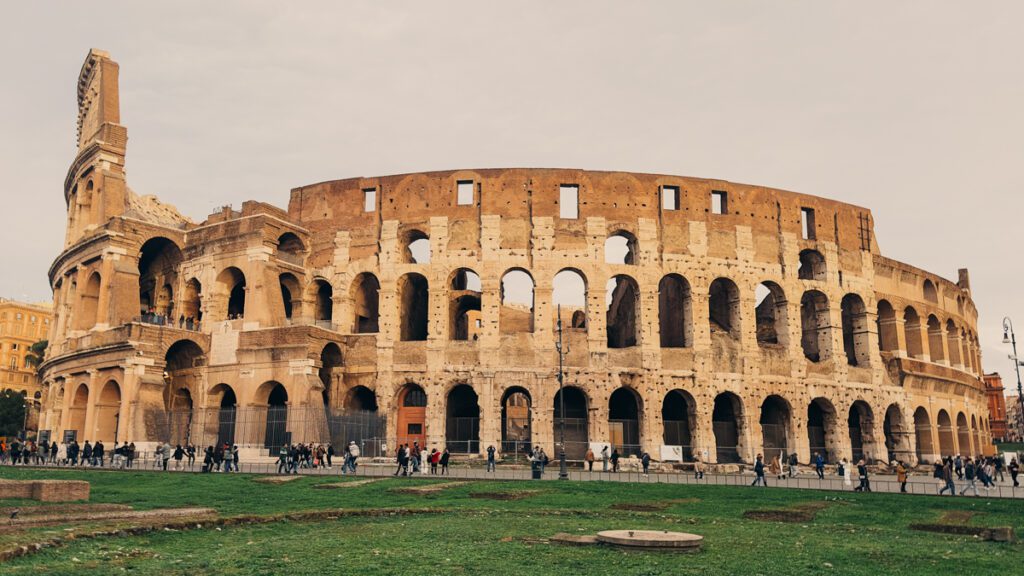
What makes the Colosseum so incredible is that it has a complex system of tunnels and chambers beneath the arena floor. Today, the floor has been removed and you can see the tunnels and passages below, that you can visit on a guided tour. The underground is where they kept the gladiators, animals and set design elements during games. They would bring them up by using a pulley system they had – kind of like elevators. You can actually see how this worked in the Museum of the Colosseum.
Contrary to popular belief, the Colosseum wasn’t just for gladiators. And most gladiators who came into the arena survived, despite what we’ve seen in so many movies. The amphitheater hosted a variety of events, including animal hunts and mock sea battles where the floor was flooded and ships were brought in. This is also where they had public executions and even religious ceremonies. Plus, entrance to most events was free back in the day. The Emperors footed the bill to get into the good graces of their subjects. Today, the only day you can get into the Colosseum for free is on the First Sunday of the month.
On-site, you will find an Information Center where you can learn more about the history and significance of the Colosseum. You have the Museum upstairs, as well as gift shops where you can purchase souvenirs if you’d like. There are restrooms inside the Colosseum – they’re close to the entrance. There is also an elevator, which makes the site accessible for wheelchairs as well.
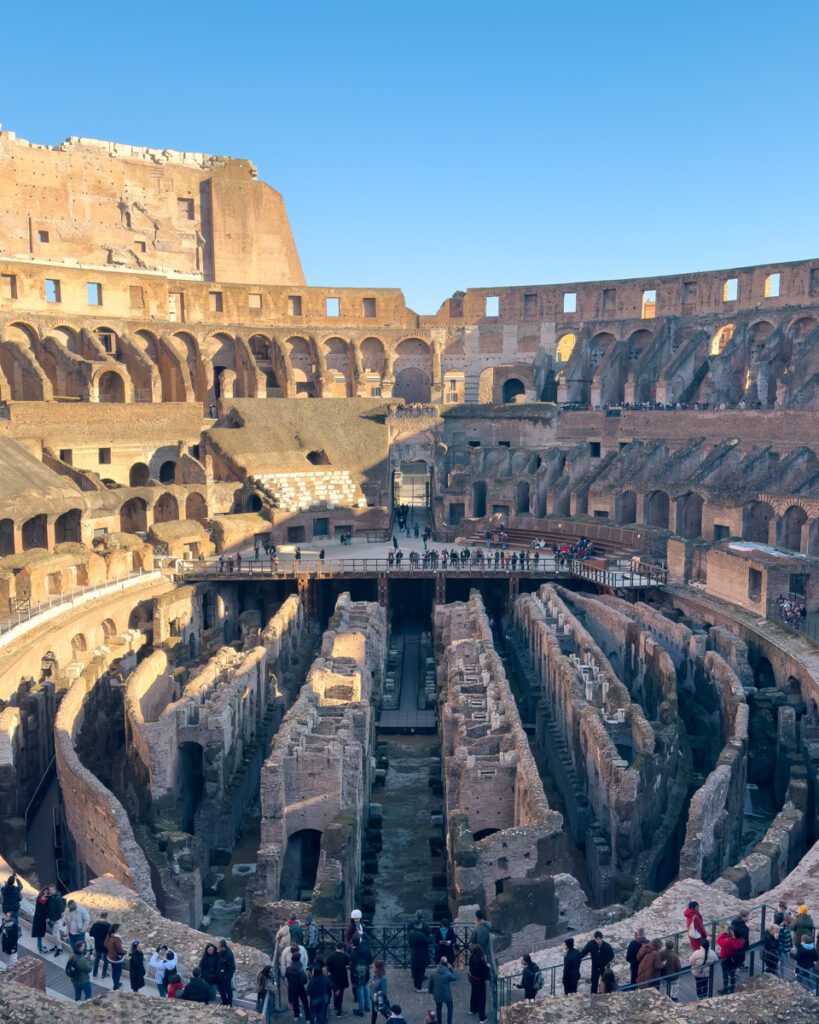
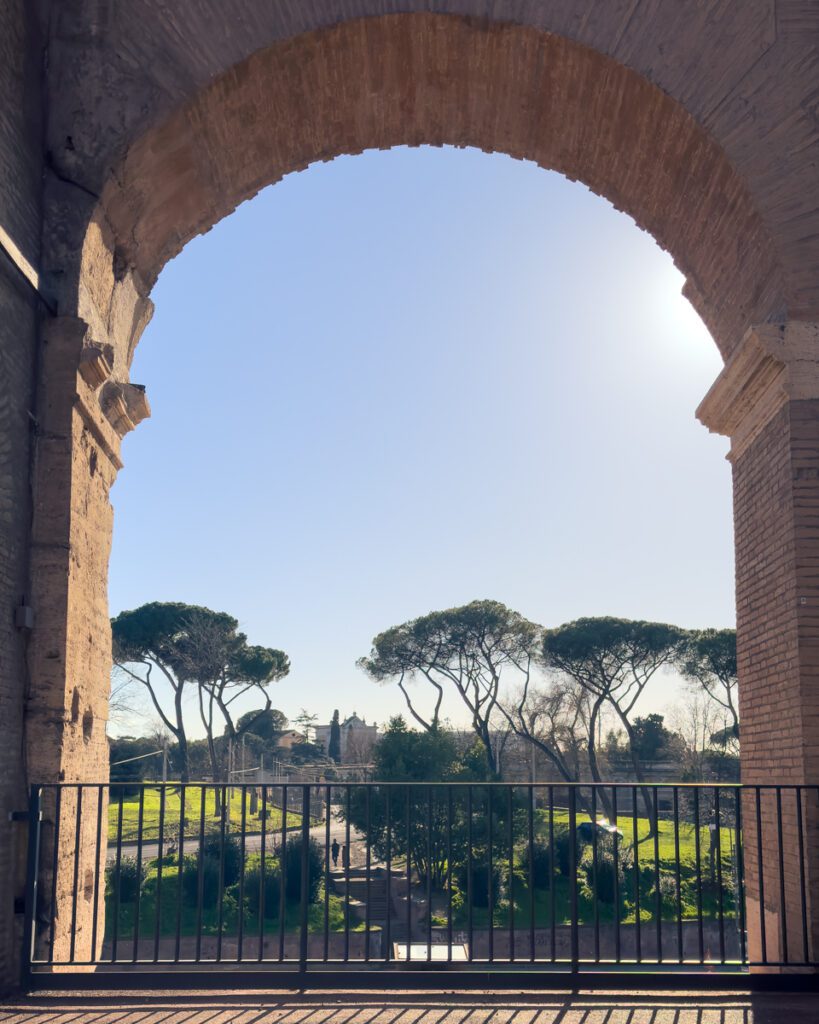
Tips for visiting the Colosseum on your 3-day Rome itinerary
The Colosseum is open daily, but its hours of operation vary. The best way to get in fast is to purchase your ticket online so you skip the line. If you’re going during the busy season, we recommend buying your ticket well ahead of time as there is a daily cap on the number of visitors allowed into the Colosseum. When we visited Rome last January, we bought our tickets at the booth. It was a Saturday and we only waited in line for about 20 minutes.
However, you should note that if you purchase your ticket, you have to enter the Colosseum within 15 minutes of the purchase. You can’t come back and enter at a later time. Your entrance ticket also gives you access to the Roman Forum. It’s valid for the next 24 hours.
If you want to avoid crowds, we recommend either visiting as soon as the Colosseum opens or at the last entrance hour, which is one hour before closing, depending on when that is. It’s also better to visit on weekdays. And if you can, visit Rome in the off-season, combine all these tips and you might get the least amount of people. But let’s be honest! The Colosseum is probably Italy’s most popular landmark. It will be busy!
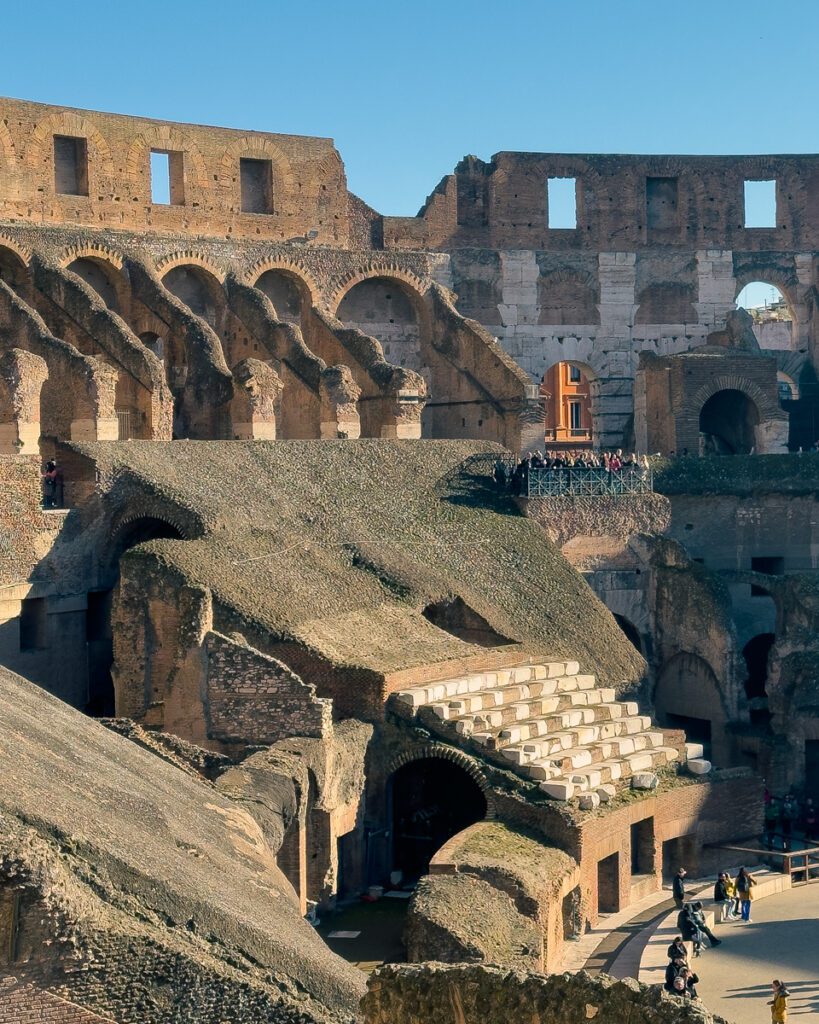
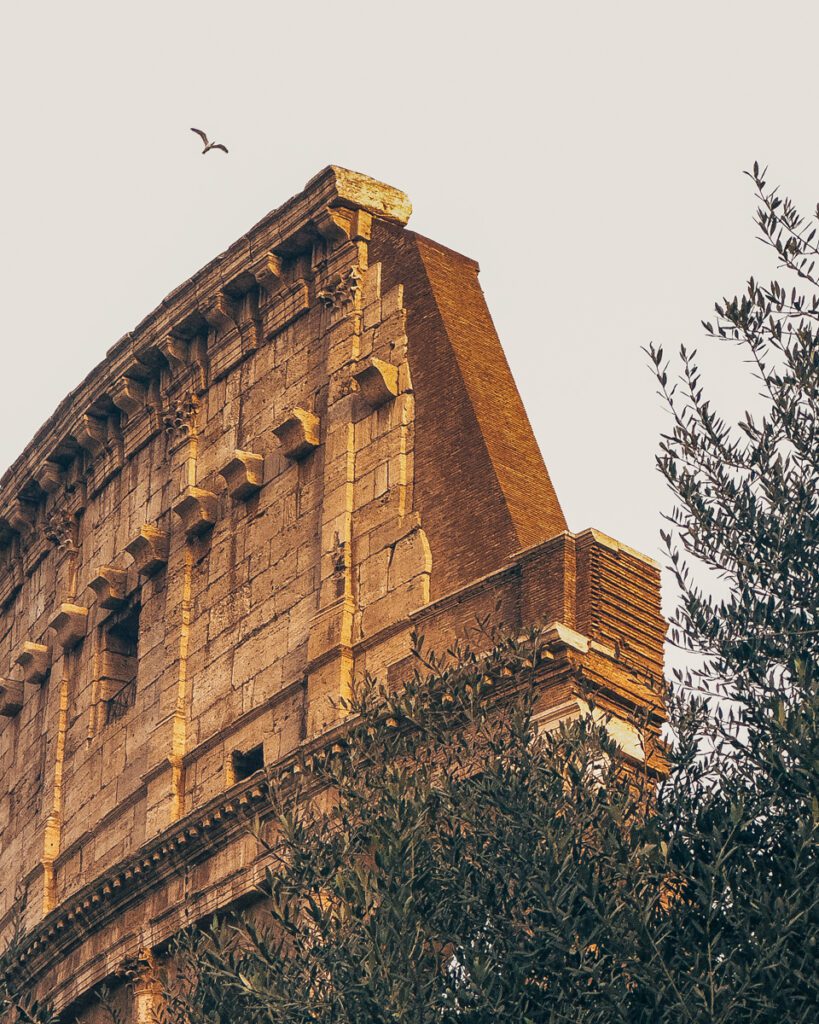
If you want to visit the Colosseum on your own, you can either get the audio guide they rent here. If not, we enjoyed listening to this one from Rick Steves. It was informative and entertaining. You can also learn more fun facts about the Colosseum in our article here.
Although the Colosseum is amazing to view from the inside, we also recommend you walk around outside, and once you’re in, take the time to admire the view from the openings. You get a completely different perspective of Rome.
To fully visit the Colosseum, we recommend you take at least 2 hours (even 2.5) to take it all in. Walk around the walls and take your time inside. Soak it all in! If you’re taking a guided tour, it may take you up to 3+ hours at the Colosseum. We recommend starting early or ending the day with this activity. Don’t do it in the middle of the day, as it will be taxing and the sun will be beaming.
INFORMATION ABOUT VISITING THE COLOSSEUM
Official site
Name in Italian: Colosseo
Opening hours: Open every day, but hours vary by season. Check the official site for up to date info. Opening hour is between 8:30 or 9 am and it closes between 4:30 or 7 pm. Last admission is 1 hour before closing.
Ticket price: At the gate, you pay €16 (+ €2 if you purchase online). This is for the standard ticket that gives you access to the Roman Forum, Palatine Hill, and the Colosseum. You can also get the Full Experience ticket which includes a access to the Colosseum arena and underground area for €24. EU citizens aged 18-25 – €2. Free for anyone under 18 years old
Location: Here on Google Maps. Piazza del Colosseo 1
Transportation: Metro: Line B, stop Colosseo. Bus: n. 75 – 81 – 673 – 175 – 204. Tram: n. 3
How long to spend at the Colosseum: 2-2.5 hours self-guided. Guided tours will be from 2-3 hours
Here are some tours you can opt to visit with. They will help you skip the line, and will give you important information about the places you’re visiting.
A quick note about the tours we’re recommending here, and everywhere else in the article. We look through the comments on Viator and check their ratings to make sure you’re getting the most bang for your buck. Although we haven’t done these tours ourselves, we want to help you pick the best one for your needs. Make sure you take a good look at them too so that you pick the one that best suits your budget, time constraints and plans.
2. Explore the Roman Forum & Palatine Hill on your 3-day Rome itinerary
It’s impossible to visit the Colosseum and not to check out the Roman Forum & Palatine Hill. Not only are they located about 5 minutes from each other, but your Colosseum entry ticket gives you access to them as well!
Back in the day, over 2,000 years ago, the Roman Forum was the city center of Rome. This is where public gatherings, elections and different ceremonies took place. It’s also where senators argued, emperors held court, and gladiators trained. This is a beautiful open-air museum today, but back then, it’s where everything happened! It’s crazy to imagine what life was like during those times.
According to Roman mythology, Palatine Hill is where Romulus founded Rome in 753 BC. Palatine Hill is also where the emperors used to live their good life, the life of luxury. You can explore the Domus Augustana, where emperors like Augustus enjoyed opulent living back during their reign. While you’re on Palatine Hill, make sure to visit Terrazza Belvedere del Palatino – you’ll get a bird’s eye view of the Roman Forum and the Colosseum. It’s one of the nicest views of Rome.
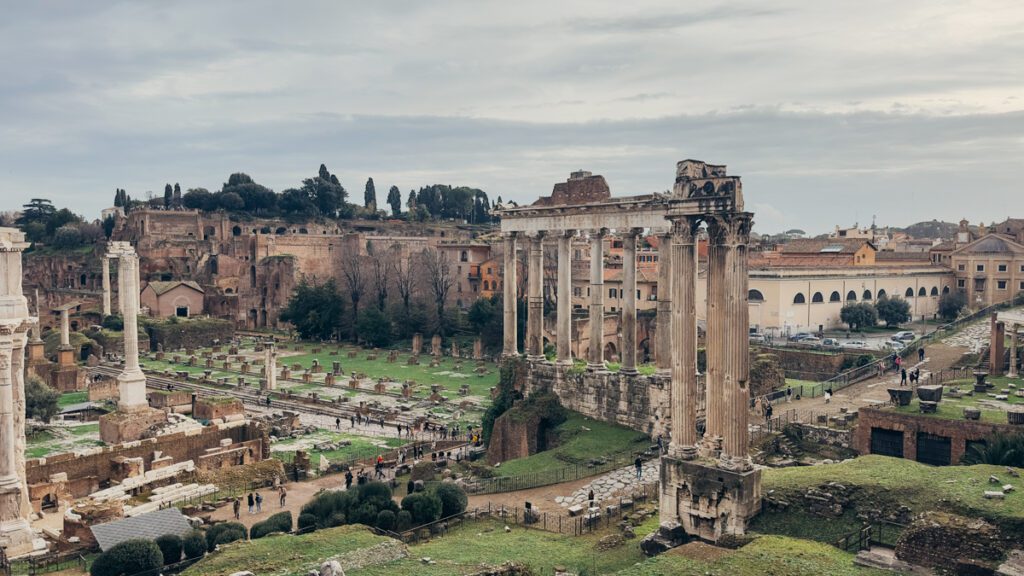
You can walk the grounds here and explore the different ruins. You have a few panels all around the grounds that give you some information about what you’re seeing. While here, you can see iconic structures like the Arch of Titus and the Temples of Saturn, of Vesta, of Venus, of Antonius and of Romulus, which its bronze doors that date back to 309 AD.
You’ll also see the ruins of ancient government buildings, temples, and basilicas including the Curia Julia (Senate House), the Via Sacra, Faustina and its “hanging door,” the Arch of Septimius Severus, and the Temple of Julius Caesar.
You can walk here for 30 minutes, just to get an idea of the place, or spend a good 2-3 hours on the grounds. There’s a lot to see, and your time here will depend on how deep you want to go. Note that there are restrooms located at the entrances (and exits).
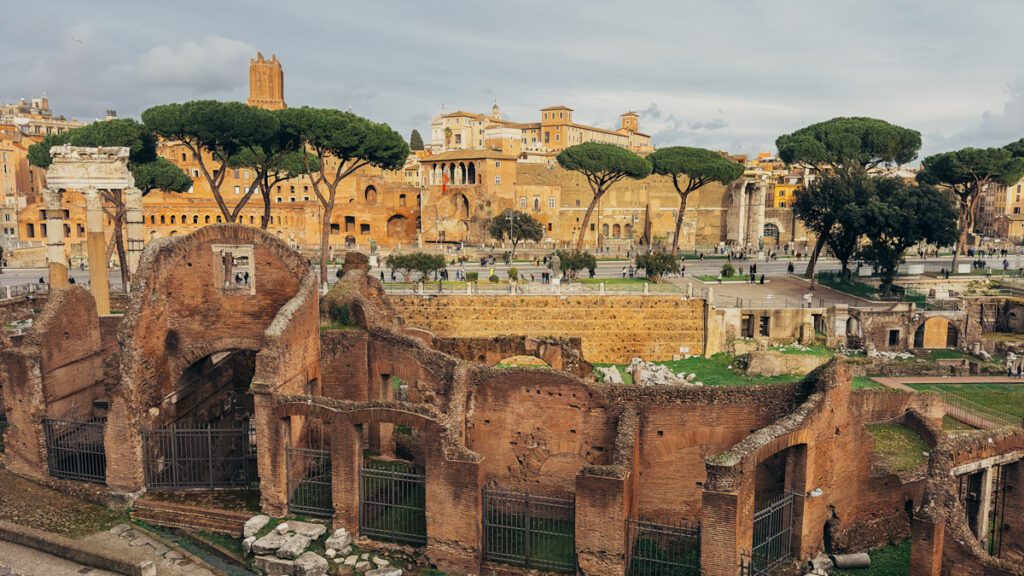
Tips for visiting the Roman Forum and Palatine Hill
If you took a guided tour of the Colosseum, chances are, they’ll also bring you to the Forum and Palatine Hill. If you don’t want to get a tour, we recommend listening to the free audio guide from Owen Steves. It’s great because it gives you a ton of information so you can better understand everything around you!
Also, during the high season, if you didn’t buy your Colosseum tickets in advance and decide to get them at the ticket office on location instead, buy them at the Roman Forum or Palatine Hill. You’ll have to visit these places first. But, the good news is, the lines here are much shorter, so you’ll end up saving time!
As you can imagine, the Roman Forum and Palatine Hill are also quite popular. If you want to avoid the crowds, we recommend going at opening, or later in the afternoon. Also, considering it’s an open-air museum, shade is hard to come by. Avoid going in the middle of the day – it gets hot and it’s not the best time to take pictures either.
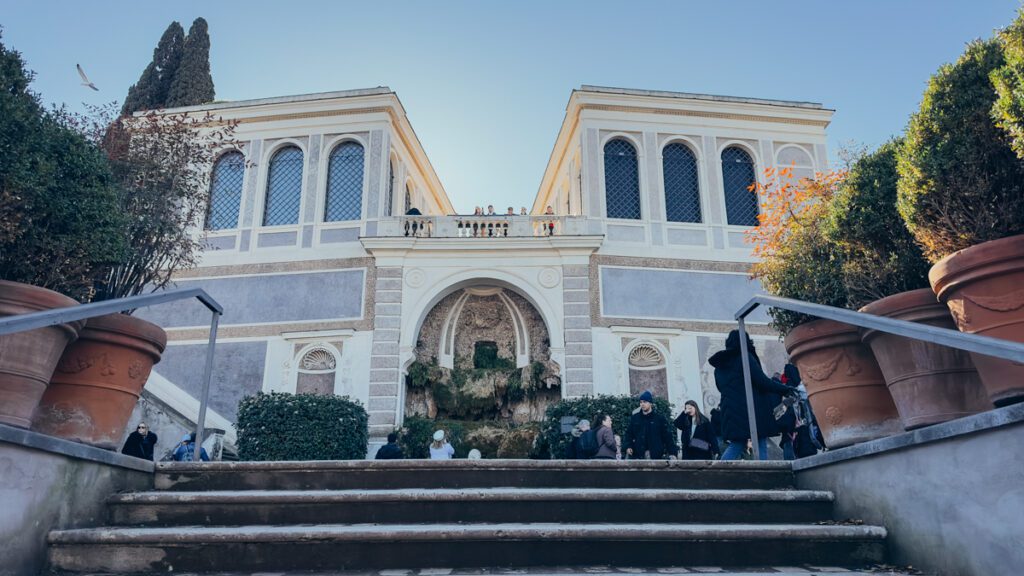
A great tip here is to wear comfy shoes – the floor is uneven and rocky in many places, so watch your footing. Make sure to bring some sun cover as well – a hat or a light long-sleeve shirt will go a long way. Also, note there are quite a few water fountains around the property, so bring a reusable water bottle to fill it up.
Now, whether you want to visit the Roman Forum and Palatine Hill on the same day as the Colosseum will depend on 2 things: If you took a tour and how much you want to walk around. Chances are, if you took a tour, you’ll need to visit both on the same day – that makes for a lot of information to absorb, and a lot of walking around, likely in the hot Roman sun.
If you don’t want to walk a lot or don’t want to do one of these activities in the hot sun, we recommend breaking up your visits. If you’re trying to avoid crowds, you’ll either want to go here for opening or near closing – so you can either visit the Colosseum on one day and the Forum and Palatine Hill on another day. Or you can visit one in the morning, and the other later in the afternoon. There are enough things around this area that you could break it up.
INFORMATION ABOUT THE ROMAN FORUM & PALATINE HILL
Official site
Name in Italian: Foro Romano
Opening hours: Open every day, but hours vary by season. Check the official site for up to date info. Opening hour is at 9 am and it closes between 4:30 or 7 pm. Last admission is 1 hour before closing.
Ticket price: At the gate, you pay €16 (+ €2 if you purchase online). This is for the standard ticket that gives you access to the Roman Forum, Palatine Hill, and the Colosseum. You can also get the Full Experience ticket which includes a access to the Colosseum arena and underground area for €24. EU citizens aged 18-25 – €2. Free for anyone under 18 years old
Location: Check here on Google Maps. There are many entrances & exits. Foro Romano: Largo della Salara Vecchia, 5/6. Palatino: Via di San Gregorio, 30
Entrances: Arco di Tito, Varco Vignola in Via di San Gregorio, Largo della Salara Vecchia and Carcere Mamertino.
Exits: Largo della Salara Vecchia, Arco di Tito, Varco Vignola in Via di San Gregorio, Via Petroselli
Transportation: Metro: line B station Colosseo. Bus: n. 75, 81, 673, 175, 204. Tram: n. 30
How long to spend at the Roman Forum & Palatine Hill: 1-2 hours self-guided. Guided tours will be from 2-3 hours
3. Altar of the Fatherland, a Rome landmark with a stunning view
Welcome to Derek’s favorite modern building in Rome (obviously, when he’s not thinking about the Roman Empire and the Colosseum!). The Typewriter building, or the Wedding Cake (we don’t see it) or the Altare della Patria is home to a formidable statue, the Victor Emmanuel II National Monument. It’s a colossal white marble structure dedicated to the first king of a united Italy.
It’s located in Piazza Venezia, and it’s on the way to the Colosseum, depending on which way you come from. If you’re walking around Rome, a stop here is a must, before or after visiting the Colosseum and Roman Forum.
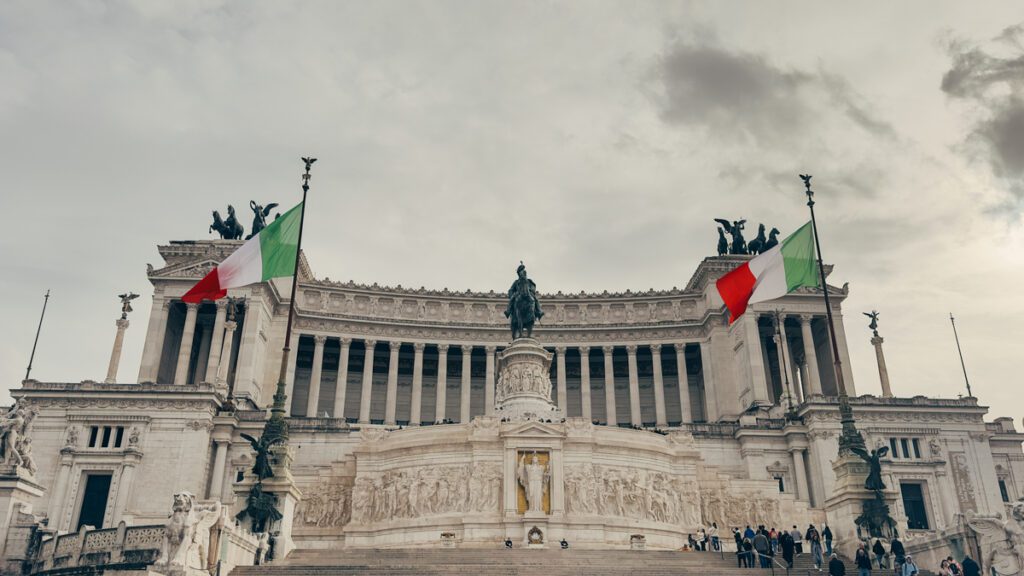
This monument was completed in 1925 and took about 50 years to build. It symbolizes Italian unity. It’s also home to the Tomb of the Unknown Soldier, commemorating Italian soldiers who lost their lives in World War I. It’s also where you can get a stunning view of Rome from a good height!
During the day, you can visit the museum located inside the monument. It showcases exhibits related to Italian reunification and military history. You’ll need about 1-1.5 hours to visit it. The cost of entry is €17 and also gives you access to the Palazzo Venezia across the street as well as the elevator to the panoramic terrace.
If you don’t want to visit the museum, entry to the building is free. Another one of the great places you can visit for free in Rome. You can climb to the different levels and get different vantage points of Rome’s panorama. Make sure you climb all the way to the top to get an amazing view. There’s even a café up there where you can sit and take it all in.
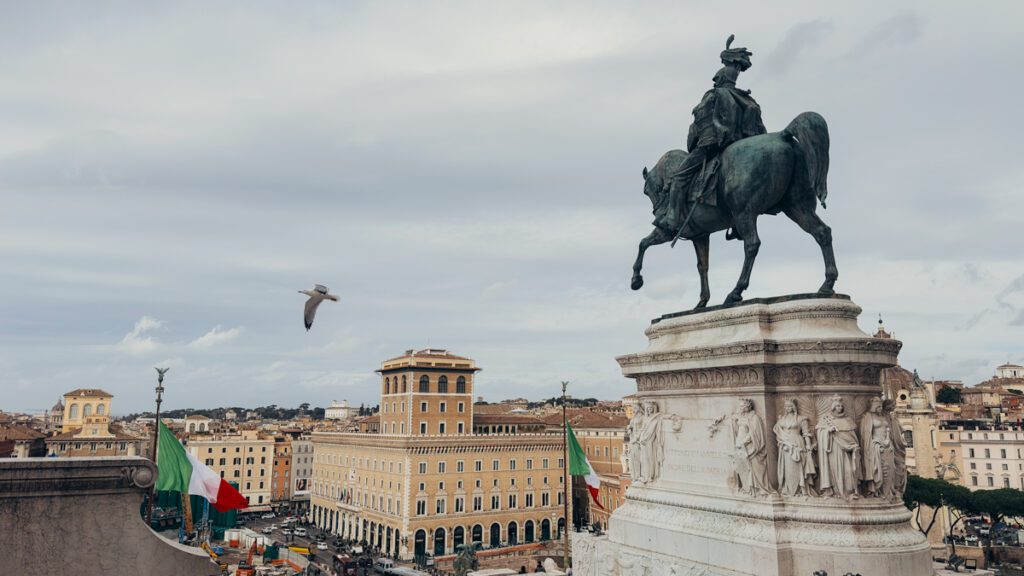
Tips for visiting the Altar of the Fatherland
This is one of the most beautiful buildings in Rome. It’s well worth visiting it, not only to check out the view from the top but also, to take in its beauty. What’s great about this building is that you can have a very different perspective of it at night, when it gets lit up, Well worth checking it out, if are in the area.
Also, getting this view is one of the best free things you can do in Rome. And considering the exchange rates (yup, our Canadian dollar is struggling), it’s always nice to find free things to do! The best time to get a view here is at sunset. It might get a little crowded, but the views of the city in the golden light will be well worth it! If you’re trying to avoid the crowds, come as close as possible to opening hour.
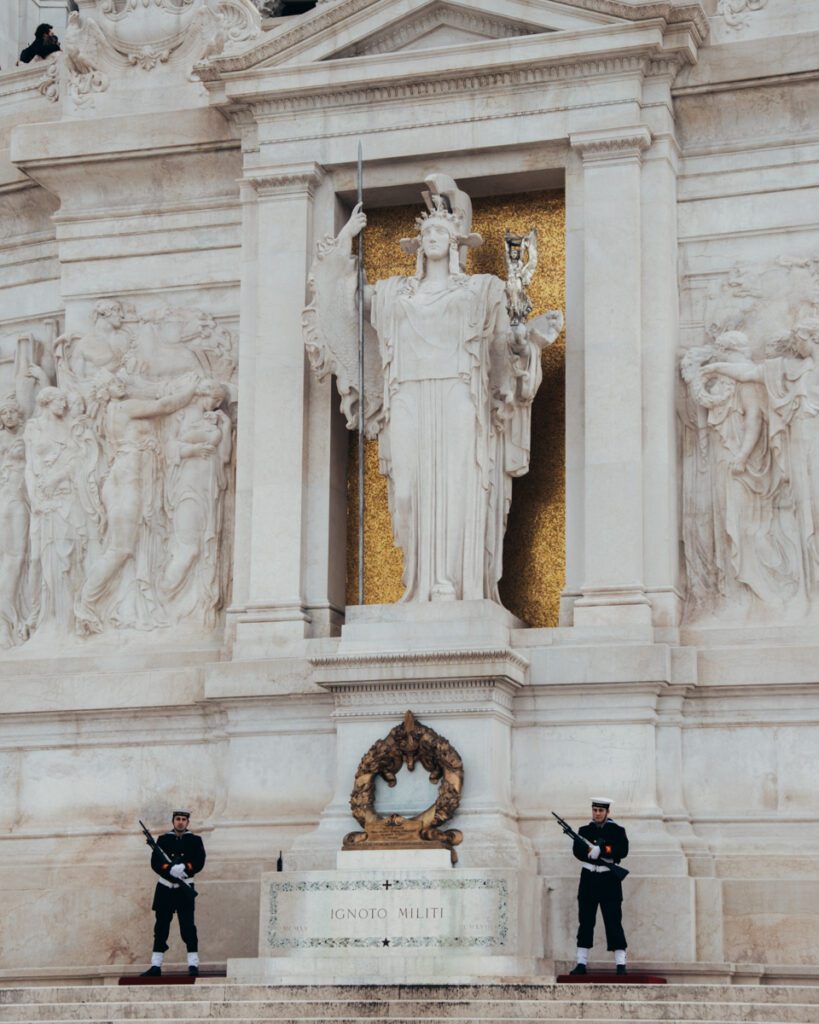
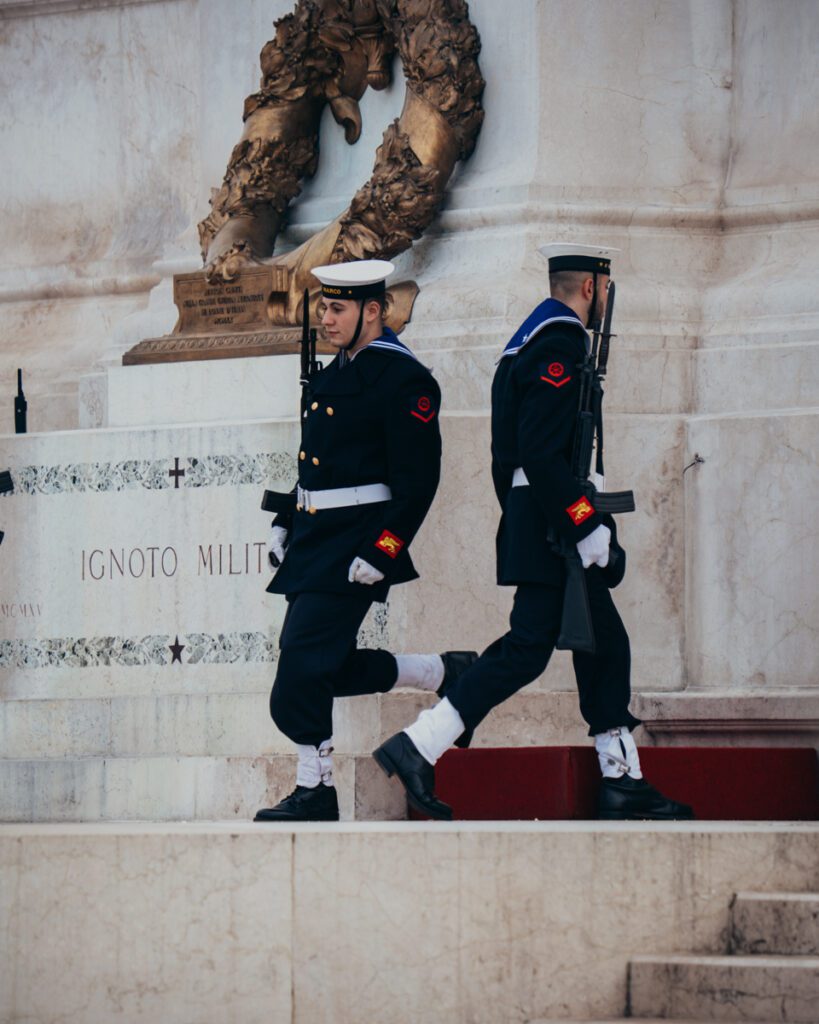
If you like free things (who doesn’t?!), admission to these sites is free on the first Sunday of the month. However, expect tons of crowds – both foreigners and locals. If you’re visiting Rome in the off-season, this can still be a fun activity, but during the high season, don’t expect to enjoy this free experience! Note that you have to reserve a ticket, even if it’s a free event.
Another little gem to see while you’re here is the changing of the guard. It happens every hour, on the hour. There are always two guards standing by the tomb of the fallen soldier. Every hour, they are replaced by 2 different guards with a little changing of the guards ceremony.
INFORMATION ABOUT THE ALTAR OF THE FATHERLAND
Official site
Name in Italian: Altare della Patria
Opening hours: Open from Monday to Sunday from 9:30 am to 7:30 pm (last entry at 6:45 pm). Every Friday and Saturday until September 16, from 7:30 to 10:30 p.m. (last admission 9:45 pm). From July, the Vittoriano and the Panoramic Terrace, extend opening hours from 7:30 pm to 10:30 pm, with last admission at 9.45 pm.
Ticket price: Free to climb up to the lower terrasses. €17 for the museums and the elevator. Tickets allows access to all the sites and are valid for seven days from that issue. Admission is free on the first Sunday of the month
Location: Check here on Google Maps. Piazza San Marco, 49
How long to spend at the Altar of the Fatherland: 45-60 minutes self-guided without the museum or elevators. Allow a good 2-3 hours if you want to visit the 2 museums, the free parts of the building as well as take the elevator up to the panoramic terrace.
4. Walk around Via dei Fori Imperiali, Rome’s historic road
Via dei Fori Imperiali is the grand avenue that runs through the heart of Rome. It connects Piazza Venezia to the Colosseum. Along the way, you’ll pass by several ancient Roman imperial forums – The Forum of Augustus, the Forum of Trojan, and the Roman Forum on the other side of the street.
Adorning the Via dei Fori Imperiali, you’ll find many statues of Roman emperors, as well as different people busking, painting and running scams… Yes, those ‘nice guys’ giving you bracelets for free (only to chase you for money after that) – they’re scam artists. Learn more about this tourist trap in our article about the best tips and advice for visiting Rome.
A quick fun fact, Via Dei Fori Imperiali was constructed by Benito Mussolini in the 1930s. It was a part of his great vision for the redevelopment of Rome. His wish was to celebrate the greatness of ancient Rome. As beautiful as it is, it wasn’t always praised by the people – the road sparked debates about preserving archaeological sites versus creating a grand urban boulevard.
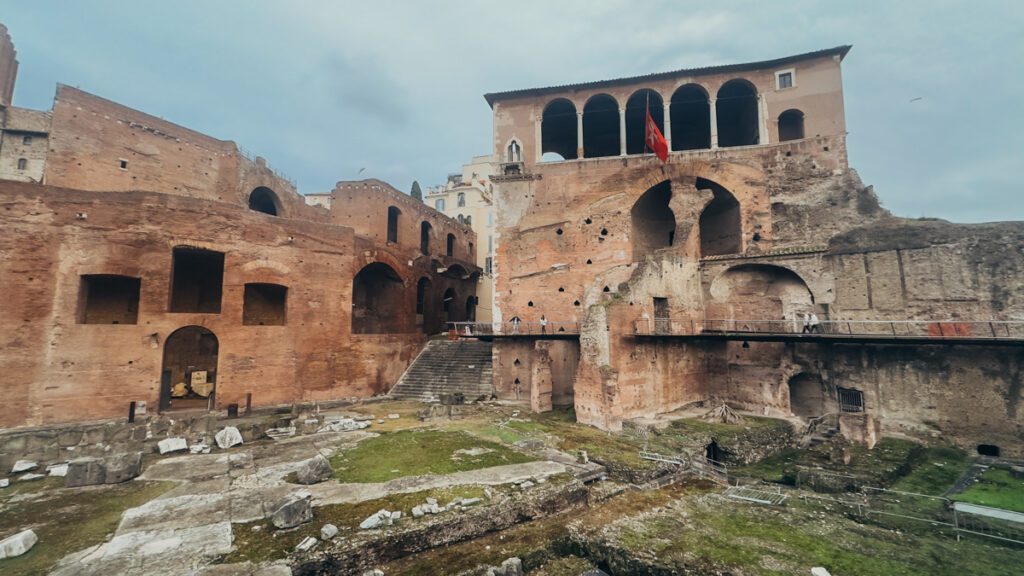
Walking down this street is like taking a trip back in time. You can see remnants of Ancient Rome on both sides of the street. Just imagine what life must have been like back in the day for Romans living in this metropolis. What’s even crazier is knowing that the street is built atop other forums and buildings that have not yet been excavated. This is one of the reasons it’s so hard to build a metro system in Rome – way too much history to dig up!
Some quick facts to know about the different Forums on Via Dei Fori Imperiali – Trajan’s Forum was built between 107 and 112 AD. It was part of a larger complex of buildings, including Trajan’s Column, Trajan’s Market, and the Basilica Ulpia. Despite centuries of wear and tear, Trajan’s Market stands well-preserved and now houses the Capitoline Museums, a trove of art and archaeology.
The Forum of Augustus was constructed to celebrate the establishment of the Pax Romana and commemorate military victories. The construction of the Forum began in 42 BC and was finished in 2 BC, during the reign of Emperor Augustus (Octavian). It was part of a larger complex that included the Temple of Mars Ultor (Mars the Avenger).
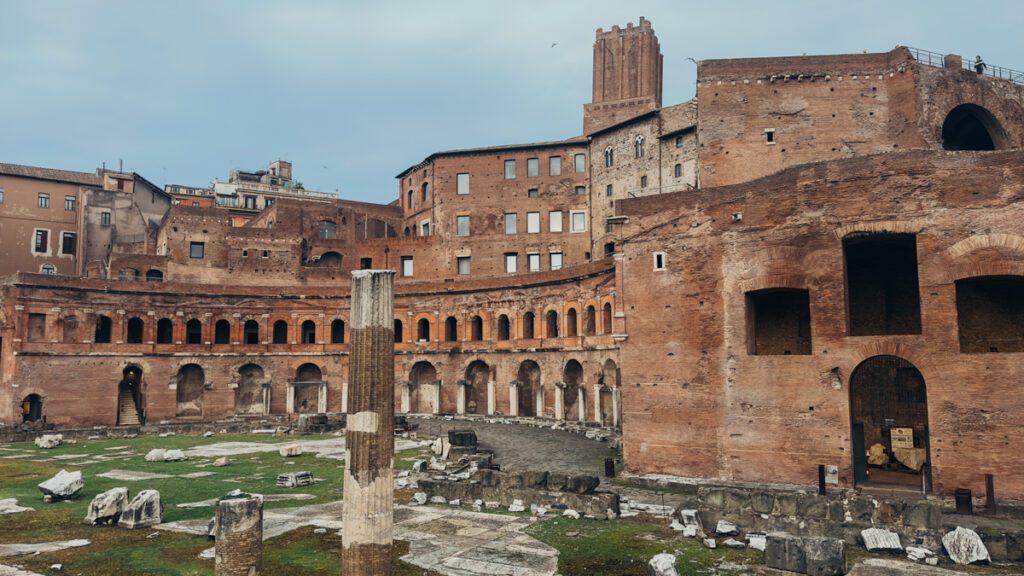
Tips for visiting Via dei Fori Imperiali on your first trip to Rome
Our first tip here is a simple one – watch out for pickpockets and scammers. There are a lot of people that walk down this avenue. It’s one of the most iconic streets in Rome, so it’s to be expected. However, with crowds, buskers, street performers, some scammers and pickpockets. Make sure you’re aware of your surroundings and that you don’t accept any “free gifts” from anyone!
You will also see some street performers, often dressed up as a statue (sometimes so well you actually think that they are statues) or on our recent trip as a genie (looking as though he is floating in midair). Just know that if you take a picture with these people, they will expect you to give them some money.
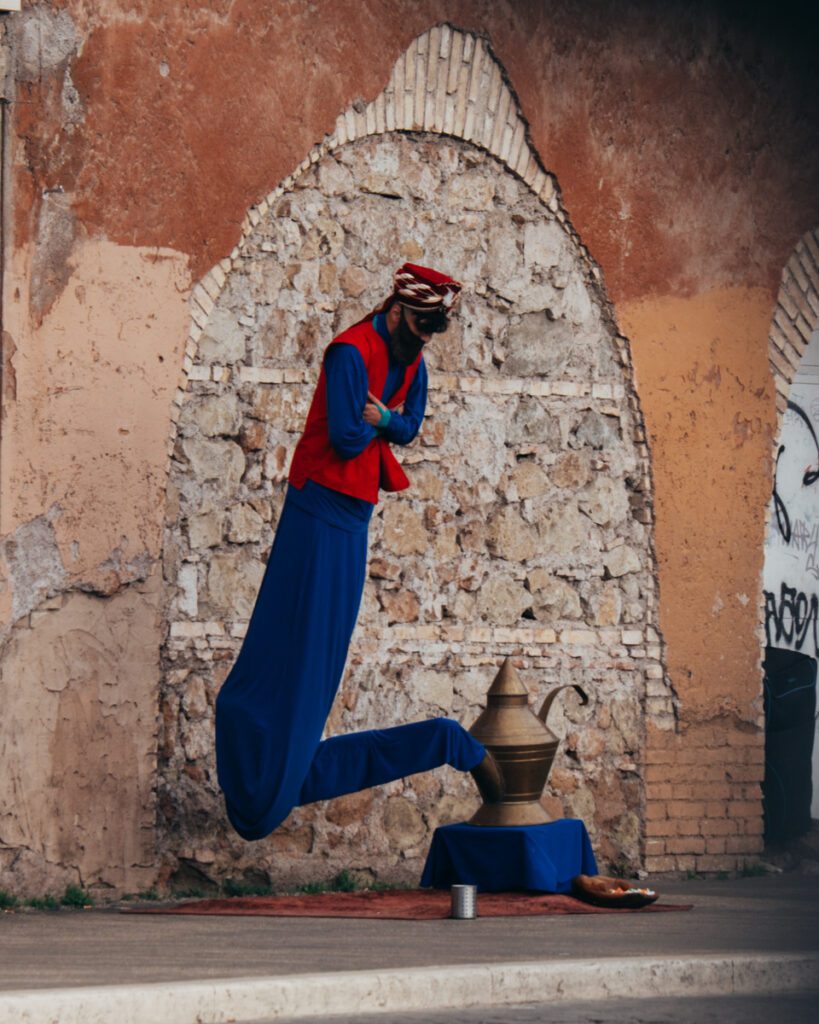
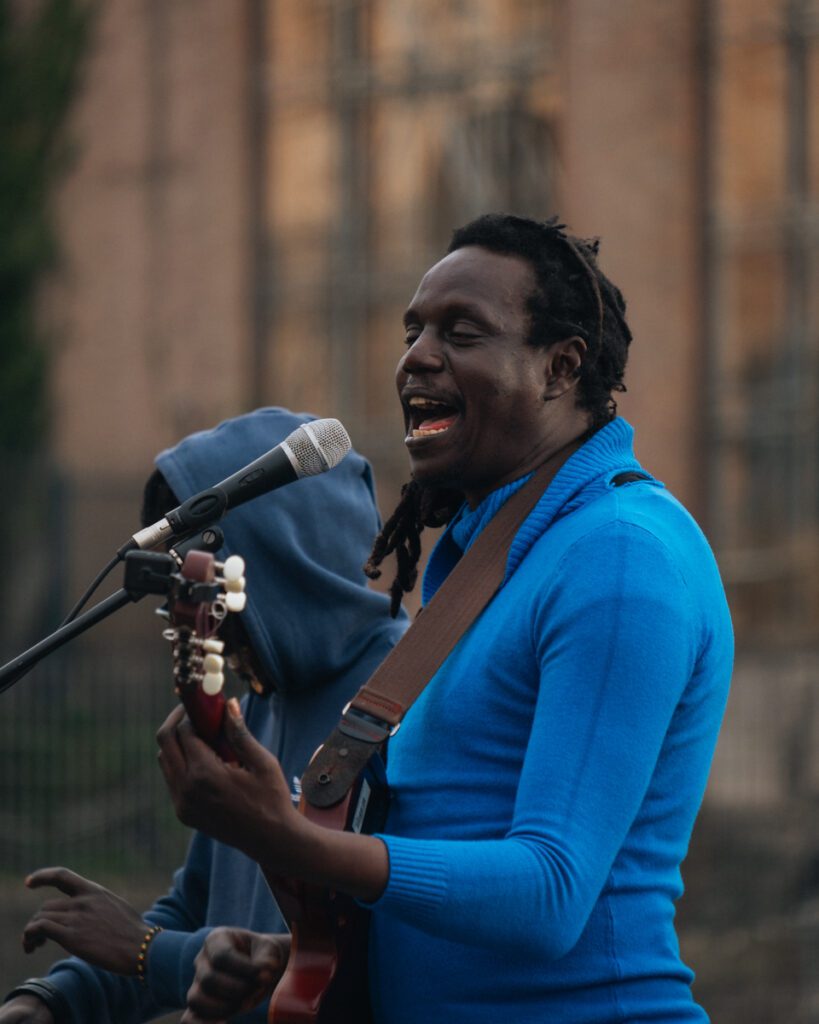
Next, is a fun little fact. On Sundays, the Via dei Fori Imperiali is closed to street traffic. This means you can walk freely on this street, from Plaza Venezia all the way down to the Colosseum. Take your time and stroll or bike down the street. Enjoy everything it has to offer. It’s a beautiful experience to be car-free! But again, be careful with your belongings. In summer months, when it gets crowded, it’s easy to lose sight of your things.
Finally, from June to October, there are illumination shows that happen on the Forum of Augustus and the Forum of Cesar. These are paying shows that are represented in different languages. They light up the forums and project animations on the walls while telling the stories of these emperors. If you have a free night during the summer months, it’s a great way to spend some time.
INFORMATION ABOUT VIA DEI FORI IMPERIALI
There is no official site
Name in Italian: Via dei Fori Imperiali. Foro di Augusto. Foro di Traiana
Opening hours: You can walk along the street at any time in the day or night. At night, the forums are illuminated which give it a different look completely.
Ticket price: Free to walk the street.
Location: Check here on Google Maps.
How long to spend: You can walk the street in 20 minutes, but if you want to read all about the different structures and forums, take in the street performances and stroll about, give yourself a good hour here.
5. Capitoline Hill, admire Michelangelo’s masterpiece during your 3 days in Rome
Welcome to the smallest of the Seven Hills of Rome – Capitoline Hill. It served as the religious and political center of ancient Rome. Today, it’s where you can admire one of Michelangelo’s masterpieces and take in breathtaking panoramas of Rome. It’s a stone’s throw away from the Altar of the Fatherland. A great place to stop by before or after your time there.
The name “Capitoline” comes from Caput, or “head”. This is supposedly because of the head that was found here during the hill’s foundation. The iconic Piazza del Campidoglio, the center of Capitoline Hill, was designed by Michelangelo himself. It’s the first modern square in the Eternal City. You can admire the perfectly symmetrical palazzi framing a grand staircase and the famous Marcus Aurelius’ equestrian statue.
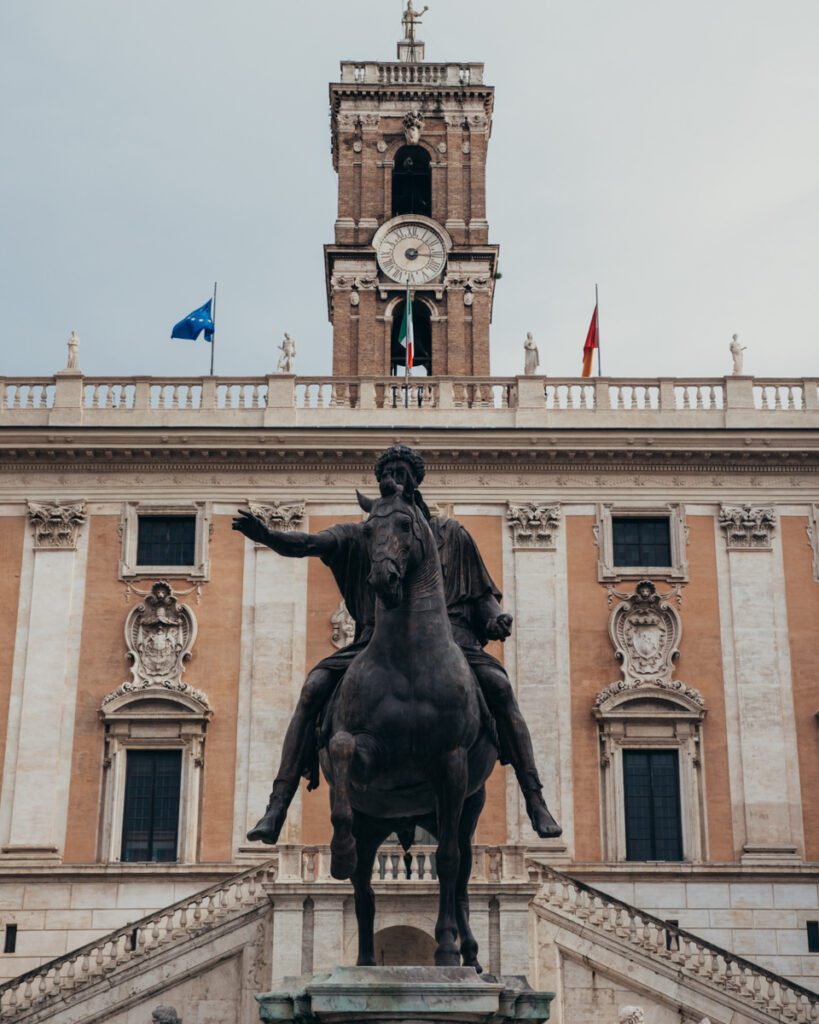
Around the piazza, you’ll find three palaces that now house museums. The Capitoline Museums – the Palazzo Senatorio, Palazzo dei Conservatori, and Palazzo Nuovo, offer an extensive range of art and artifacts. You can discover classical sculptures, ancient artifacts, and Renaissance art, as well as works of art by Caravaggio, Rubens, and Tiziano. You can even sneak a peek through the doors and see some of the impressive statues there.
If you want to visit the museums, give yourself a good 1.5-2 hours, depending on how deep you want to get into it. However, if you’re just there to admire the Piazza and take in the views, 30 minutes will be ample time.
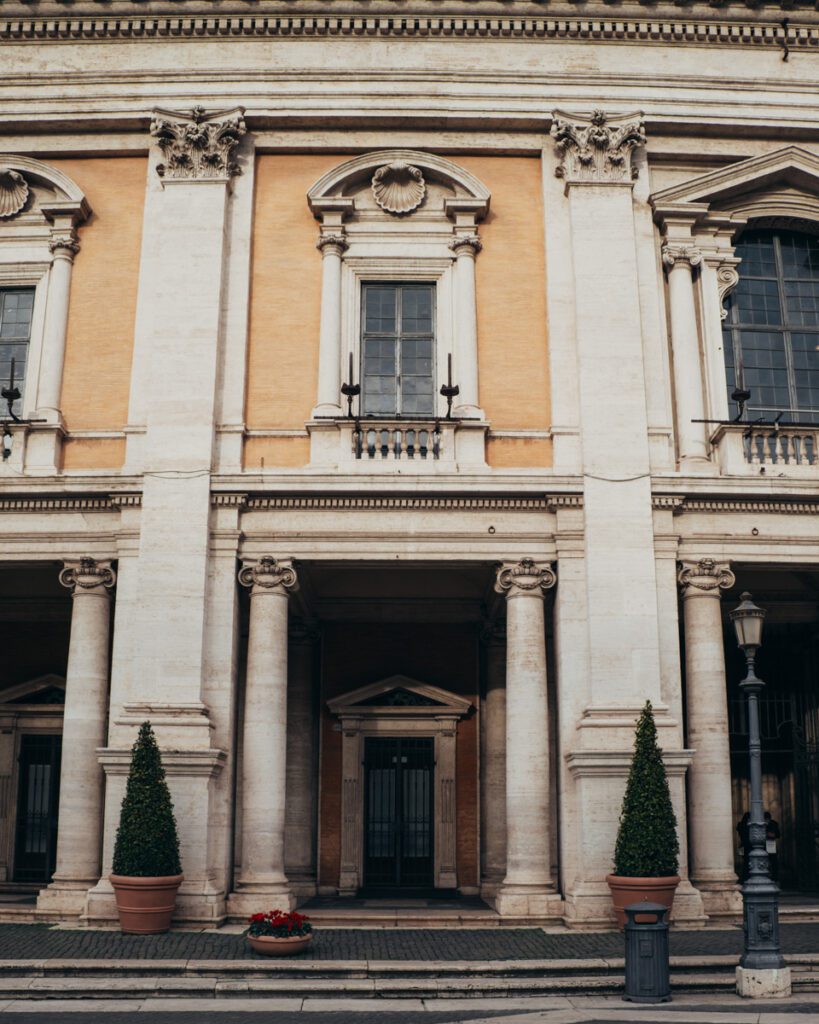
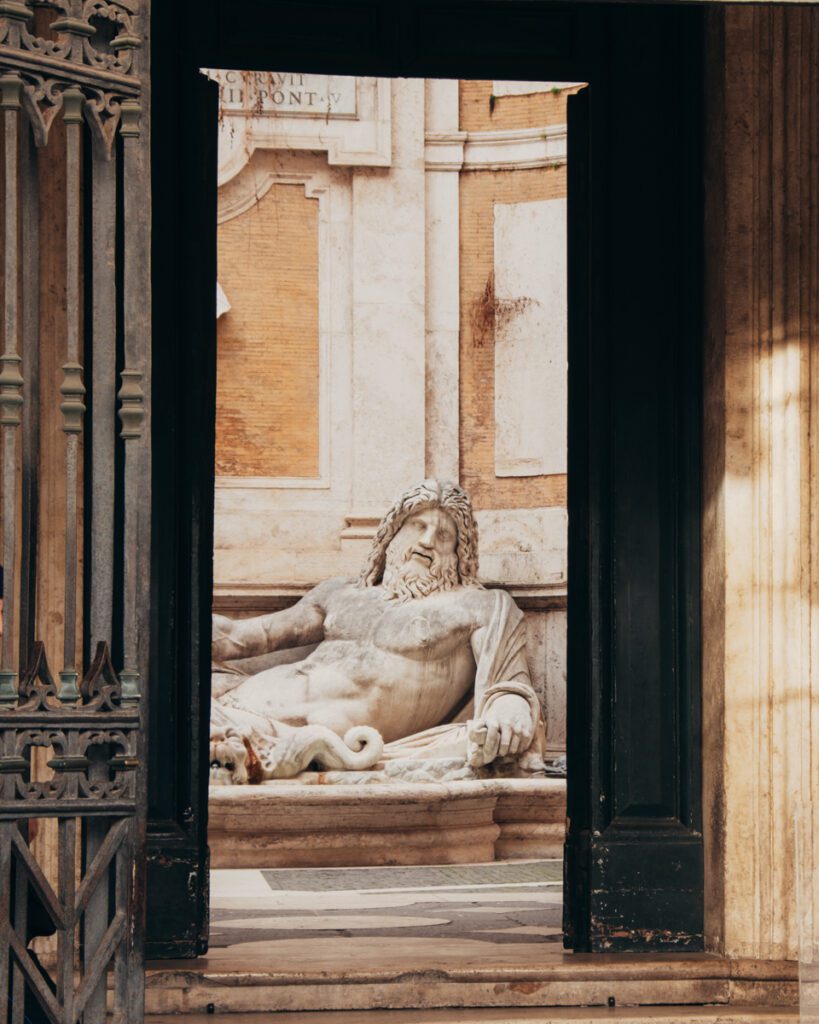
Tips for visiting Capitoline Hill during your 3-day Rome Itinerary
In the winter, the piazza is decorated with lights and decorations, giving it a really beautiful Christmas feel. Well worth climbing up the stairs to take in the view here.
Speaking of views, if you walk past the Piazza, you’ll come across the Cordonata staircase or the Tabularium hill. Here, you have amazing views of the Roman Forum, Colosseum, and beyond. You can also hear the street performers from Via dei Fori Imperiali, which gives the whole place a magical feel.
If you plan on visiting the Borghese Gallery, we would recommend skipping the museums here. The collection at the Borghese Gallery is far more extensive and impressive. If you’re tight on time, pass through the Hill, but take your time at the Borghese Gallery & gardens.
INFORMATION ABOUT CAPITOLINE HILL
Official Site (for the museums)
Name in Italian: Campidoglio
Opening hours: The Piazza is always open. The museum hours are: Everyday 9:30 am to 7:30 pm. Last admission one hour before closing time. Closed on May 1st and December 25th. Some hours vary on special Holidays.
Ticket price: Free to walk the Piazza. Museum tickets vary from €11 to €26.50, depending on what you want to see
Location: Check here on Google Maps.
How long to spend: You can walk the piazza in 20-30 minutes, but if you want visit the museums, take 1.5-2 hours here.
6. Vatican Museums & Sistine Chapel, a must during your 3 days in Rome
The Vatican is a country city within Rome. If this is your first time in Rome, it’s an absolute must! The imposing piazza in front of it is always busy and swarming with crowds. And there’s always a line to get into the museums and basilica, for so many reasons.
The Vatican Museums are the world’s largest museums. They’re home to one of the world’s most extensive and impressive art collections with over 70,000 pieces. You can trace the origins of the museums back to the 16th century when Pope Julius II founded the Vatican Library. This collection holds treasures that span centuries and redefine artistic mastery. You could spend a whole day here admiring these works of art.
As for the Sistine Chapel… well, it speaks for itself. Located within the Vatican Museums, it’s renowned for Michelangelo’s breathtaking frescoes on its ceiling, including the iconic depiction of the Creation of Adam. Fun fact about the creation of this fresco – it took Michelangelo four years to paint it… while lying down on his back! However, there are plenty of other frescos to admire along the museum walls and ceilings too. Soak it all in! We have plenty of other fun and interesting facts that you can read in our article here.
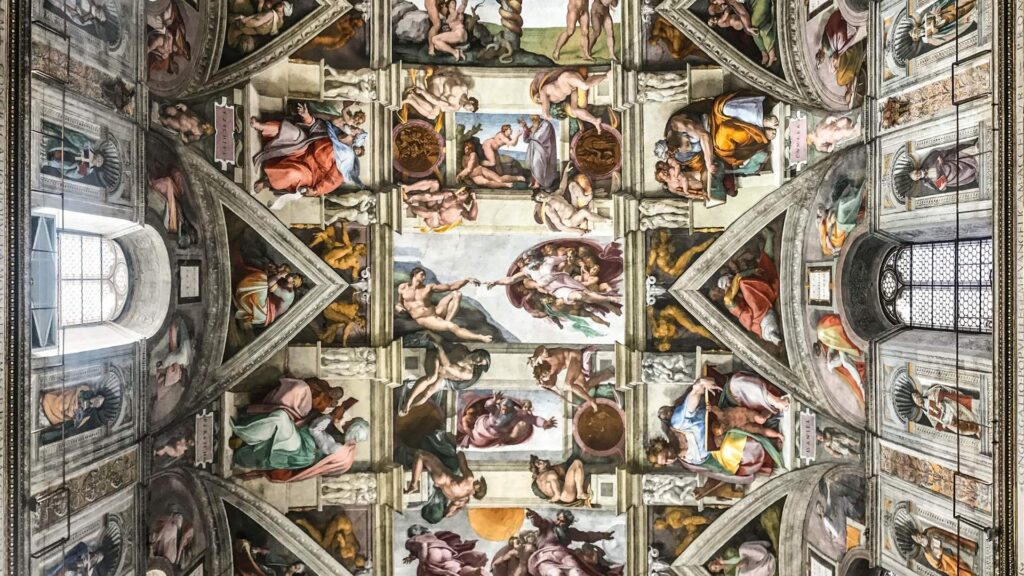
Tips to visit the Vatican Museums and the Sistine Chapel, top landmarks in Rome
Ok, just so you’re aware – there are always going to be people at this landmark in Rome. No matter when you go – regardless of the time of the day or time of the year. It’s to be expected! But if you want to increase your chances of having relative peace, here are a few tips to make the best out of your 3 days in Rome.
Arrive before 10 am to beat the crowds at the Vatican Museums. Most tour buses arrive after this time, so having calm will be a challenge. The shoulder seasons, in the fall & spring, are good times to visit, as the crowds haven’t come yet. Plus the weather is lovely, and the lines are manageable.
Also, avoid visiting on Mondays or over the weekend. As you can imagine, most sites will be busy on weekends with locals and tourists flocking in. As for Mondays, most of the other museums in Rome are closed on Mondays, so the Vatican becomes a lot more popular.

Another way to beat the lines is to go on a guided tour. However, you’ll still have crowds around you, depending on when you choose to go. Another perk of the guided tours is that they will take you through the shortcut from the museums to St Peter’s Basilica.
If you’re visiting on your own, there are 2 entrances to the Vatican Museums. If you want to start by visiting St. Peter’s Basilica, we recommend entering from Via Della Conciliazione. But if you plan on visiting the museums first, enter from Viale Vaticano.
INFORMATION ABOUT THE VATICAN MUSEUMS
Official Site
Name in Italian: Musei Vaticani
Opening hours: From Monday to Saturday: 8 am to 7 pm. Final entry is at 5 pm. From March 1st, on Fridays & Saturdays: extended opening hours until 8 pm. Final entry is at 6 pm. Free entry on the last Sunday of each month. There are also closures on special Holidays.
Ticket price: €20 for the Vatican Museums. Other options are available depending on what you want to visit. Book tickets here
Location: Check here on Google Maps. On Viale Vaticano, you will find the entrance to the Vatican Museums on your left.
How long to spend: If you want to visit the museums on a self-guided tour, you’ll need a good 2-3 hours. Guided tours may take a bit longer, closer to 3 hours.
7. St. Peter’s Basilica, an iconic landmark to visit during your 3 days in Rome
Welcome to another one of Michelangelo’s masterpieces – Saint Peter’s Basilica and the Pietra sculpture. This is one of the largest churches and the tallest dome in the world and is often frequented by pilgrims on their journey. It’s also one of the most notable landmarks in the city, and a definite must when you visit Rome for 3 days.
But we can’t credit Michelangelo for all the beauty in the Basilica. After all, the construction of St. Peter’s Basilica spanned over 120 years, from the early 16th to the 17th century. It involved several architects and artists, but it was mainly the work of Michelangelo, Bramante, and Bernini. Each artist contributed something different to its design.
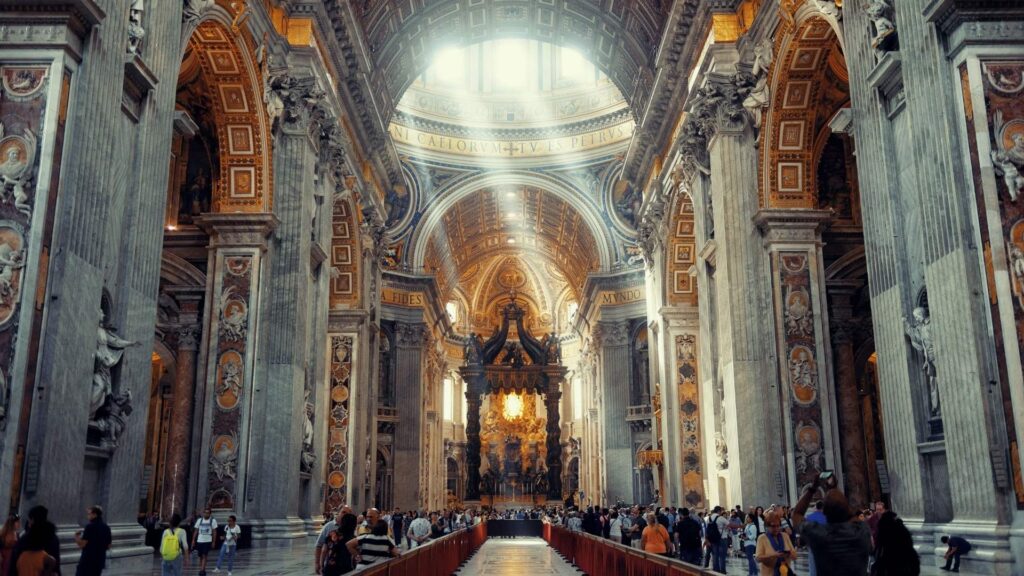
When walking into the Basilica, get ready to have your socks knocked off! Not only is the sheer size of the church impressive, but its beauty is unparalleled. Intricately designed artwork, marble, gold, sculptures, frescos. You name it, it has it! No wonder it’s such an important part of Rome’s history (and present). And a fun little fact for you – some of the stones used to build the basilica were actually taken from the Colosseum!
If you want to be even more impressed, make sure you climb up to the cupola (dome) of the Basilica. This might be the most beautiful view you’ll get of the city during your 3-day itinerary in Rome. You can also visit the Vatican Necropolis, the final resting place of several popes, including St. Peter himself (supposedly)!
The whole visit of the cupola and the church will probably take between 2-3 hours, depending on how you get up to the dome, and how long it takes to pick your jaw off the floor! Rest assured, even for those who don’t have strong religious beliefs, this church is a stunning place to discover.
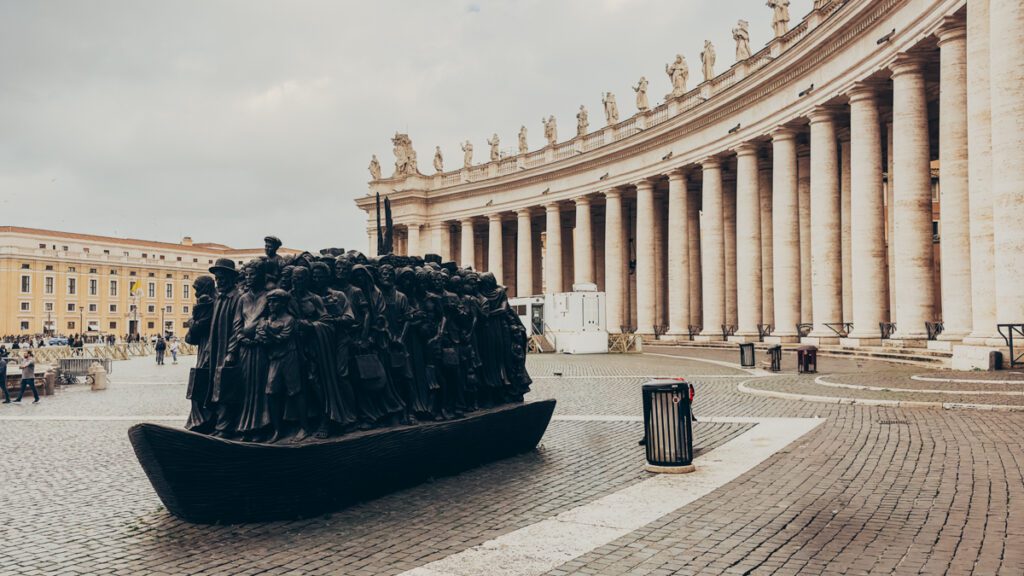
Tips for visiting St Peter’s Basilica on your 3-day Rome itinerary
Again, your best bet to avoid the crowds is to get here as early as possible. But again, if you don’t want to get up early every day, that’s ok too! You can easily book a ‘skip-the-line’ ticket and get in without having to wait in the scorching sun (especially if you’re visiting Rome in the summer).
As for the right days to visit Saint Peter’s Basilica, just know that on Wednesdays (when the Pope is in town) he holds an audience with the public (yes, you can attend this for free). During those days, St. Peter’s Basilica doesn’t open until the early afternoon. We already mentioned how the Vatican Museums is one of the only museums open on Mondays, so we would recommend avoiding the Basilica on this day as well, as you’ll have larger museum crowds trickling into the church as well.
If you want a truly unique and unforgettable experience, you can book tickets to attend the papal audience (free). The audience takes place every Wednesday at 9 am when the Pope is in Rome. The doors open at 7:30 am. During this Audience, the Pope shares small teachings and readings, mainly in Italian, but also in English, French, and other languages depending on the visiting groups.
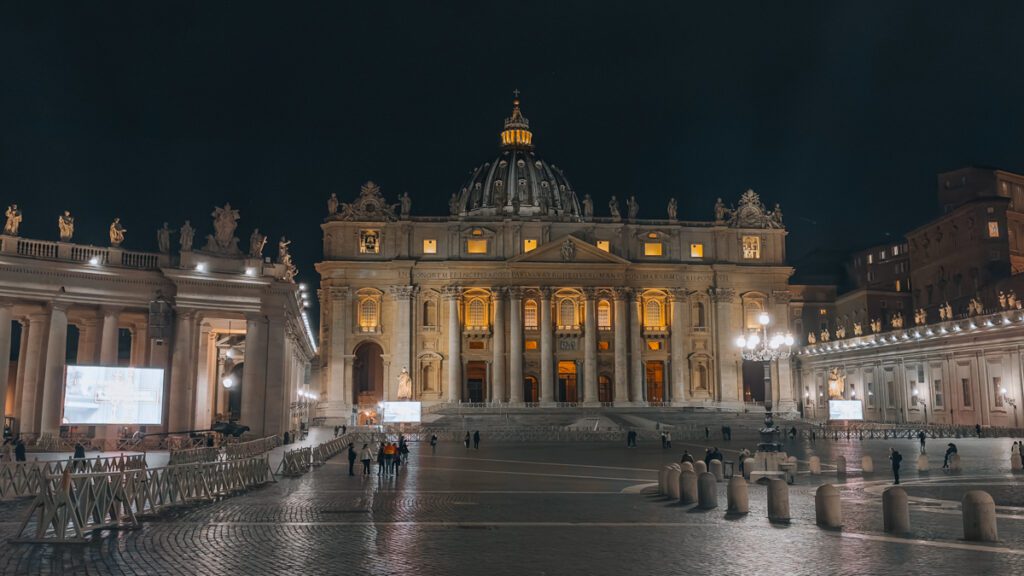
You can also see the Pope on Sundays when he is in town. He holds a ceremony at noon, where he appears from the window of his apartment. From there, he gives a short speech followed by the Angelus. The ceremony ends with a blessing. No tickets are needed for this ceremony – it happens outside, in the main square in front of the Vatican. Keep that in mind if you want to visit the Basilica or the museum, as there will be a lot of people.
Once you get into the Basilica, climb the dome first. Even before you explore the rest. This will allow you to avoid the mid-day heat and the long lines. To get to the top of the dome, you can either climb the 500+ steps or take a lift to the terrace and climb the remaining 300+ steps.
Also, if you want to witness something truly unique, every 25 years, a special door is unbricked and opened by the Pope himself. It symbolizes a fresh start for the faithful. The next opening is in 2025! If you’re planning on visiting Rome during that time, make sure to look into this!
Booking.comINFORMATION ABOUT THE SAINT PETER’S BASILICA
Official Site
Name in Italian: Basilica di San Pietro
Opening hours: Open daily from 7 am to 7:10 pm. The dome opens at 7:30 am and closes at 6 pm. Note that there is mass conducted daily. Check the official site for hours and special holidays.
Ticket price: The Basilica is free to visit. The cost for the dome: Lift to the terrace – €8, climbing all 500+ steps by foot – €6
Location: Check here on Google Maps.
Transport: Metro line A, Ottaviano stop. For the bus, check the instructions here.
How long to spend: You’ll need a good 2-3 hours here.
8. Trevi Fountain, a popular attraction to visit during your 3-day itinerary in Rome
Ok, we’ll be honest with you – yes, the Trevi Fountain is beautiful and merits a stop here on your 3-day Rome itinerary. BUT – it’s extremely popular and crowded. We would recommend you stop here for a quick look (and to guarantee your return), but nothing more. The only way to avoid crowds here is to come at the crack of dawn!
A bit of history for you about the Trevi Fountain – it’s a Baroque masterpiece located in the heart of Rome. This iconic monument is known for its grandeur and intricate sculptures. It’s one of the most famous fountains in the world. It was designed by architect Nicola Salvi and completed by Pietro Bracci.
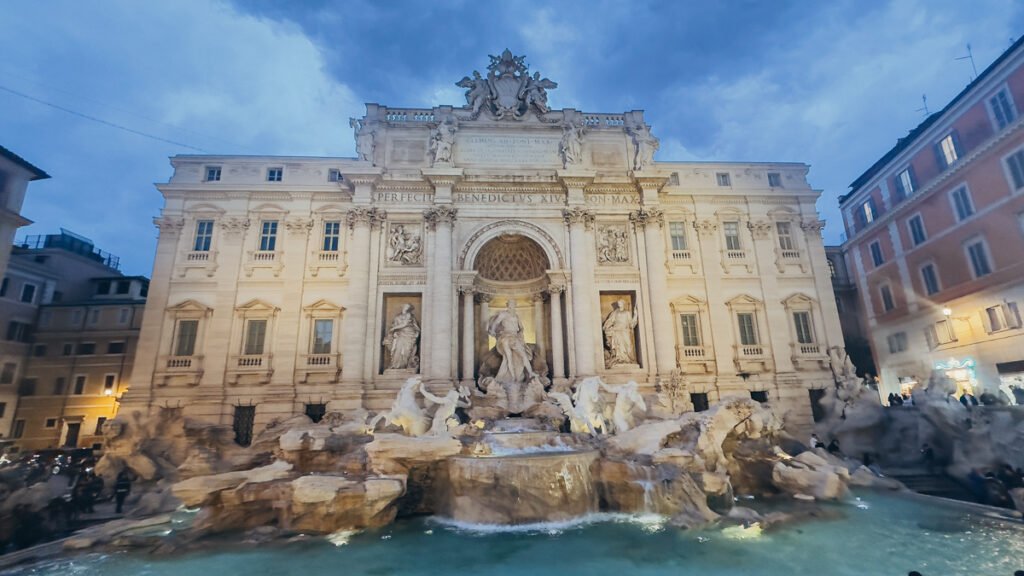
The reason the Trevi Fountain is so unique is because it marks the endpoint of the ancient Aqua Virgo aqueduct. This aqueduct was built in 19 BC, and it supplied water to ancient Rome back in the day. Today, there are over 800 gallons of water flowing every second through the fountain. Insane!
As for the tradition that goes with the Trevi Fountain, it says that you have to toss a coin with your right hand, over your left shoulder while your back is turned to the fountain. Legend says it guarantees a return to Rome! Even if you don’t come back, it’s ok, because the coin you toss will go to a good cause. Over €3,000 are collected daily from the Fountain. They help fund social programs and are donated to local charities.
Tips for visiting the Trevi Fountain
As we mentioned, the Trevi Fountain is extremely busy. If you want to catch it with the least amount of crowds, get there as early as possible. We were not kidding when we said go at the crack of dawn. Obviously, you have better chances of avoiding crowds if you visit in the off-season (spring & fall) or on weekdays.
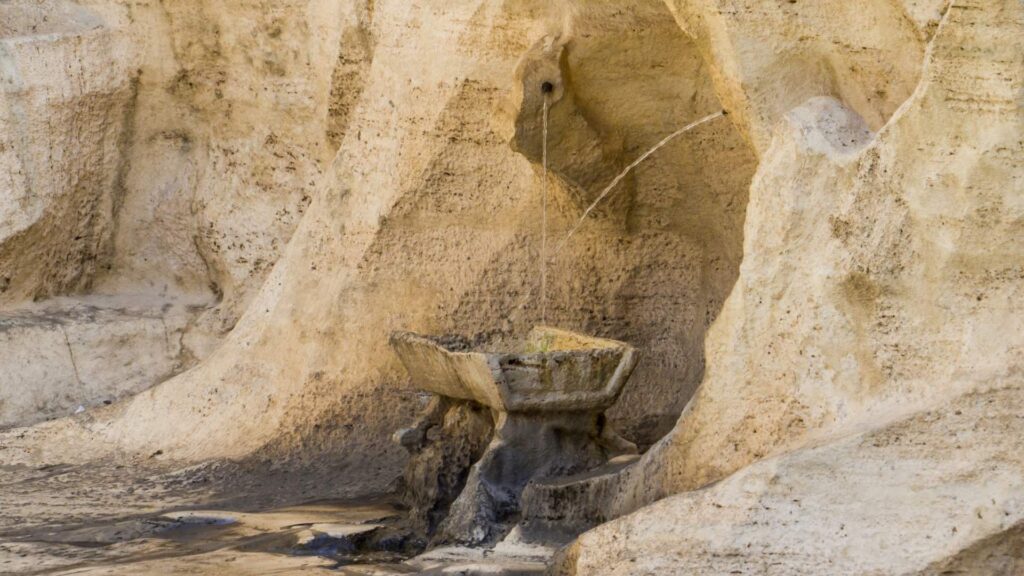
If you want to partake in a different tradition, you can drink from the Lovers’ Fountain. There’s a small rectangular basin to the right, away from the fountain. It has two small spouts: this is the Fountain of Lovers. Legend says that couples who drink from this fountain together will stay in love forever and be eternally loyal.
You can also avoid the crowds by coming later at night. But regardless of when you visit, be careful with your belongings. In tight crowds like at the Trevi Fountain, there will be plenty of pickpockets. It’s easy to get distracted and not feel when someone is trying to steal from you.
Also, watch out for tourist trap restaurants. Whenever you’re close to these Roman landmarks, you’ll have plenty of restaurants that offer sub-par food at crazy prices.
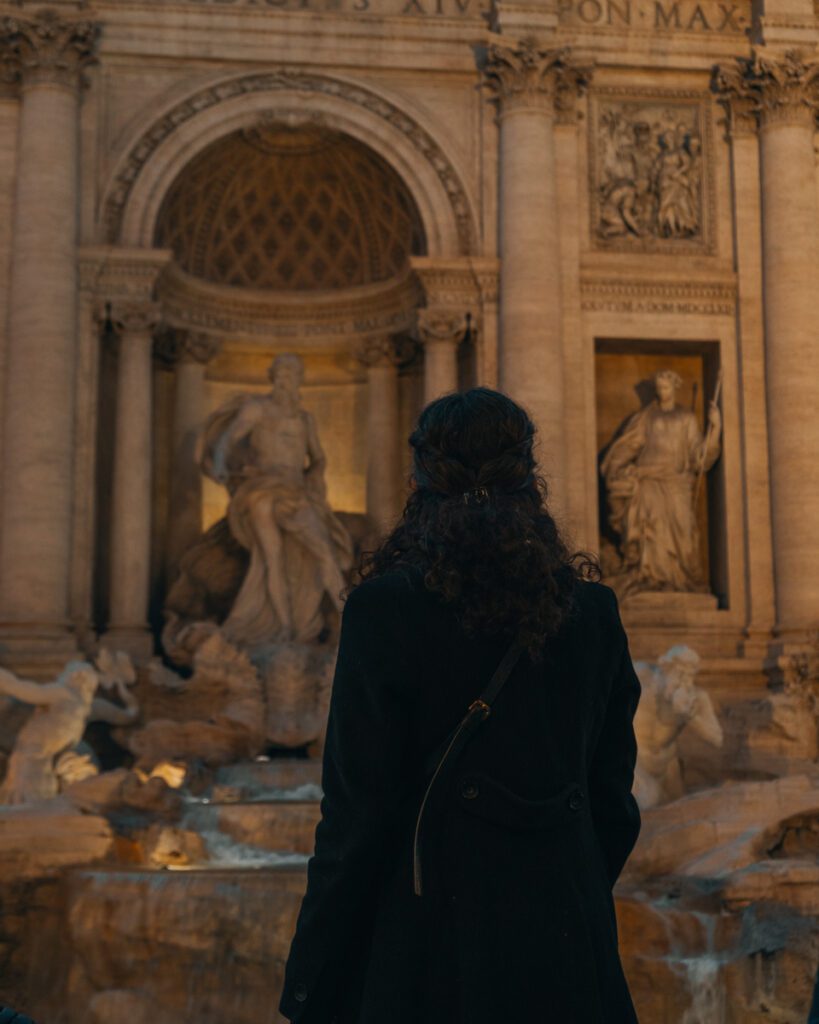
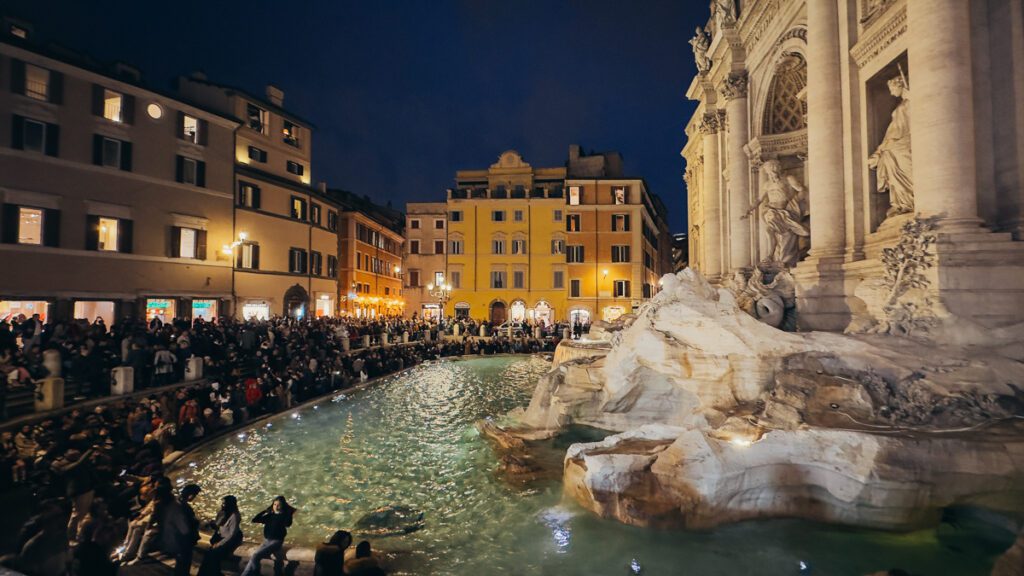
Finally, if you want to visit another beautiful landmark that is often overlooked, walk a few steps away from the Trevi Fountain, and head to the Galleria Sciarra (located here on Google Maps). It’s an elegant palace atrium that has lavish frescoes and a glass roof. It dates back to the late 19th century. It’s one of these little hidden gems in Rome that’s well worth discovering.
INFORMATION ABOUT THE TREVI FOUNTAIN
Official Site
Name in Italian: Fontana di Trevi
Opening hours: Open 24-7
Ticket price: There are no tickets required to visit this site. But you can visit it on a guided tour.
Location: Check here on Google Maps.
How long to spend: You’ll need about 15-30 minutes here, depending on when you go and what you’re looking to do.
9. Pantheon, one of the best things to do in Rome in 3 days
We joked during our time in Rome that there’s history and beauty around every corner. The Pantheon is no different. It’s one of the most unique marvels of Ancient Rome that still stands today. It’s a perfectly proportioned dome with an oculus (an opening at the top) that allows natural light to light up the interior.
The dome of the Pantheon is the largest unreinforced concrete dome in the world – it has an impressive diameter of 43.3 meters (142 feet). The Pantheon was built by Emperor Hadrian in 126 AD as a temple that was dedicated to all the gods.
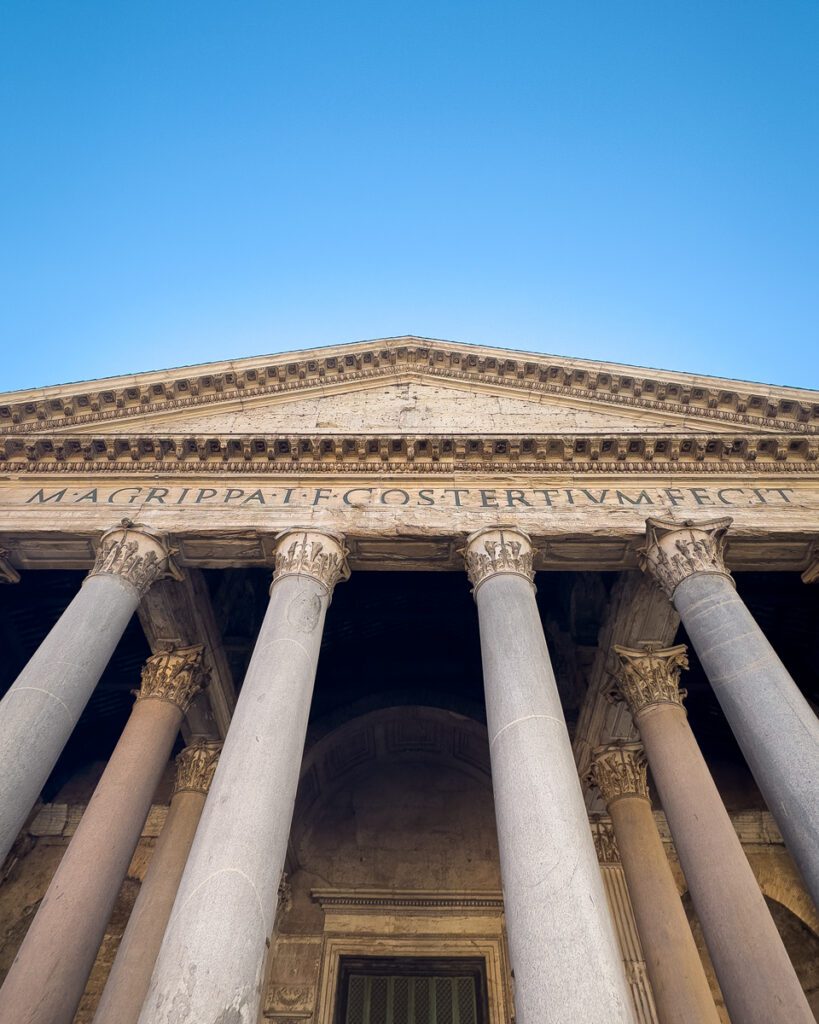
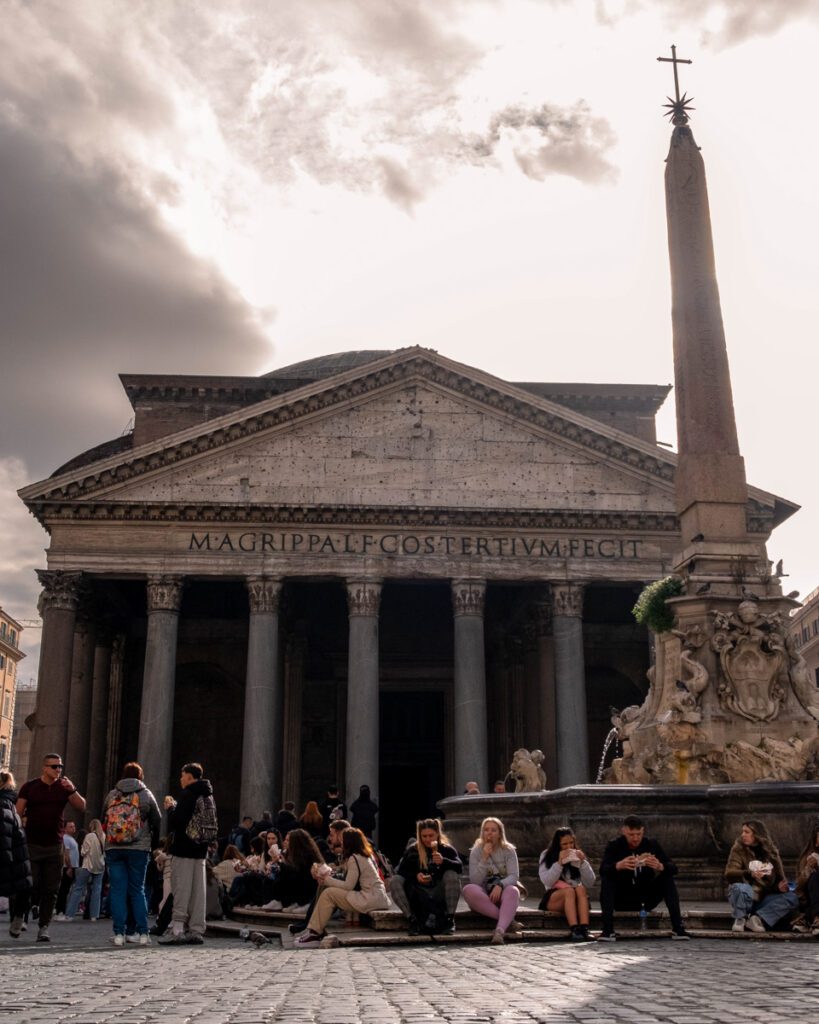
Of course, you can visit the Pantheon by walking around it, and admiring from the Piazza across it, or you can take a look inside. If this is your first trip to Rome, we highly recommend going inside. It’s quite impressive to see.
Back in the day, the Pantheon was used to worship the gods. Today, apart from being one of the most popular landmarks in Rome, it’s also the burial place of important Italian figures. You can find the graves of Vittorio Emanuele II (the first king of Italy, the same one from the Altar of the Fatherland) and artists like Raphael. It’s also now a practicing church called Santa Maria ad Martyres. Religious ceremonies are held here.
Tips for visiting the Pantheon during your first trip to Rome
Gone are the days of visiting the Pantheon for free. Today, you’ll need to pay €5 to get in. We recommend purchasing your tickets ahead of time by visiting this site and following this procedure. You can also buy your tickets at the door, but depending on when you go, there might be a long line to wait.
If you want to visit the Pantheon without the crowds, head there as early as possible close to opening, or around closing. If you don’t have your tickets, you want to head there before the ticket office on site closes, which is at 6 pm. You can also admire the Pantheon at night when it’s closed but illuminated from the outside.
For a very special experience, go on the Spring and Autumn equinoxes. The sunlight shines through the oculus (the hole in the roof), and it illuminates a specific spot on the floor.
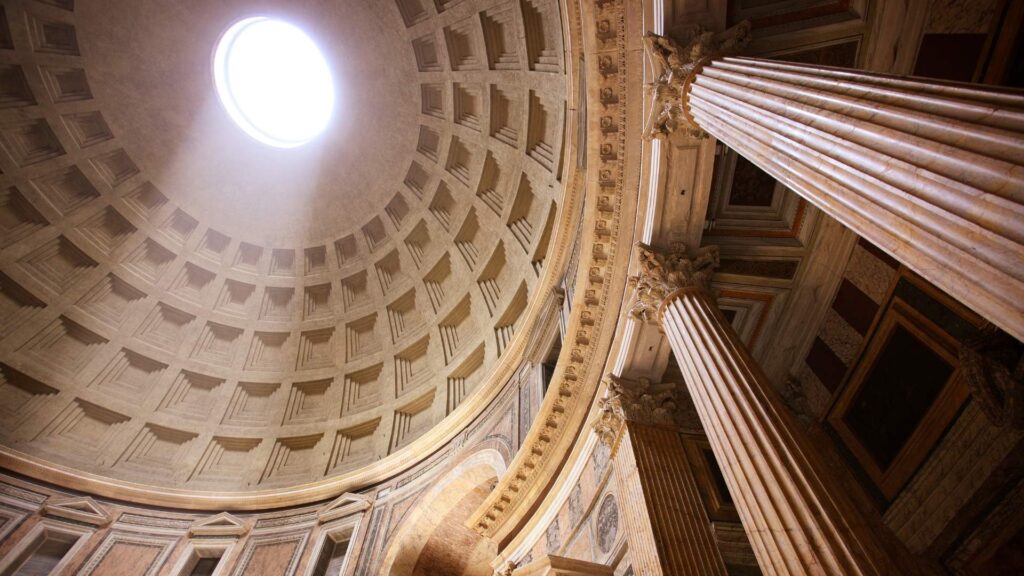
If you have already visited the Pantheon, you can simply enjoy the busking that’s taking place in the Piazza della Rotonda across from it, or hang out at one of the cafés and restaurants around it. Again, just check prices and reviews before heading in so you don’t get completely ripped off! Also, watch out for pickpockets and scammers here.
If you’re looking for a delicious restaurant around the Pantheon, head to Pasta e Vino – Palombella. They make delicious homemade pasta here. If you’re looking for a more lively atmosphere, you have Miscellena right next door, a family-run restaurant full of locals & regulars.
INFORMATION ABOUT THE PANTHEON
Official Site
Name in Italian: Pantheon
Opening hours: Open every day, from 7 am to 7 pm. The last entrance is at 6:30 pm. The ticket offices on site close one hour before the monument.
Ticket price: €5 for foreigners. €2 for EU citizens. Free for anyone under 18,
Location: Check here on Google Maps.
How long to spend: You’ll need about 30-45 minutes here, depending on when you go and what you’re looking to do.
10. Spanish Steps, one of the best things to do in Rome
Another iconic location that’s a must-see during your 3 days in Rome are the Spanish Steps. This iconic location is made of a cascading waterfall of 135 white travertine steps. At the bottom, you have the Piazza di Spagna and at the top, the Trinità dei Monti church. And best of all, considering it’s in one of the most luxurious neighborhoods in Rome, it’s one of the many free things to do here.
When you get to the Piazza di Spagna, you’ll notice the Fontana della Barcaccia or the “Fountain of the Leaky Boat”. You can’t miss it – it’s at the foot of the Steps. This fountain was built to remember a bad flood of the River Tiber in 1598. The flood was so bad that a boat was left behind in Piazza di Spagna. Crazy!
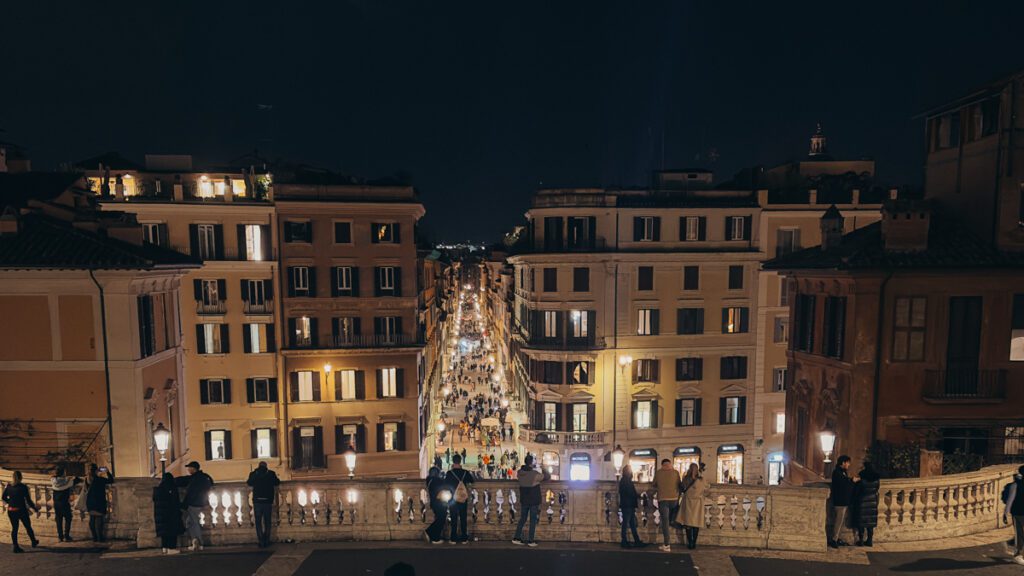
Once you start making your way up the stairs, don’t forget to turn around and take the view in. Either from the halfway point, the first terrace, or from the top of the steps of the Trinità dei Monti church.
Despite being called the Spanish Steps, these steps were funded by the French diplomat Étienne Gueffier. The Trinità dei Monti church at the top was also financed by the French. The reason they call these the Spanish Steps is because the Spanish Embassy is near the top. If you want to learn more fun facts about Rome and its landmarks, check out our article here.
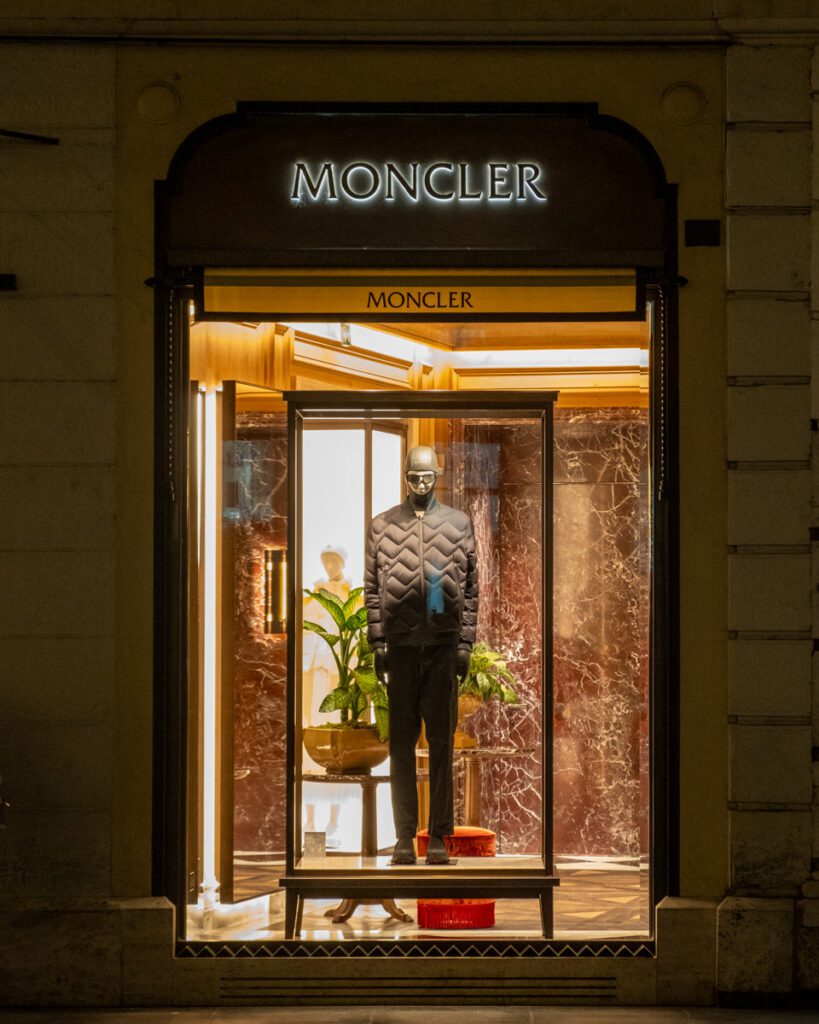
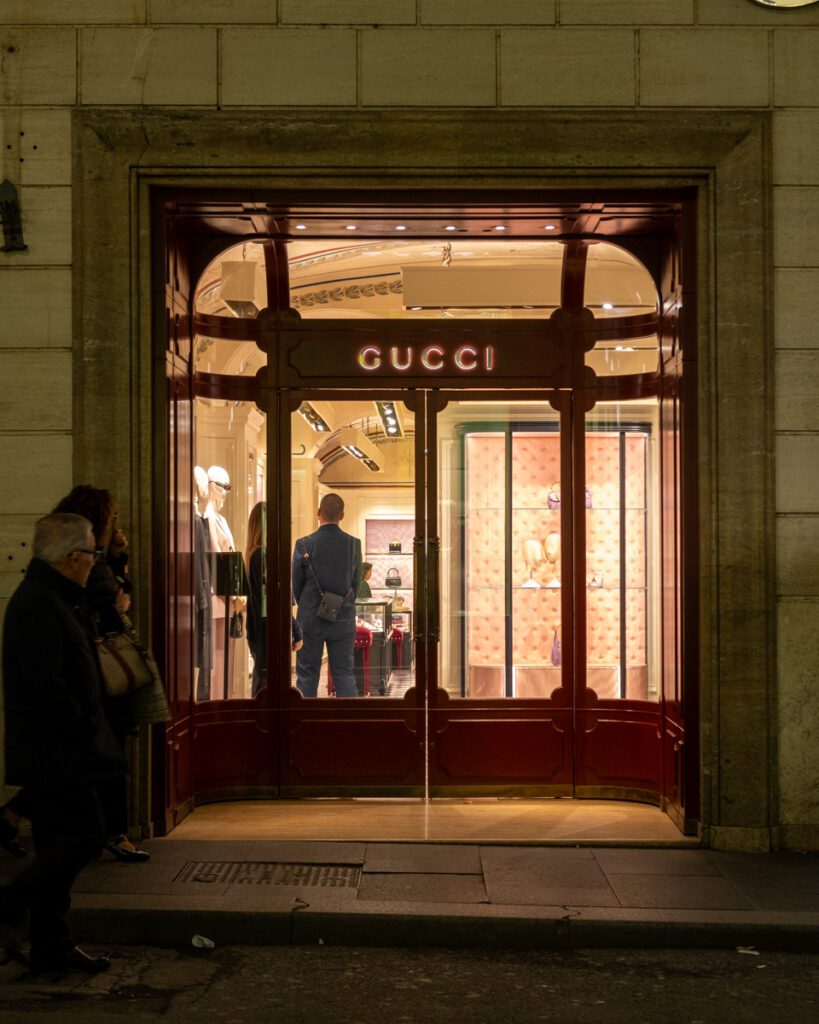
Today, you can come here for people-watching, looking at the works of arts created by the artists here, or to go shopping at the foot of the Steps. In fact, Via dei Condotti, the street that is straight down from the Spanish Steps is home to some of the most luxurious shops in Rome. For those who love to shop, this is Mecca!
Tips to enjoy the Spanish Steps
Back when we first visited Rome in 2012, we had a gelato sitting on the Spanish Steps. But those days are gone. As of 2019, you can no longer sit on the Steps. They are designated as a UNESCO Heritage Site, and you can also get fined up to €400 if you’ve dirtied or damaged the steps in any way. Save that money, and go shopping at one of the luxury stores at the foot of the Steps.
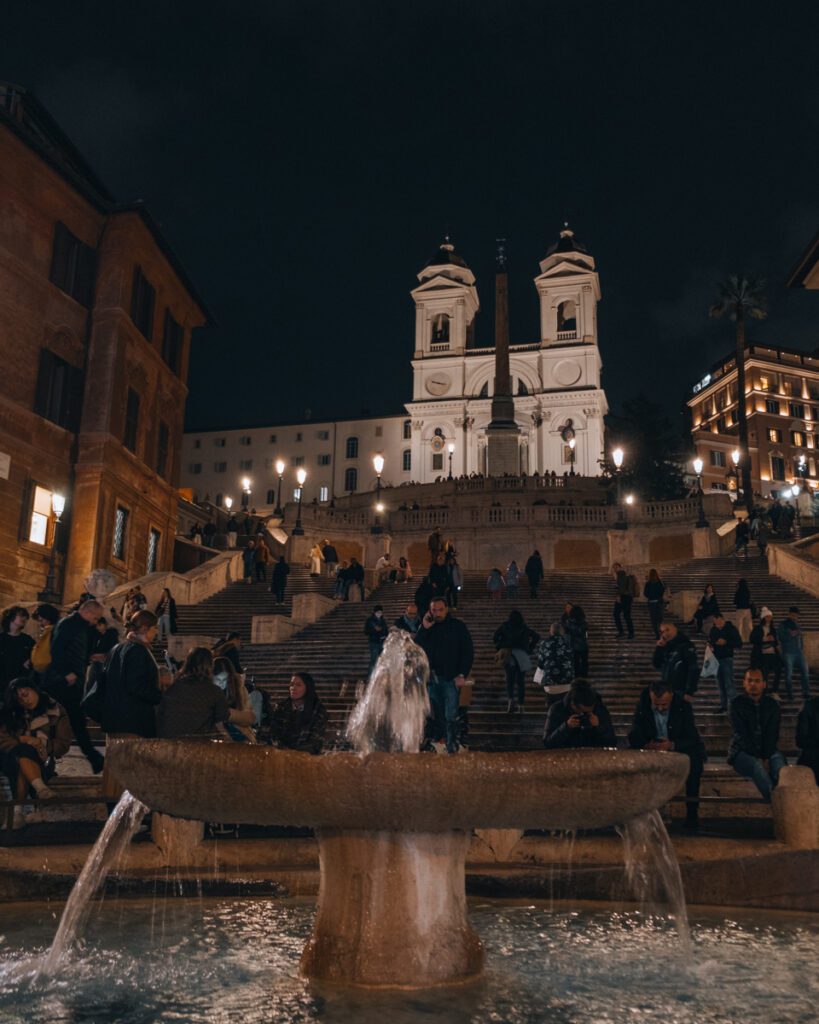
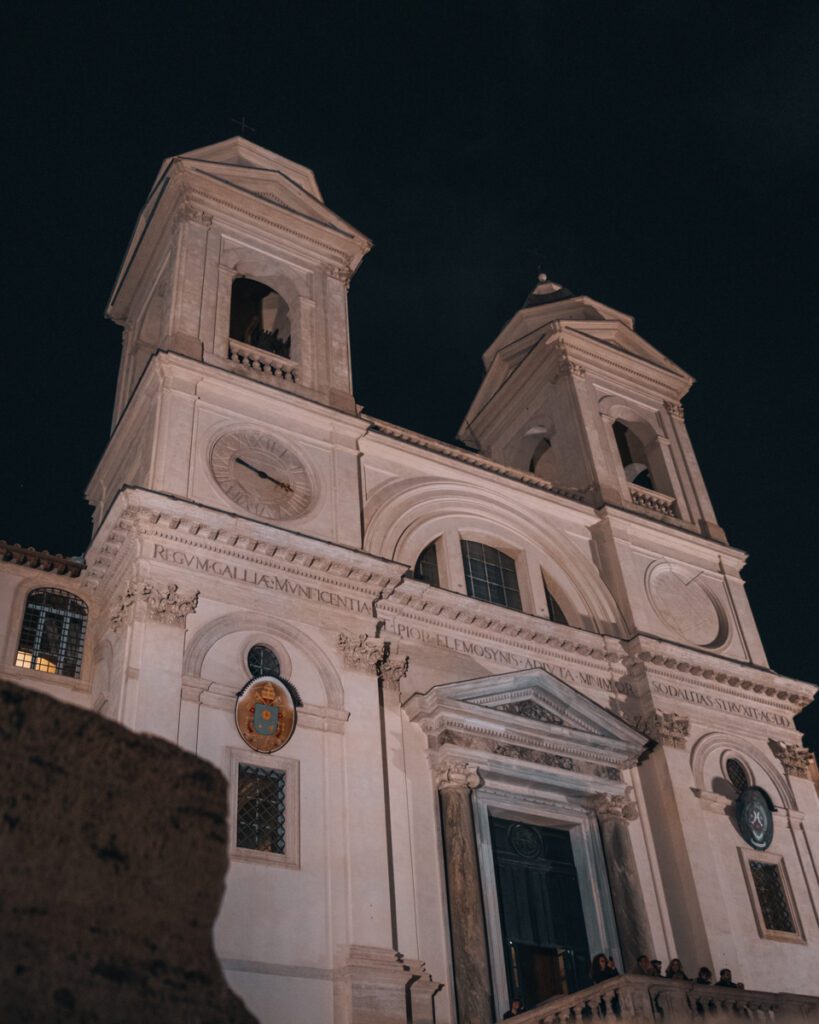
If you want to enjoy the steps with the fewest amount of people, come as early as you can. You can also come for sunset to enjoy the view from the top of the Steps. Head over to one of the trendy bars or cafés that are along the Steps, sit on their terrace and enjoy the view.
To get a special view of the Spanish Steps, try to visit in the Spring – not only are there fewer crowds, but you can also see the azaleas bloom. This creates a colorful and scenic backdrop.
INFORMATION ABOUT THE SPANISH STEPS
No official site
Name in Italian: Scalinata di Trinità dei Monti
Opening hours: Open every day, 24-7
Location: Check here on Google Maps.
Transport: Metro Line A. Spagna Stop
How long to spend: You’ll need about 30-45 minutes here. Take a hike up the steps, visit the church and enjoy the view
11. Piazza Navona, visit this top attraction in Rome on your 3-day itinerary
Piazza Navona is one of the most iconic squares in Rome’s Centro Storico (the historic center of the city). It’s located on the site of the ancient Stadium of Domitian where athletic games used to take place. Today, Piazza Navona is a bustling square where you can find 3 major fountains, tons of tourists and a slew of artists.
The piazza is popular, not only because it’s beautiful, but because it’s a big intersection at the heart of the city. Here, you’ll find three stunning fountains, each telling a different story: the Moorish Fountain, the Fountain of Neptune, and the Four Rivers Fountain, created by Bernini himself. At the heart of the Piazza, you have the Church of Sant’Agnese in Agone, a collaborative masterpiece by Borromini and Bernini.
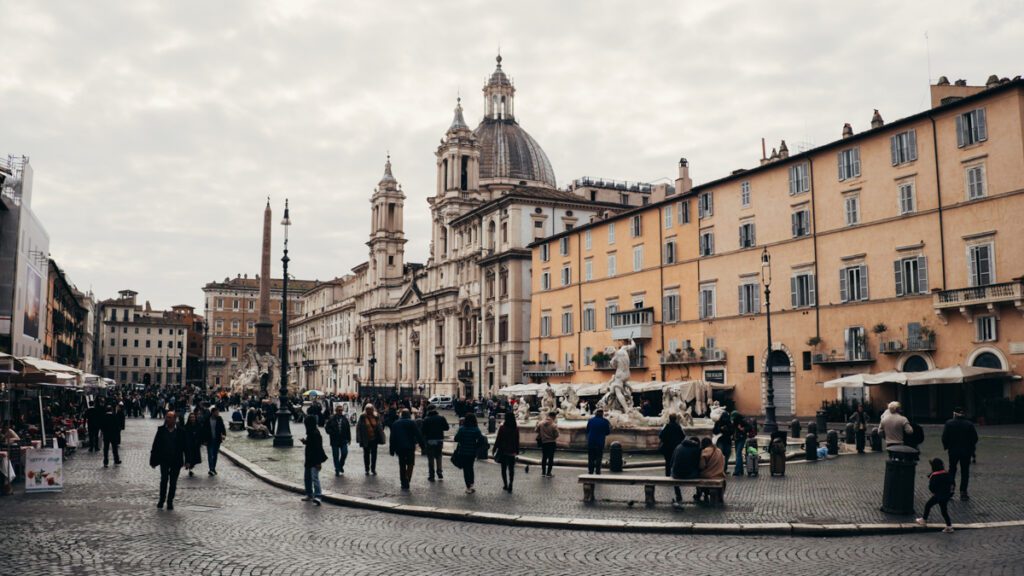
Beyond the stunning architecture, the square is lined with restaurants and cafés. It’s always important to check prices and reviews before going in as many of these are tourist traps. But if you love to people-watch like we do, grab a coffee, a glass of wine or a gelato (hopefully, that won’t break the bank), sit in the square and take it all in.
You can easily spend 30 minutes in the square if you’re strapped for time. If not, take your time, enjoy a snack, visit the church and chill out. You can easily spend 1-2 hours here.
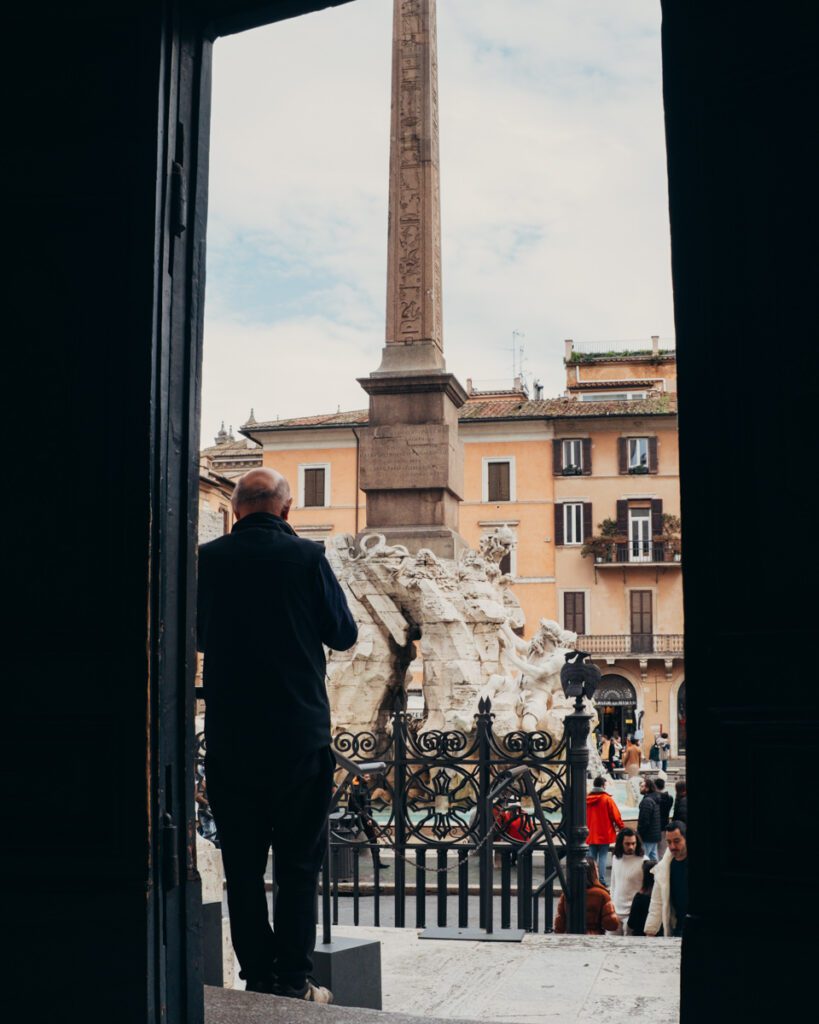
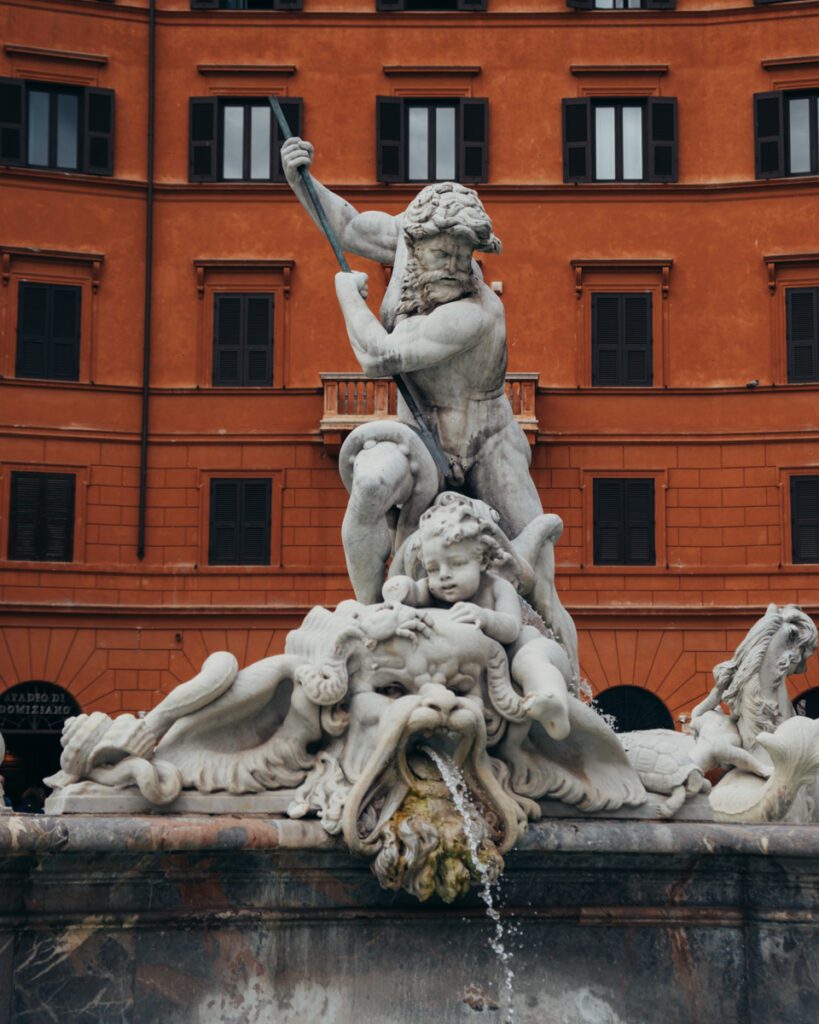
Tips for visiting Piazza Navona on your first trip to Rome
If you’re trying to visit the Piazza Navona with no one around, come early, 8-9 am. You’ll only see a few locals around. But that’s not the fun thing about this square. We recommend coming when there are people around – you’ll get a better sense of the vibe, and truly enjoy the bustling atmosphere.
We mentioned it, but the restaurants here are tourist traps. If you just want to enjoy a coffee or a glass of wine while admiring the square, we recommend picking the restaurant with the least terrible reviews. But don’t eat a meal here – there are better spots in the historic center!
INFORMATION ABOUT THE PIAZZA NAVONA
No official site
Name in Italian: Piazza Navona
Opening hours: Open every day, 24-7
Location: Check here on Google Maps.
How long to spend: You’ll need about 30-45 minutes here. Or 2 hours if you’re taking it all in (with a coffee or a glass of wine)
12. Castel Sant’Angelo, a historic attraction to add to your 3-day Rome itinerary
The Castel Sant’Angelo has a long history (like everything else in Rome). It’s a beautiful structure on the edge of the Tiber River, surrounded by impressive bridges. It’s a must-see during your 3 days in Rome.
Initially, the Castel Sant’Angelo was built as a mausoleum for Emperor Hadrian in the 2nd century AD. Later, it served so many other purposes, including being a fortress and papal residence. In fact, one of its unique features is the Passetto di Borgo. This is a fortified corridor that connects the castle to Vatican City. It served as an escape route for popes during times of danger.
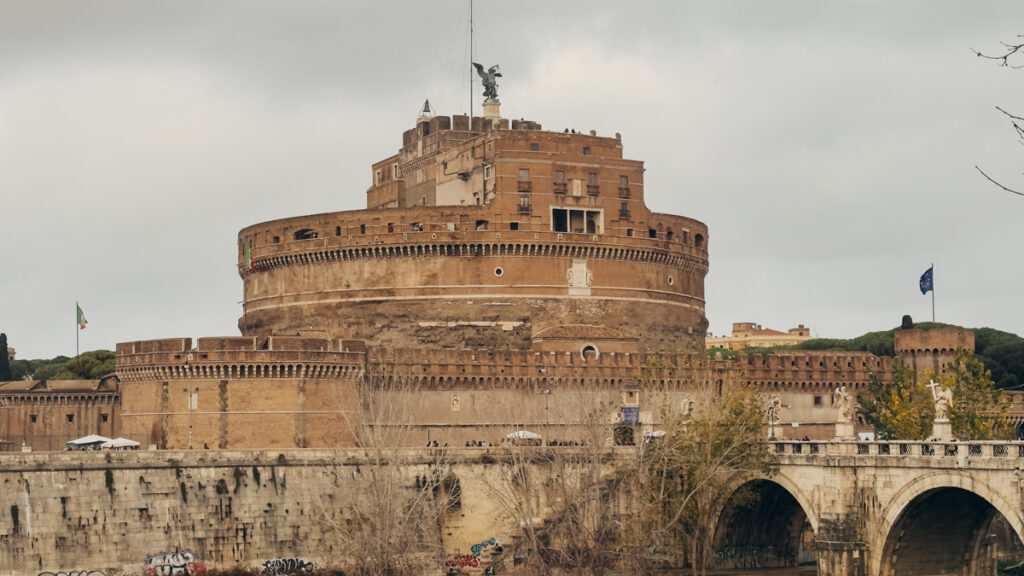
For very long, the castle played a strategic role in defending the Vatican during times of conflict. But today, Castel Sant’Angelo serves more as a museum. You can explore its history, architecture, and different collections, including some temporary exhibitions.
Another great feature of the Castel is the terrace at the top. From here, you can take in the breathtaking panoramic views of Rome and the Vatican City, along with the Tiber River.
If you want to fully take in the experience at Castel Sant’Angelo, you’ll need about 2-3 hours here. If you don’t want to spend so much time, you can still admire it from the outside. Views of it from the beautiful Sant’Angelo Bridge are just as stunning.
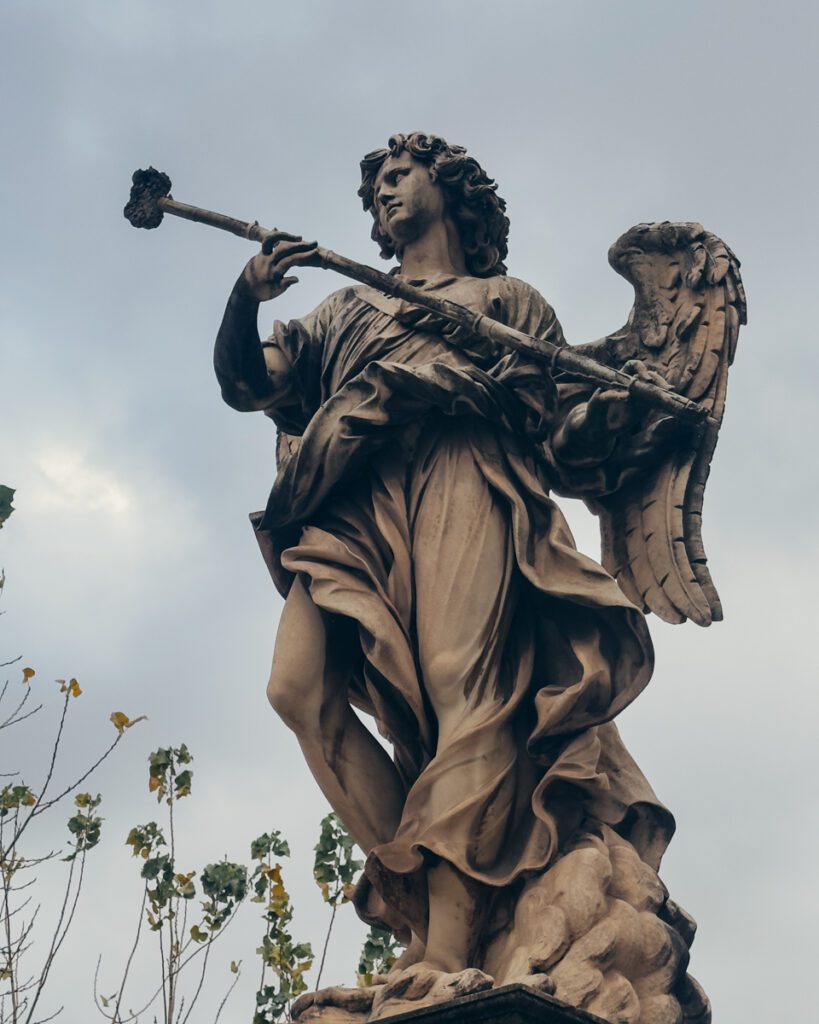
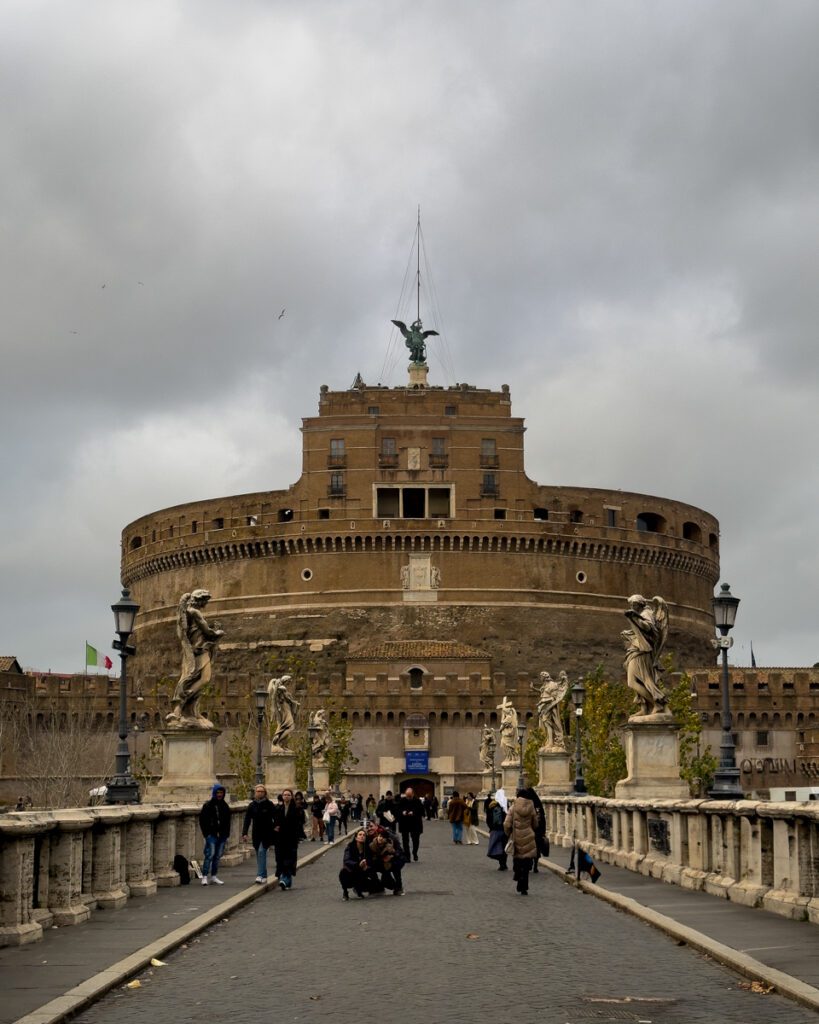
Tips for visiting Castel Sant’Angelo on your first trip to Rome
If you want to visit the museum and enjoy the views, the daytime is best. However, in the evening, you can see the castle illuminated, which gives it a unique perspective as well. If you go closer to closing time, you can catch views of the city during the sunset from the terrace.
For photography lovers, we recommend heading across the bridge, down on the path by the river. It will give you a different and beautiful perspective of the Castel. Also, take the time to admire the statues and beauty of the St. Angelo Bridge right in front of this Roman landmark.
INFORMATION ABOUT THE CASTEL SANT’ANGELO
Official site
Name in Italian: Castel Sant’Angelo
Opening hours: Open from Tuesday to Sunday, 9 am to 7:30 pm. Last entry is 6:30 pm. Closed on Mondays, December 25th and January 1st.
Ticket price: €13 full price + exhibition entry: €6.50. €2.00 reduced (European Union citizens between 18 and 25 years old) + Exhibition entry: €2.00. Free: children under 18.
Location: Check here on Google Maps.
How long to spend: You’ll need about 30-45 minutes here from the outside. You’ll need 1.5-2 hours if you visit the museum.
13. The Jewish Ghetto, an overlooked attraction in Rome
The Jewish Ghetto or Jewish Quarters of Rome are a historic place with renewed energy. You can feel the history walking through the streets of this old neighborhood.
Back in 1555, a papal decree confined Rome’s Jewish population within the narrow confines of this quarter. Walls rose, isolating them from the city’s bustling life, yet within those walls, a vibrant world blossomed. Overcrowding, poverty, and discrimination were harsh realities of this area. Yet, the community persevered.
In 1870, the walls finally crumbled creating a new-found freedom for the population here. But the fight was far from over as the people here had to endure the hunt that happened during World War II. Remnants of that time still remain, as you can find brass plaques on the street. These cobblestones mark the places where individual Holocaust victims were taken from their homes.
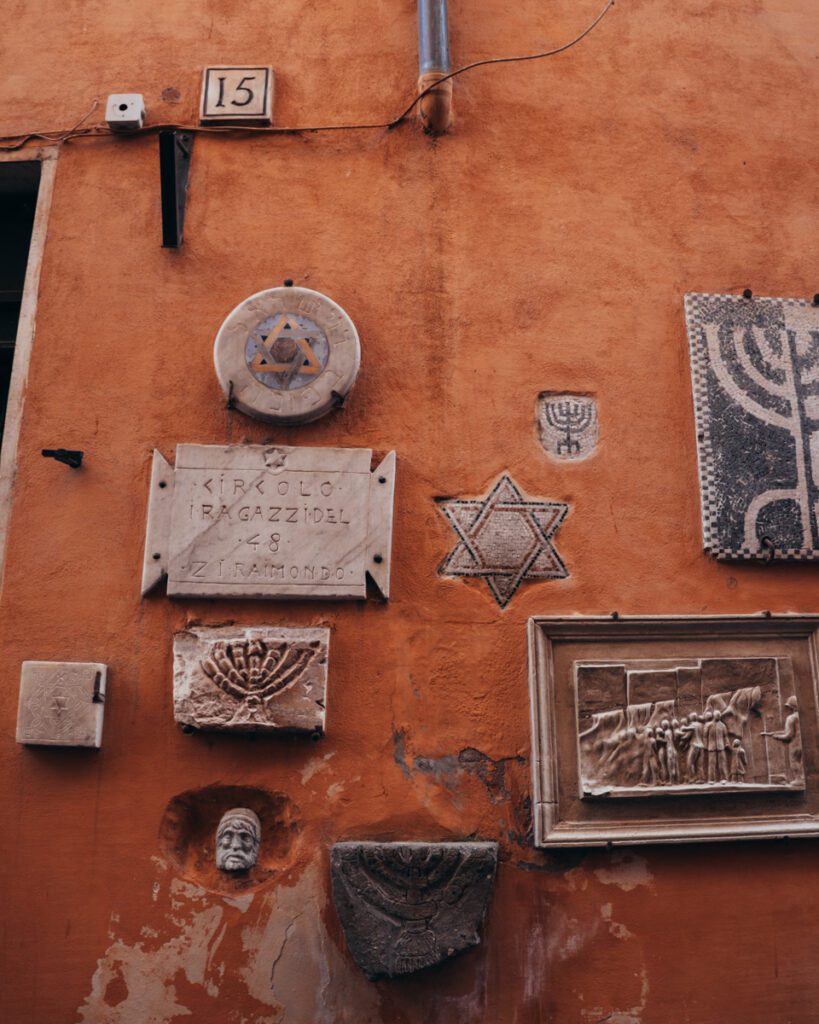
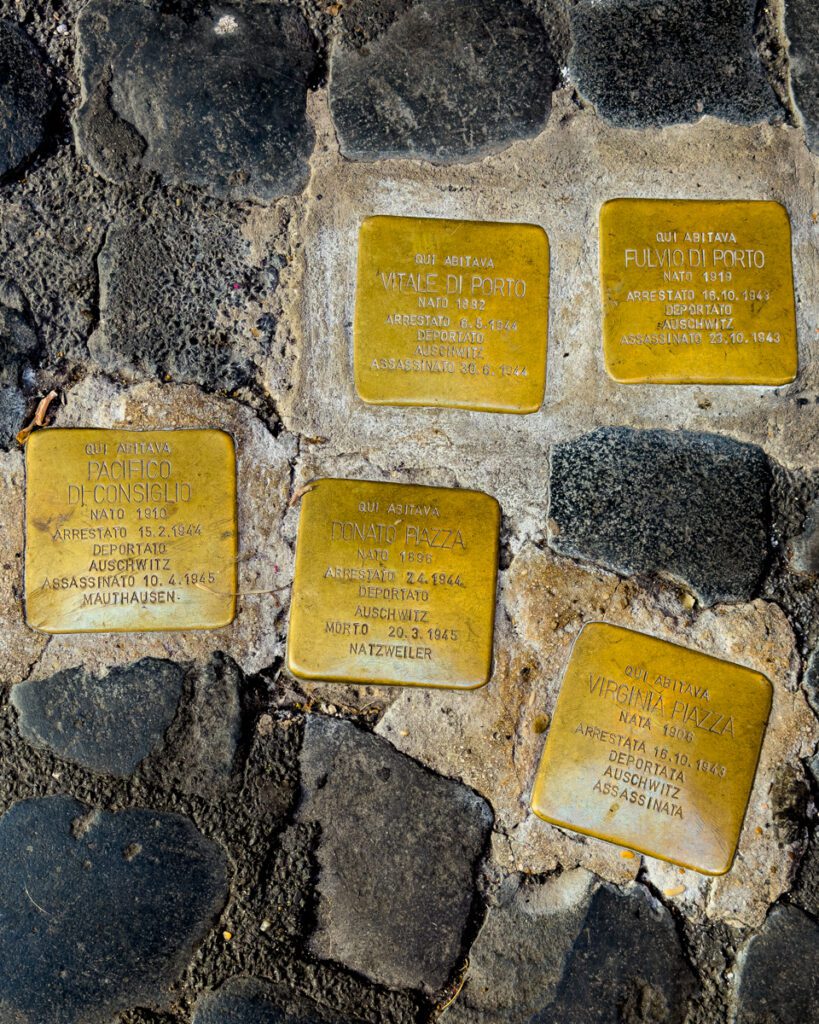
Called Pietri d’inciampo, Italian for “stumbling stone”, there are more than 200 of these mini memorials in Rome. You’ll find many of the cobbles outside doorways in the old Jewish Quarter, sometimes grouped together with one stone for each member of a family. You can read about their tragic fates on each stone.
To dig deeper into this rich heritage and culture, head to the Great Synagogue of Rome, built in the late 19th century. The Jewish Museum of Rome, located nearby, also provides insights into the history and culture of the community.
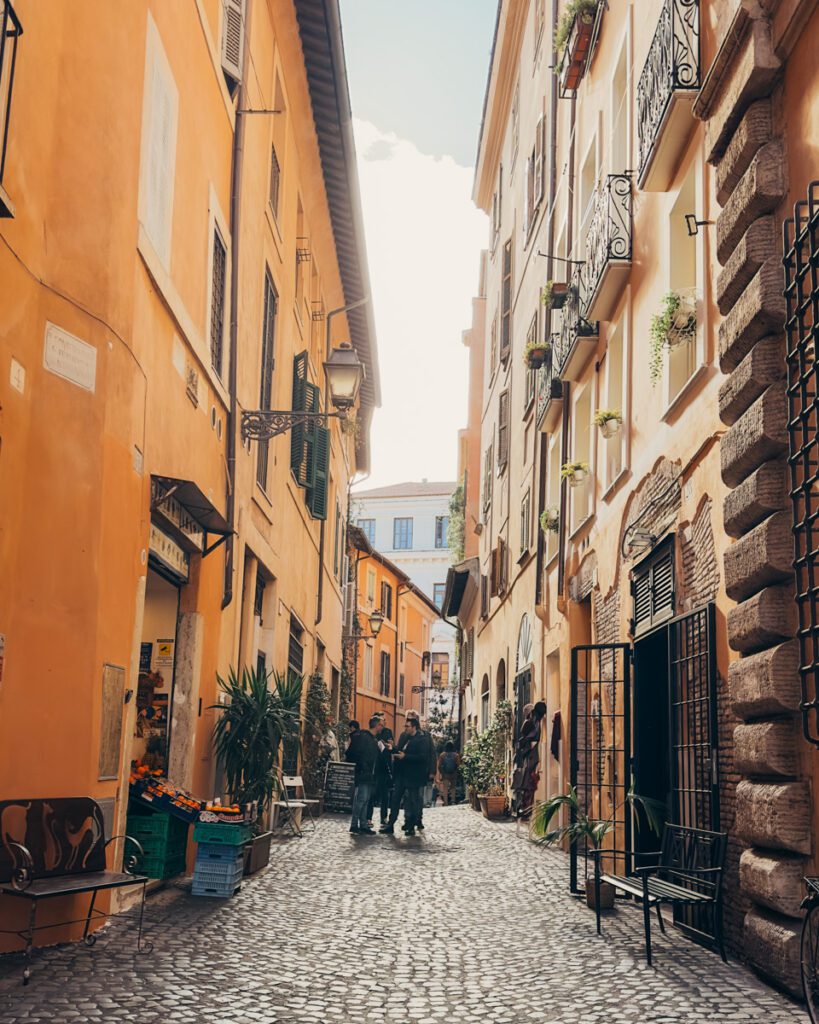
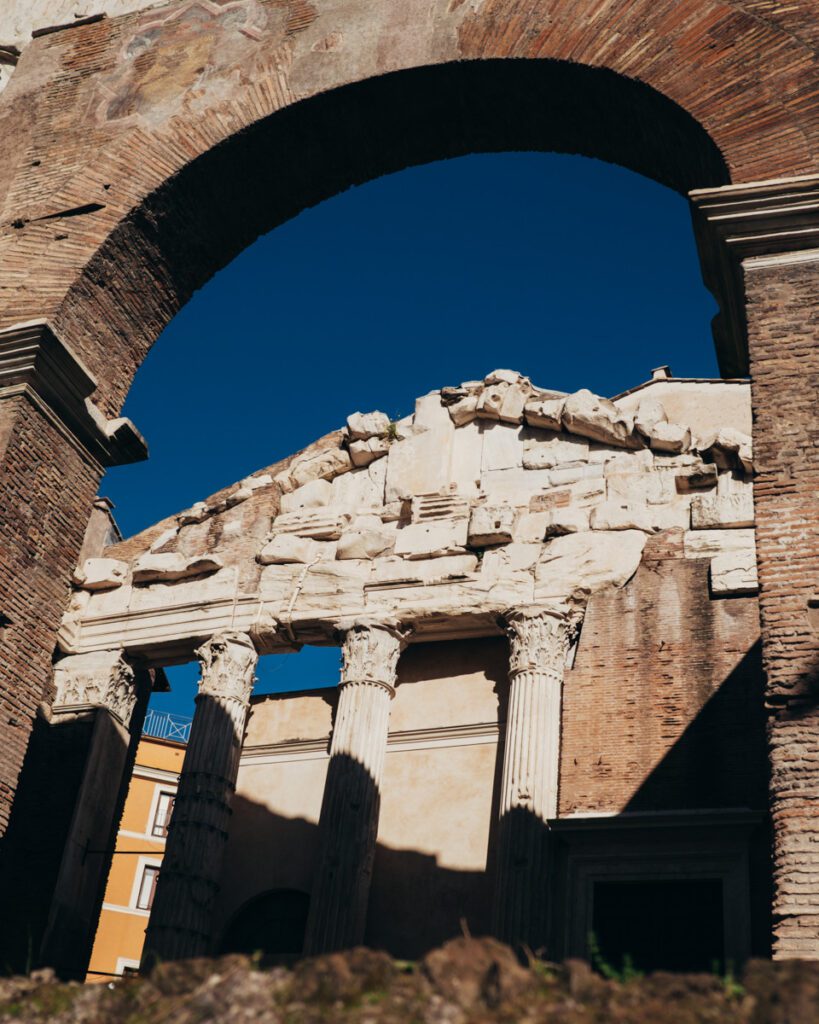
Today, the Jewish Ghetto is a vibrant tapestry of old and new. Kosher restaurants tempt visitors with traditional delicacies, mixing in Roman dishes with a Jewish twist. Enjoy specialties like artichokes prepared in the Jewish style (carciofi alla giudia) and fried codfish (filetti di baccalà). You’ll also find shops offering unique handcrafted treasures, and trendy cafes spilling into the piazzas.
If you want to take in a different kind of history, head to the ruins of the Portico d’Ottavia and Teatro Marcello. You can freely wander the trail here. The ruins of the Portico d’Ottavia are an imposing structure built by Emperor Augustus. They stand as a reminder of the rich history of the area. As for Teatro Marcello, this is an ancient Roman theater that adds to the area’s historical richness.
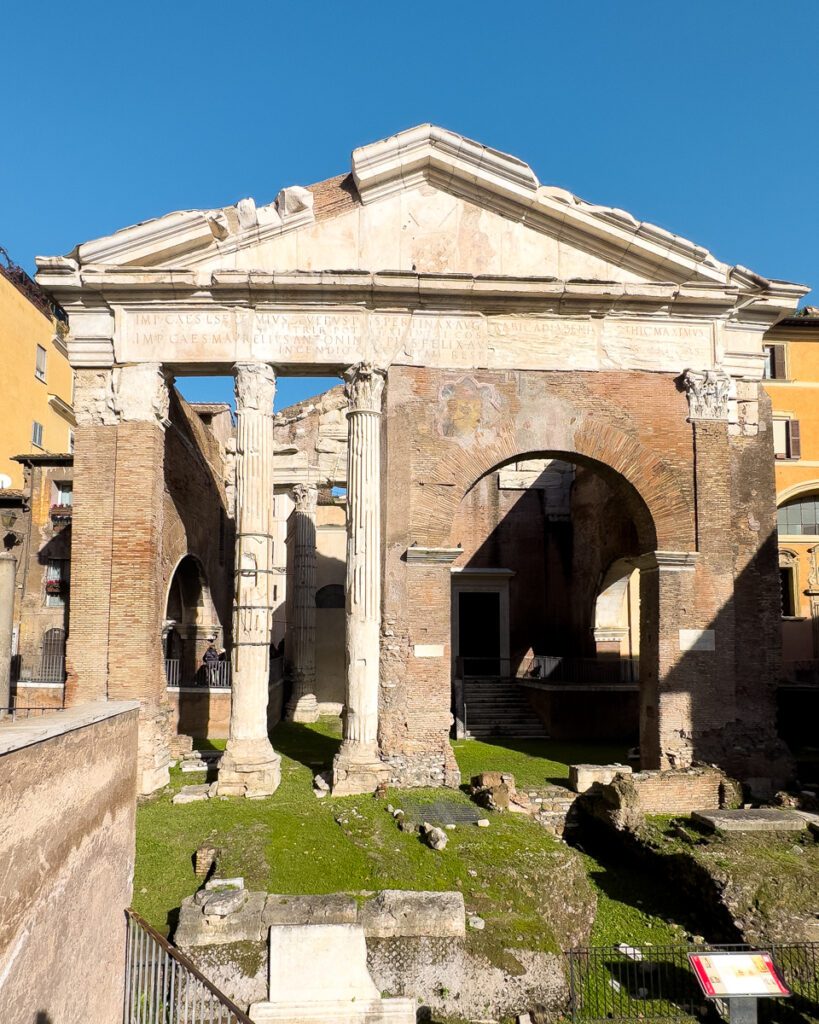
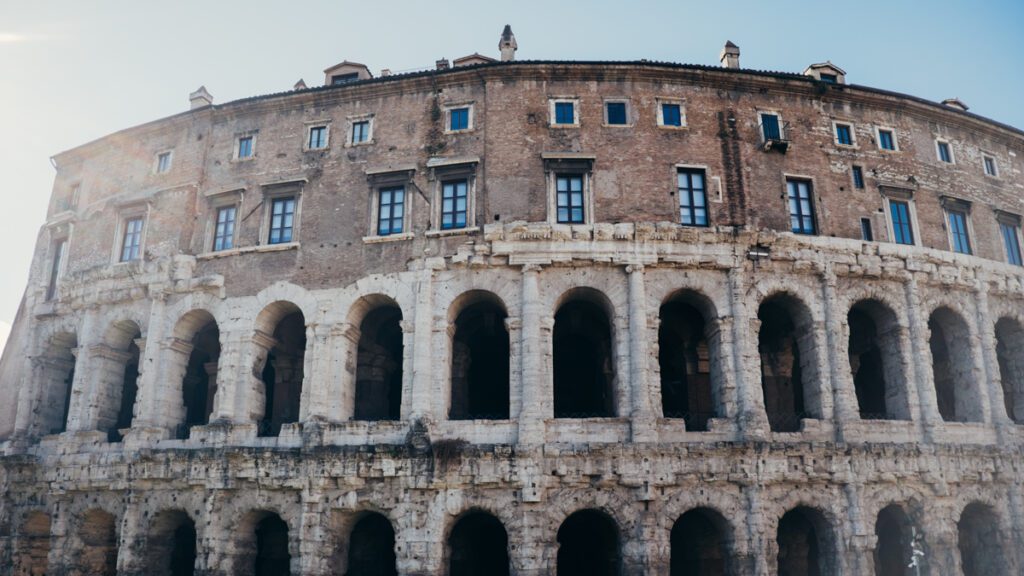
Whether you choose to visit during the day or at night, the Jewish Quarter is a vibrant area to discover. We highly recommend taking a few hours during your 3 days in Rome to explore this historic part of the city.
If you want to learn more about the Jewish Quarters in Rome, you can also check out this audio tour by Rick Steves.
INFORMATION ABOUT THE JEWISH QUARTER
No official site
Name in Italian: Ghetto Ebraico di Roma
Location: Check here on Google Maps.
How long to spend: You can quickly walk through the Quarter, but we recommend spending 2-3 hours walking around here. Sit at a café, enjoy a meal.
14. Villa Borghese & the Borghese Gallery, a unique museum to see during your 3 days in Rome
Villa Borghese is a vast estate in the heart of Rome. It’s known for its beautiful gardens, extensive art collection, and the renowned Borghese Gallery. The villa and its grounds were originally created as a vineyard. Gradually, they were transformed into a grand estate during the 17th century.
There are so many reasons that make Villa Borghese and its gallery such a must-visit landmark in Rome. The romantic gardens are beautiful, embracing a more naturalistic style. You’ll feel like you’ve been transported to a different place, even if you’re still in the heart of Rome.
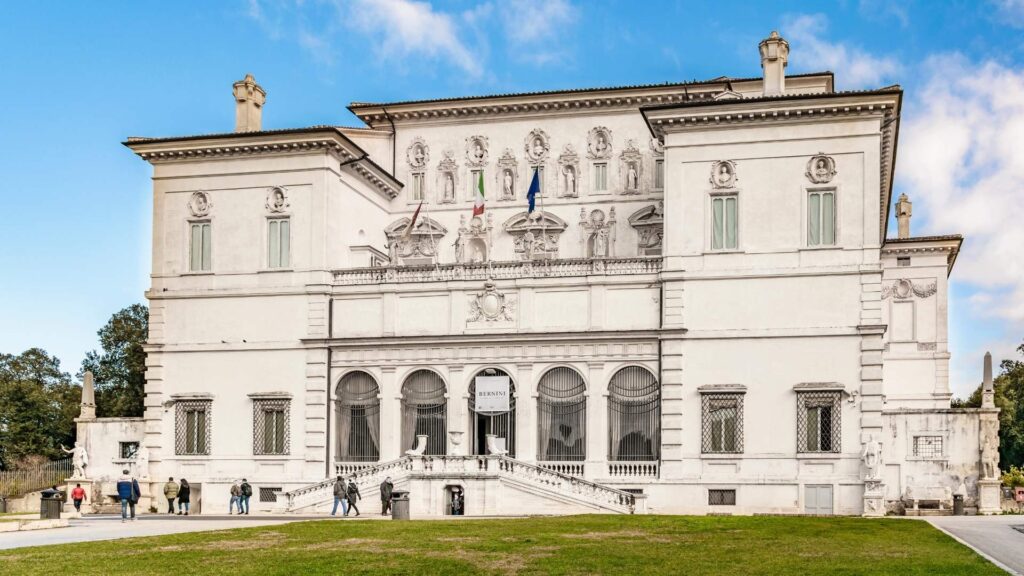
If you have the time, stroll along winding paths, discover hidden lakes, and keep an eye out for nymphs and other sculptures peaking out from the lush greenery. You can also discover the Tempio di Esculapio (a small temple on the lake) and Orologio ad Acqua del Pincio which is a hydropower clock. Walking around here is a perfect way to spend some of your time during your 3 days in Rome.
As for the Gallery, it’s housed within the luxurious villa, which is a marvel to discover in itself. Plus, it’s home to an impressive collection of art and sculptures including masterpieces by renowned artists such as Caravaggio, Bernini, Raphael, and Titian. If you visit the Gallery, be sure to spot the most notable pieces: Bernini’s sculptures of “Apollo and Daphne” and “David”, as well as Caravaggio’s Paintings of “David with the Head of Goliath” and “Boy with a Basket of Fruit”.
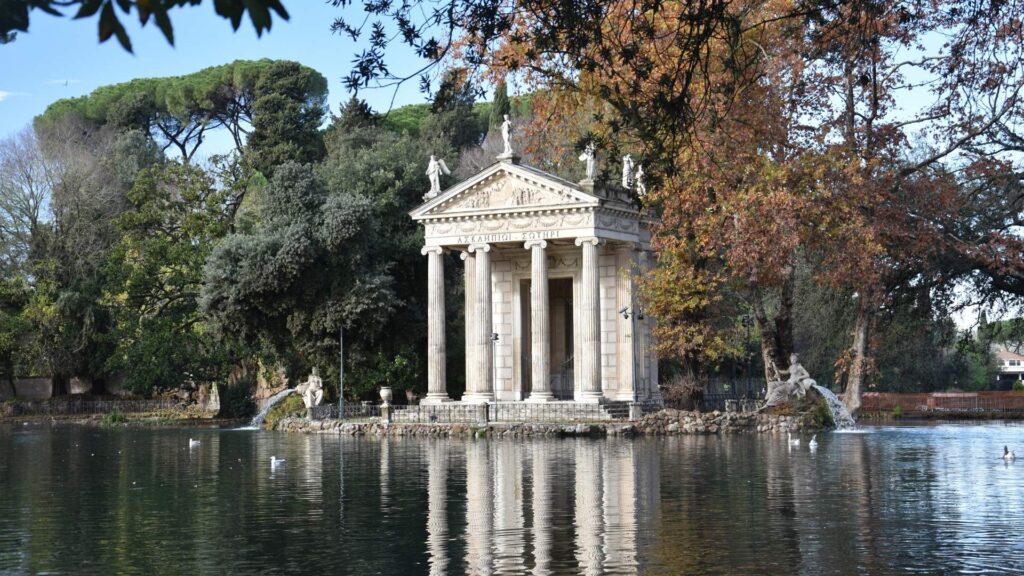
Tips for visiting Villa Borghese & the Gallery
If you want to visit the Borghese Gallery, don’t just show up! You need to get your tickets ahead of time.
There is a maximum of 360 people who are allowed in at one time in the gallery. Tickets are timed for two-hour visits starting each hour with a maximum of 180 people getting in each hour. You can pick up your tickets 30 minutes before your time slot but don’t arrive late. They may turn you away! Just walk around the gardens after picking up the tickets, before heading to the Gallery.
Since this gallery is one of the most prized collections in Rome (and Italy), tickets get booked up very fast, You can reserve your ticket up to 3 months in advance. But if you don’t do it in time, you can always find tickets through GetYourGuide or Viator. They also include a guided tour of Borghese Gardens.
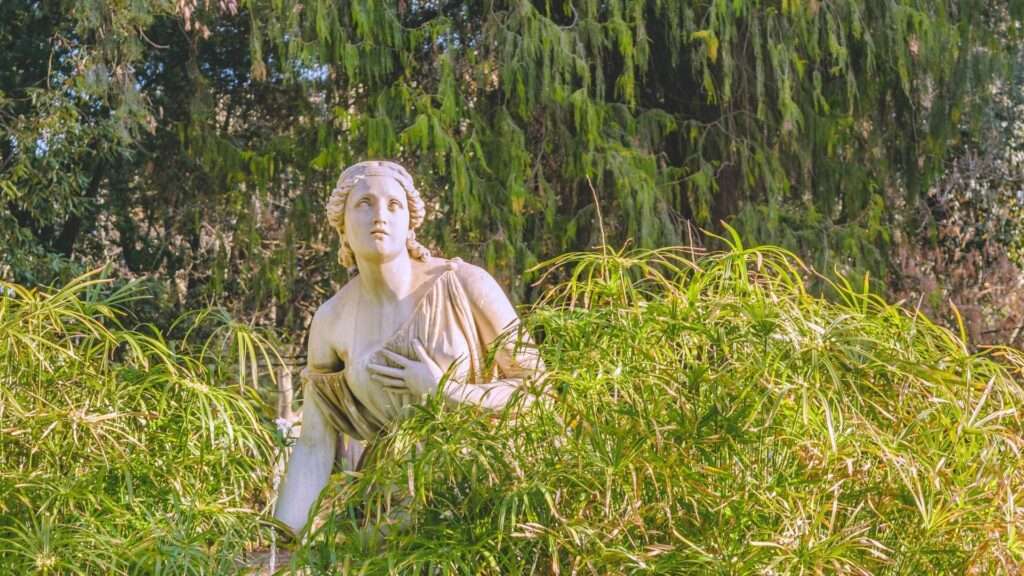
If you are an art lover, you can either get an audio guide for the gallery or go on a guided tour. This is the best way to truly appreciate all the art you’ll see here.
Don’t forget to go beyond the traditional route. There are plenty of hidden gems on the property. Don’t miss the Aranciera, a charming orangery housing a contemporary art collection. Or, catch a film at the Cinema dei Piccoli, the world’s smallest cinema which is tucked away in the park.
Pack a lunch and enjoy a little picnic in the Garden. Find a shady area, and soak in the beauty of this magnificent place.
INFORMATION ABOUT VILLA BORGHESE & THE GALLERY
Official site
Name in Italian: Villa Borghese. Galleria Borghese
Opening hours: From Tuesday to Sunday: 9 am to 7 pm. Last entry is 5:45 pm. Closed on Mondays and major Holidays
Entry Price: €26 for the Gallery. The Gardens are free to visit.
Location: Check here on Google Maps. Piazzale Scipione Borghese, 5
Transport: Metro Line A. Spagna, Barberini or Flaminio Station. You have to then climb the hill and walk another 20 minutes through the gardens to reach the gallery.
How long to spend: You’ll need about 2 hours in the gallery. Another 30-60 minutes if you want to explore the gardens more extensively.
15. Appian Way, a beautiful trip to take during your 3 days in Rome
Take a ride down History Lane, the Appian Way, known as Via Appia Antica. This is one of the earliest and most important Roman roads. It’s lined with ancient tombs and ruins. It’s surrounded by picturesque countryside and provides a glimpse into ancient Roman life and architecture.
The Appian Way was constructed in 312 BC by the Roman censor Appius Claudius Caecus. It was initially built for military purposes to connect Rome with the southern regions of Italy. The road played a crucial role in facilitating the movement of Roman armies and trade, extending all the way to the port city of Brindisi.
The Appian Way is renowned for its catacombs (more on this below) and ancient tombs lining the roadside. The Catacombs of San Callisto, San Sebastiano, and others were used for Christian burials, reflecting the transition from pagan to Christian practices. You’ll pass by the ruins of the Villa of the Quintilii, an ancient Roman villa that once belonged to the Quintilii brothers, aristocrats from back in the day.
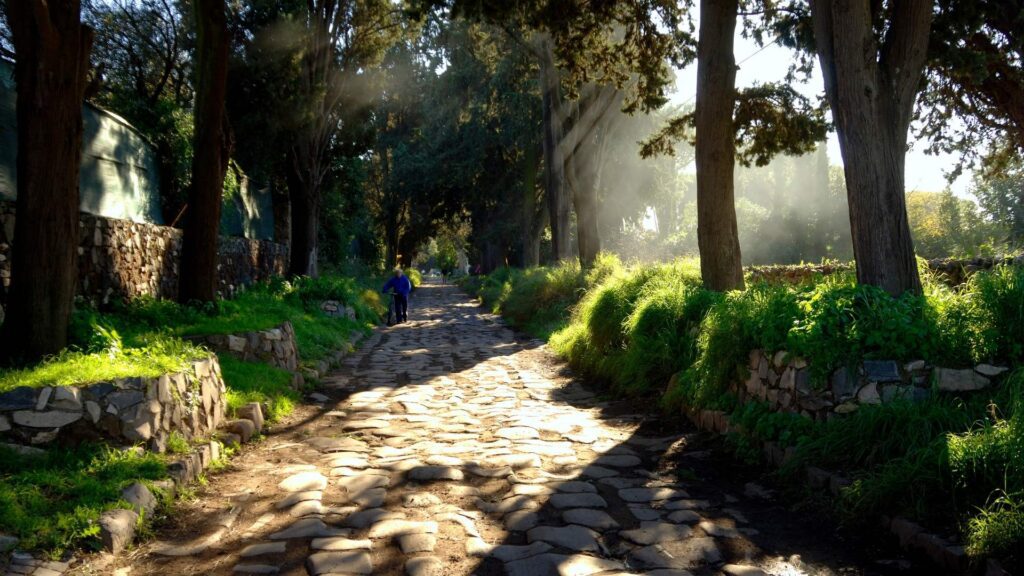
Admire the many churches and chapels that are scattered along the Appian Way. The Basilica of San Sebastiano is particularly notable. Another one of the well-preserved structures along the Appian Way is the Circus of Maxentius, an ancient Roman chariot racing stadium. Its ruins showcase the grandeur of Roman engineering.
The best way to discover the Appian way is on a guided bike tour. Walking it would be long. It’s also possible to do the tour on your own, but you’d need get to the site, find bikes to rent and look into the information of the places you see along the way.
The reason we recommend a guided tour is because they take the hassle out of getting here. Plus, you’ll get a lot more information while exploring the route. This is a good half-day or full-day tour, so just know that this will take up a good part of your 3 days in Rome.
In all honesty, we have not done this trek – we love walking around the city. We’ve been here so many times, yet we never get bored of the historic center of Rome. However, if you’re looking to get out of the city, take in more of the historic sites and see a different part of Rome, this trip was highly recommended to us by others who have done it.
INFORMATION ABOUT THE APPIAN WAY
No official site
Name in Italian: Via Appia Antica
Location: Check here on Google Maps.
How long to spend: You’ll need about 3-6 hours here, depending on the tour you take
16. Roman Catacombs, a different perspective for your 3 days in Rome
The Catacombs in Rome are another great trip to take down History Lane. They are a network of underground burial sites. You can visit them on your own, or you can join a guided tour that will also take you through the Appian Way. You also have options of guided tours that take you to the catacombs at night.. spooky!
Back in the day, the Catacombs were subterranean labyrinths where early Christians practiced their faith. They now serve as the final resting places for them. They are decorated with intricate frescoes and provide unique insight into ancient burial practices and Christian history.
There are 5 main catacombs to explore – some are on the Appian Way, while others are around the center of Rome:
- Catacombs of San Callisto (Callixtus): These are some of the most significant and extensive catacombs. They’re named after Pope Callixtus I, and contain numerous cubicula (small burial chambers) as well as the Crypt of the Popes.
- Catacombs of San Sebastiano: These are located on the Appian Way. They’re dedicated to Saint Sebastian and house the remains of this Christian martyr.
- Catacombs of Domitilla: Spread over multiple levels, the Catacombs of Domitilla are known for their well-preserved frescoes. The site also includes an underground basilica.
- Catacombs of Priscilla: Named after a noblewoman, these catacombs are known for the oldest known image of the Virgin Mary and Child. One of the hidden gems of Rome.
- Catacombs of San Agnese: Dedicated to Saint Agnes, a Christian martyr, these catacombs contain early Christian artwork and a basilica.
The catacombs will give you a completely different view of Rome and the ancient Roman times. Combining these visits with the Appian Way is the best (and most time-efficient) way to explore this part of Rome.
This activity may not be for everyone. If you want to explore more of the highlights and iconic landmarks of Rome, we would recommend you forgo these 2 activities (The Appian Way and the Catacombs). Although they’re very interesting and an important part of Roman history, it might be hard to fit everything in, without constantly rushing to get to the next spot.
INFORMATION ABOUT THE CATACOMBS
No official site
Name in Italian: Catacombe di (name of the catacomb)
Opening hours: Each catcomb has a different opening hour. Make sure to check this site.
Location: Each catacomb has a different location. San Callisto. San Sebastiano. Domitilla. Priscilla. San Agnese.
How long to spend: You’ll need about 30-45 minutes at each catacomb. But the guided tours will include the Appian way and visits to some of the catacombs. Tours vary from 3 hours to 6.
Hidden gems to discover in Rome
Of course, apart from the traditional classics to explore in Rome, there are also some unique hidden gems to discover. We have a whole article covering those. You can read about them here.
But we wanted to give you a quick sneak peek at some other landmarks you can include in your 3-day itinerary in Rome. You can expect fewer crowds here and experience a different side of Rome.
17. Trastevere, a unique neighborhood to discover on your 3-day Rome itinerary
We’re starting off our list of hidden gems with a charming neighborhood in Rome, Trastevere. It’s lesser known by tourists, characterized by narrow cobblestone streets, colorful buildings, and a lively atmosphere. If you want to discover authentic Roman life, quaint cafes, and artisan shops, this is the place for you.
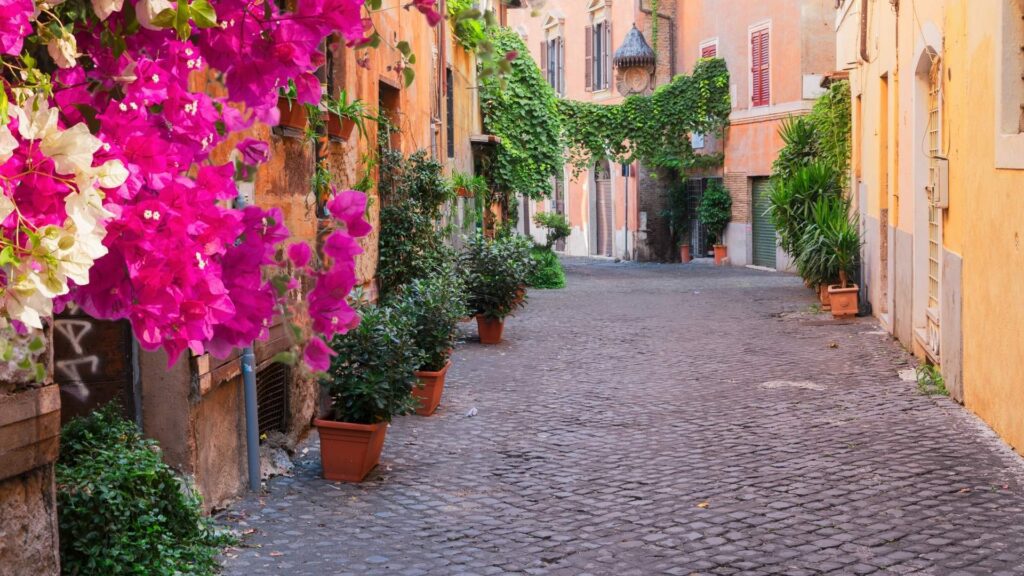
Trastevere means “across the Tiber”. It’s a picturesque and historic neighborhood in Rome that is slowly gaining in popularity, especially for those looking to explore a different part of the city. Here, you’ll find narrow cobbled streets, lined with colorful buildings adorned with ivy and flowers. The spring and summer are the best time to see this part of town because of this.
Trastevere is known for its vibrant nightlife, lively outdoor cafes, and a sense of community. Trastevere is home to artisan shops, vintage stores, and vibrant markets. If you’re looking to take home more unique “souvenirs”, come shop here. There’s a reason locals and travelers both love to come to this part of Rome.
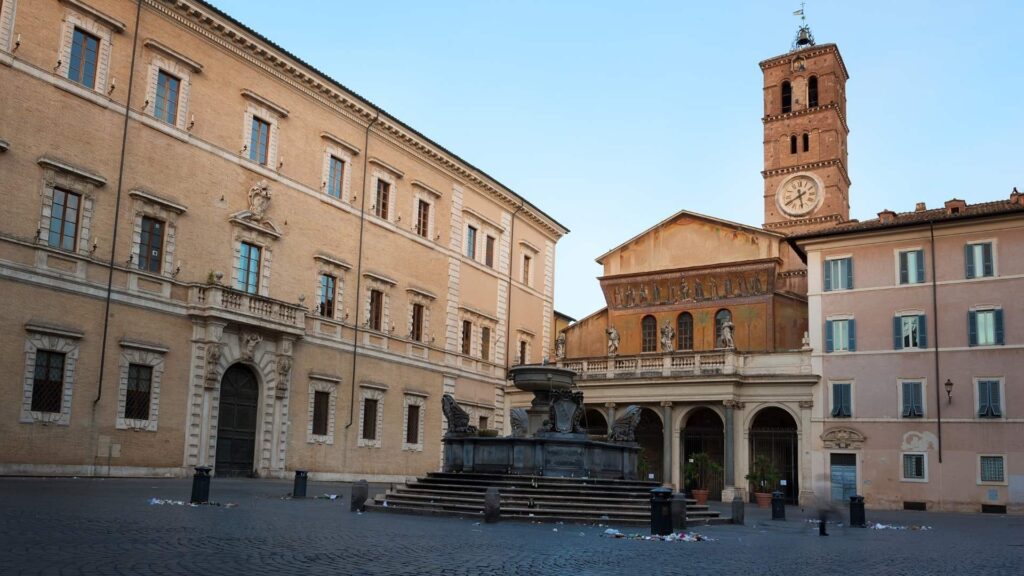
Some of the landmarks you can expect to find here are Basilica di Santa Maria. It’s a beautiful church with a stunning mosaic façade, and it’s one of the oldest churches in Rome, dating back to the 4th century. In front of it, you have its lively square surrounded by restaurants and cafes. You can also visit the Fontana dell’Acqua Paola, also known as the “Big Fountain”. It’s a prominent landmark in Trastevere where you can get panoramic views of Rome.
Trastevere is also a good place to stay in Rome. There are plenty of accommodations available here, though they’re not always budget-friendly. It’s not very close to the main attractions (except for the Vatican), but for those looking to enjoy the nightlife in Rome, this is a great place to set up camp. Because Trastevere is gaining in popularity, it might also get crowded in the summer and busier months.
INFORMATION ABOUT TRASTEVERE
No official site
Name in Italian: Trastevere
Location: Check here on Google Maps for the Basilica di Santa Maria. And here for the Fontana dell’Acqua Paola
How long to spend: You’ll need about 30-45 minutes here. Take a hike up the steps, visit the church and enjoy the view
18. Basilica di Santo Stefano Rotondo al Celio, a hidden gem in Rome, near the Colosseum
A short walk away from the Roman Forum and the Colosseum, you have the Basilica di Santo Stefano Rotondo al Celio, also known as Santo Stefano Rotondo. This is one of the oldest basilicas in Rome which is why it’s worth a visit.
Beyond the age of the church, what makes this place unique is its design. Santo Stefano Rotondo boasts a circular design, like the shape of the ancient Roman mausoleums. The circular layout symbolizes the celestial nature of the church. The basilica is surrounded by a colonnade and an atrium which creates a sense of grandeur. The entrance is adorned with ancient columns, and the atrium adds to the overall architectural charm.
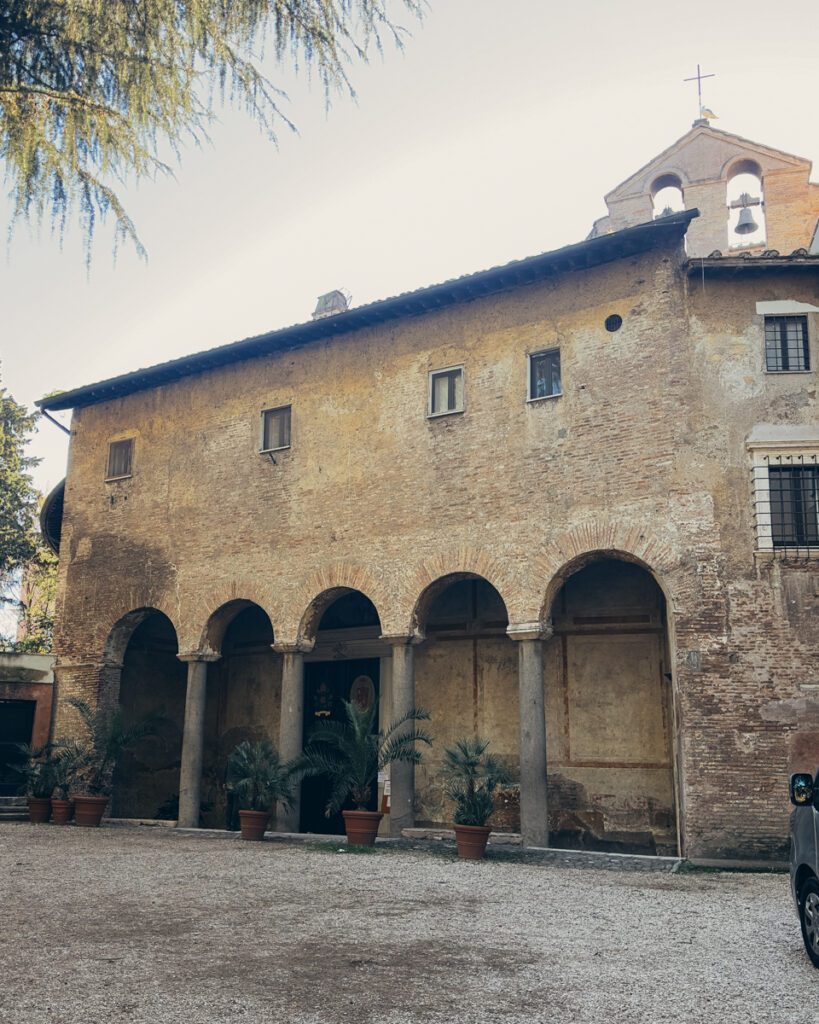
The church is also decorated with beautiful frescoes, including one from the 13th century, representing the Last Judgment. The church is also home to several relics, including the bones of Saint Stephen.
What also makes this church so lovely is that there are a ton of cats outside. They’re all looking for love, so take a moment to pet one or two on your way in and out of the church.
Note that in the winter months, the church closes from 1-2 pm. However, they’re very loose with the time. We showed up at 12:45 pm and the doors were already closed. Make sure you give yourself ample time before the closing times to get in.
INFORMATION ABOUT SANTO STEFANO ROTONDO
Official site
Name in Italian: Basilica di Santo Stefano Rotondo
Opening hours: Closed on Mondays. Open Tuesday to Sunday 10 am to 1 pm, 2 to 5 pm (winter schedule). Open Tuesday to Sunday 10 am to 1 pm, 3:30 to 6:30 pm (summer schedule).
Location: Check here on Google Maps.
How long to spend: You’ll need about 30-45 minutes here.
19. Chiesa di Sant’Ignazio di Loyola, a beautiful church to discover during your first trip to Rome
This old church might become one of the most Instagrammable places in Rome because of a new feature! But before we get into that, let’s tell you a bit about this beautiful church.
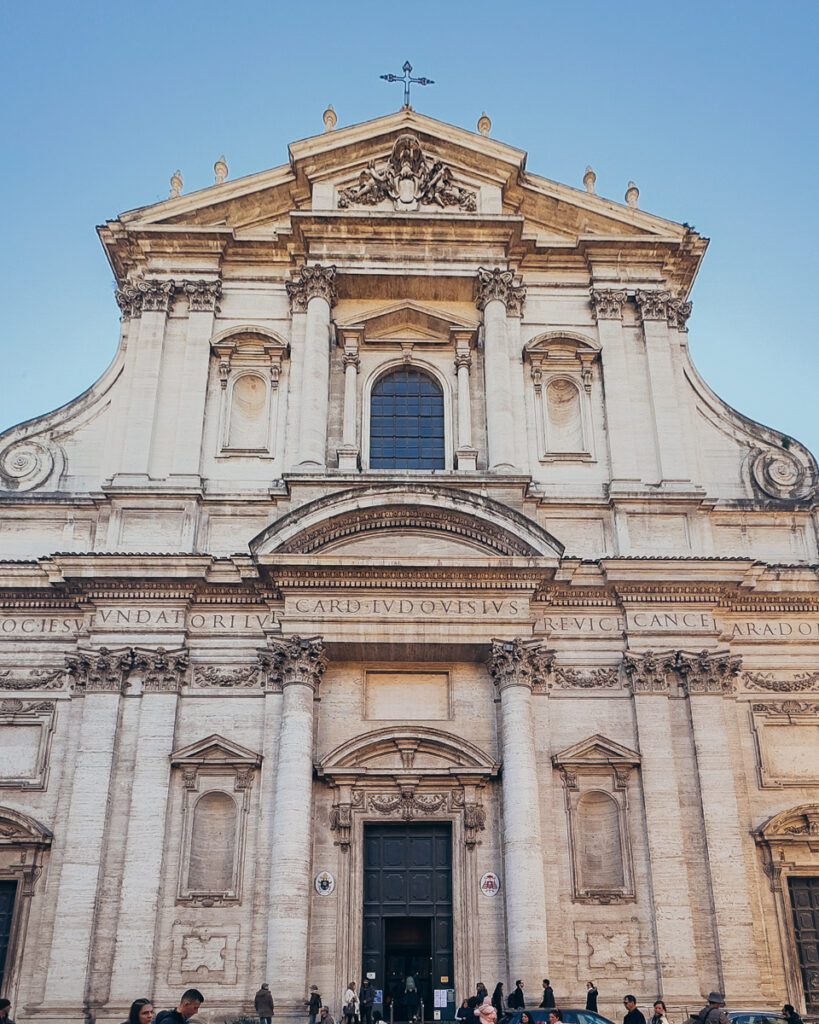
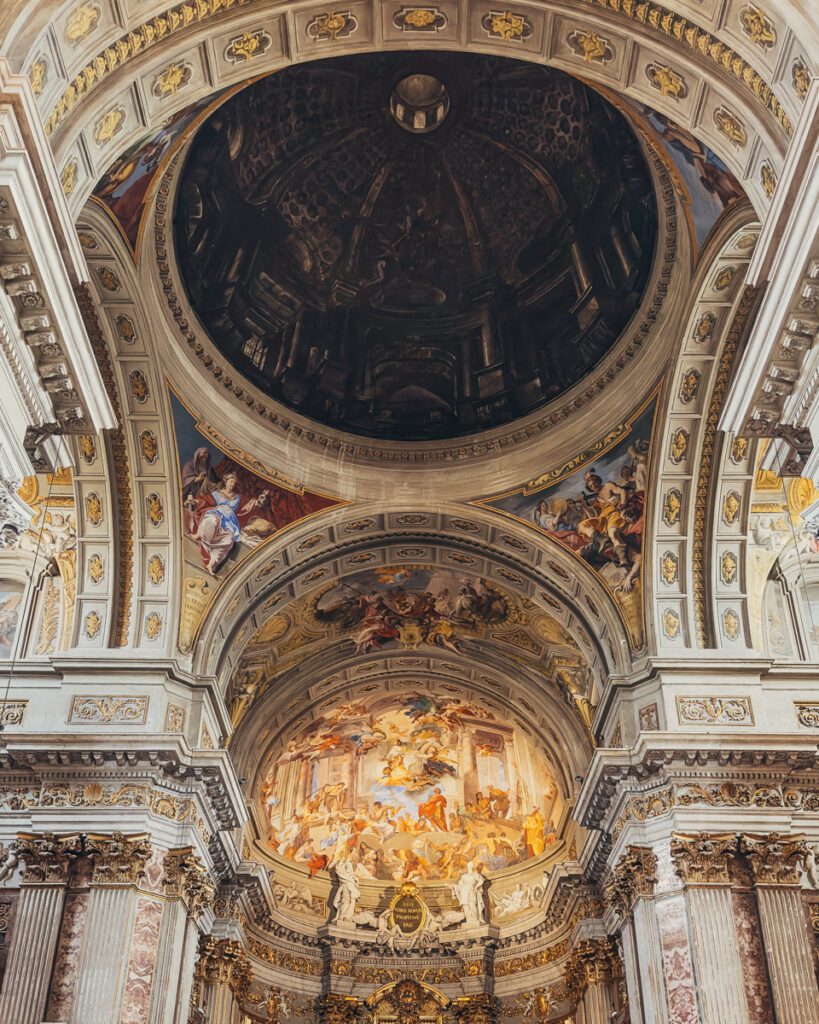
Chiesa di Sant’Ignazio di Loyola, also known as the Church of Sant’Ignazio, is a Baroque church located in the historic center of Rome. From the outside, it looks like all the other churches you’ll see here. But inside, you’ll discover one of the most beautiful frescoes in Rome.
In fact, those frescoes are one of the highlights of Sant’Ignazio. Looking up, you might think that you’re looking at a dome, but in fact, these are illusions created by Andrea Pozzo. The ‘dome’ is famous for its trompe-l’oeil (optical illusion) effect, because, in reality, it’s a flat ceiling.
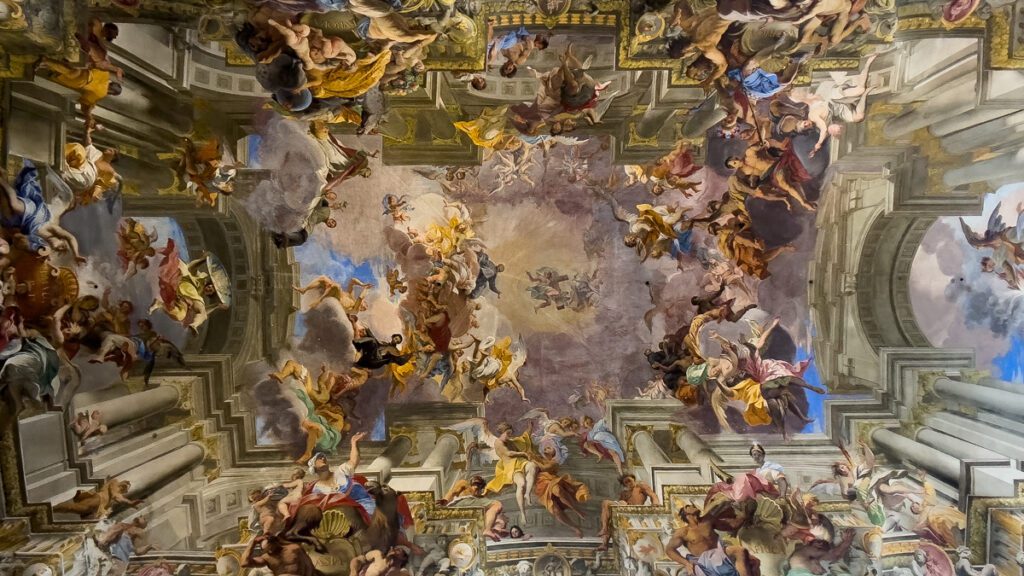
The church has capitalized on this effect and has now installed a mirror that highlights the beauty of the frescos. People line up for up to an hour to see themselves in the mirror and take their picture or video. The cost of visiting the church is free, but you have to pay €1 to use the mirror and unlock its effects.
Just note that this is still an active place of worship. Dress accordingly and be respectful of the people who have come here for church.
INFORMATION ABOUT THE SAINT IGNACIO CHURCH
Official site
Name in Italian: Chiesa di Sant’Ignazio di Loyola
Opening hours: Open every day, 9 am to 8 pm on weekdays, 9 am to 11:30 pm on Friday, Saturday and Sunday
Location: Check here on Google Maps.
How long to spend: You’ll need about 30-45 minutes here. Wait time may vary for the mirror.
20. Campo de’ Fiori Market, an authentic market to discover during your 3-day Rome itinerary
Another wonderful thing to do to get a feel of a more authentic Rome is to visit Campo de’ Fiori Market. Open daily except on Sundays, it’s where tourists and locals come to get a good taste of Roma!
Campo de’ Fiori, translates to “Field of Flowers”. This is a historic market square with a rich history dating back to the Middle Ages. Back then, it was a simple meadow where they also held many public executions (the not-so-happy side of this square).
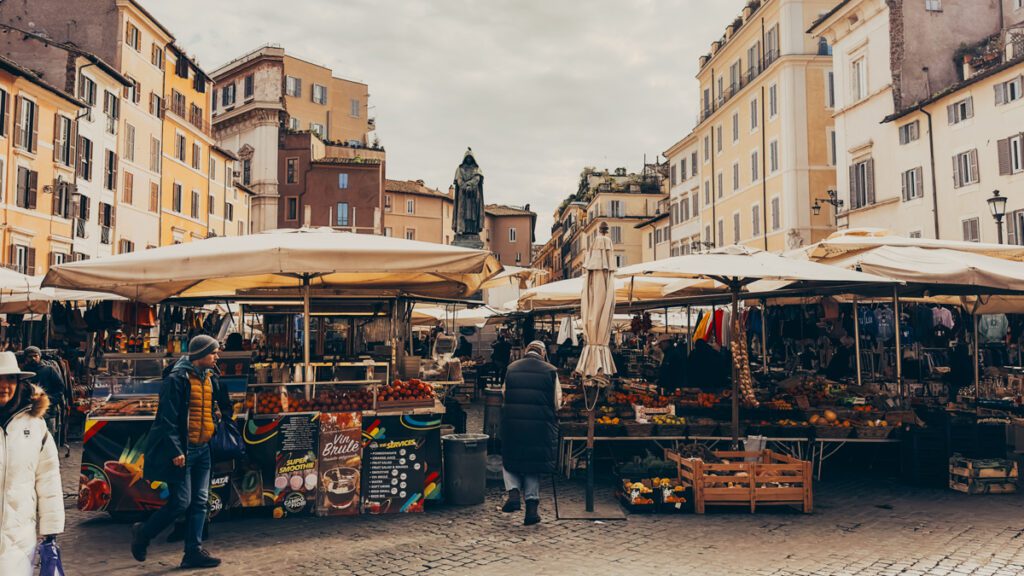
In fact, at the center of Campo de’ Fiori, atop all the stalls today, you can see an imposing and sinister-looking statue – Giordano Bruno. He was a philosopher and friar who was executed for heresy in the late 16th century. The statue commemorates his life and the struggle for free thought.
Today, the square is better known for hosting a vibrant market during the day and its lively atmosphere at night. As you weave through the stalls, get ready to taste some free samples of cheese and cured meats! Don’t even try to refuse, they’ll feel insulted. They didn’t even want to accept Carine’s refusal (and she’s vegan)!
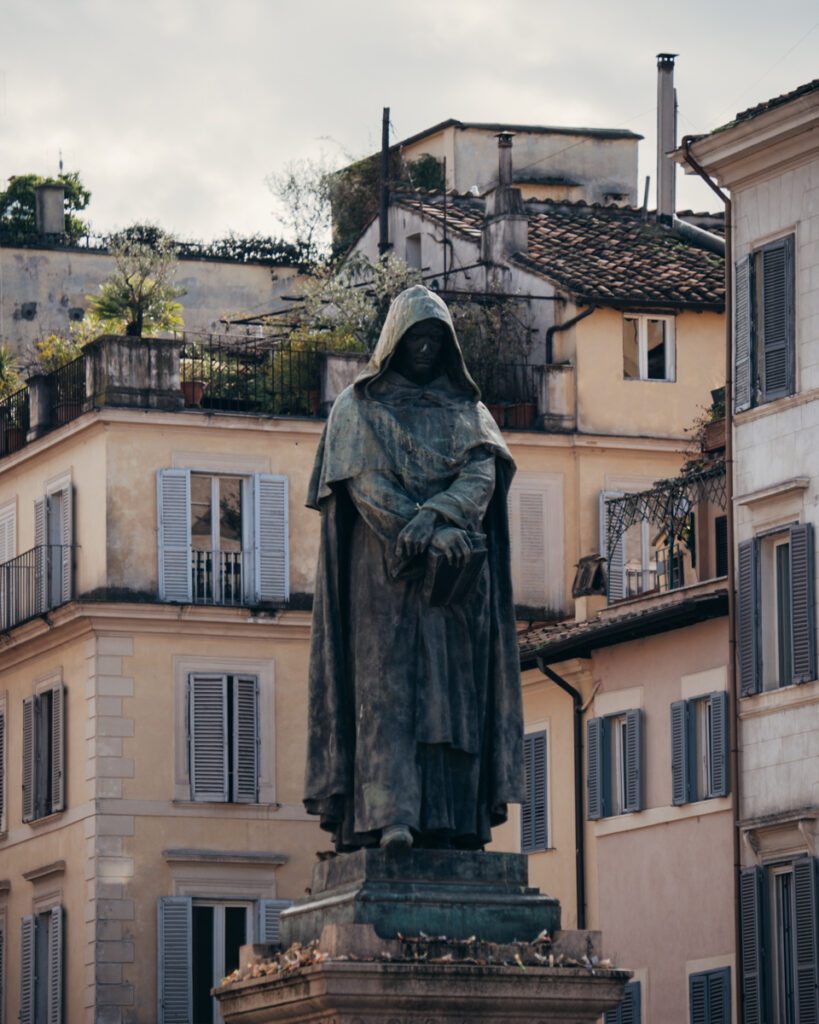

The name of the market is quite fitting because it’s famous for its fresh produce, fruits, vegetables, and colorful flowers. Vendors set up stalls with amazing seasonal and locally sourced products. Of course, there are also vendors selling some souvenirs, although they are mainly food-based. If you want to take the flavors of Italy home, within your country’s restrictions, this is a great place to shop!
If you’re looking to get the best fare, make sure you arrive early. Also, know that you can haggle a little with the vendors. Try your luck by asking for a better price. Also, it always helps to have cash on you – most vendors don’t take cards, and it’s always easier to get a better price when you’re paying cash!


One of our favorite things to do was stock up on these local delicacies – cheeses, meats and produce, and to have a picnic with our fare. You can buy some bread and make little sandwiches, or just eat your goods fresh. If you’re heading to Villa Borghese or one of the piazzas nearby, this is a great way to enjoy your food and people-watch. Campo di Fiori Market is close to both Piazza Navona & the Pantheon.
Once you’re done with the market, make sure you walk around the streets here. They’re lined with lovely shops and boutiques. You can find some very unique pieces from local designers. We fell in love with a shop called ‘The Guitar Bag’ which has some amazing pieces inspired by guitars and music.
INFORMATION ABOUT THE CAMPO DÈ FIORI
Official site
Name in Italian: Campo dè Fiori
Opening hours: The market is open in the morning, every day, except Sunday, 7 am to 2 pm. At night, restaurants and cafés spill into the square
Location: Check here on Google Maps.
How long to spend: You’ll need about 30-45 minutes here. Walk around in the streets around for some boutique shops
21. Complesso di Sant’Ivo alla Sapienza, a hidden gem in Rome
We came upon the Complesso di Sant’Ivo alla Sapienza by accident, and what a great discovery it was! This place is a masterpiece of Baroque architecture. It was designed by the renowned architect Francesco Borromini. Today, it’s part of the larger Sapienza University campus and houses the church of Sant’Ivo alla Sapienza, the Palazzo della Sapienza, and the Biblioteca Alessandrina.
You’ll be drawn in by the design of this beautiful place. First, the courtyard is spectacular, surrounded by columns and arches. Next, you’ll notice one of the most distinctive features of the Complexe – the church’s double dome, which is an engineering marvel. It’s one of the most recognizable domes in Rome.
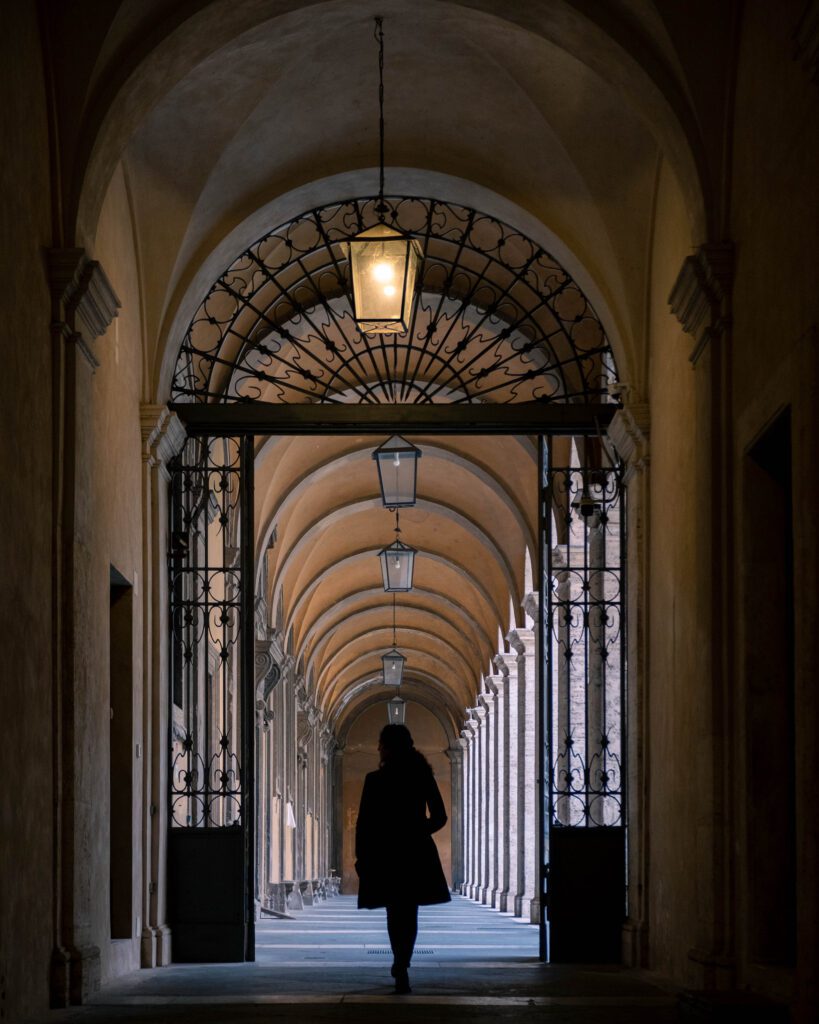
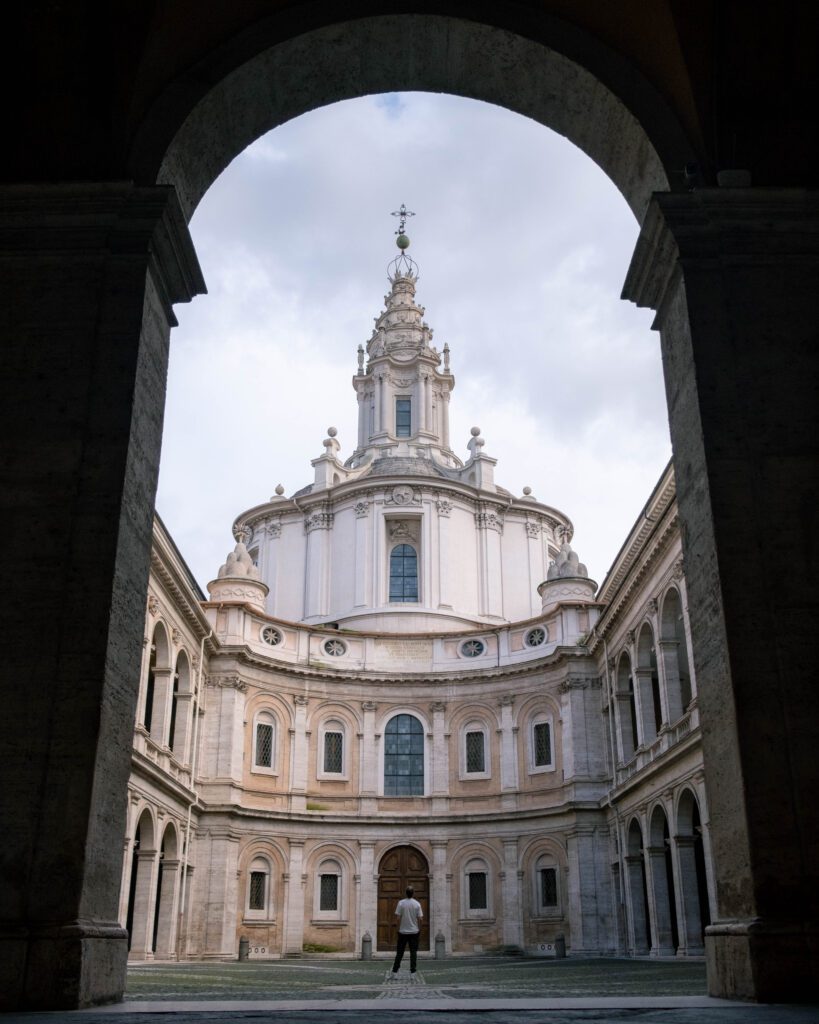
If you have a chance, we recommend visiting the library – Biblioteca Alessandrina. It was founded in the 17th century and is housed in the Palazzo della Sapienza. Inside, you can find an impressive collection of over 1 million books. The library is open to the public and well worth checking out.
Many people overlook this UNESCO heritage site when they visit Rome. You don’t need to spend a ton of time here, but it’s really worth stopping by if you’re in the area. It’s a few steps away from Piazza Navona.
INFORMATION ABOUT THE COMPESSO DI SANT’IVO ALLA SAPIENZA
Official site (In Italian)
Name in Italian: Complesso di Sant’Ivo alla Sapienza
Opening hours: Open weekdays, 9 am to 6 pm
Location: Check here on Google Maps.
How long to spend: You’ll need about 30-45 minutes here.
4 different 3-day Rome Itineraries
Now that you know all the best landmarks and iconic spots you need to add to your 3 days in Rome, here are 4 different options of routes you can take to explore them all.
The best way to take in the wonders of Rome is to walk around. You can also take an Uber, ride the bus, tram or metro if some places are too far, or if the heat is overwhelming. Here are a few quick notes for you to get around the city with ease:
- Use Google Maps to plan walking routes, considering distances if it’s too hot, or if you’re not comfortable walking around so much.
- If you don’t have a European SIM card, we recommend getting an eSIM with Airalo (if your phone supports it). It’s the easiest way to get data when you travel. Use the code CARINE5115 to get $3 off your package.
- Purchase an Omnia 3-day pass for free public transportation within the city limits. You can also get access to the best museums and landmarks.
- Consider booking skip-the-line tickets for popular attractions like the Vatican Museums and Colosseum to avoid wasting time.
- Wear comfortable shoes and be prepared to walk uphill! We walked over 25,000 steps a day when we’re in Rome… but we love to explore by foot.
- If you’re visiting Rome in the summer, consider wearing light, breathable clothes that protect you from the sun.
And a final reminder. The most important of them all! Your time in Rome should not be seen as a checklist of things to do. Allow yourself to truly immerse yourself in each spot. Take in its history and beauty. Walk around. Get off the beaten track. Sit and enjoy (another) gelato, coffee or pizza. People watch. Enjoy it! You’re in Roma!
And if you skip out on some of these activities, no worries, just go throw some extra coins in the Trevi Fountain, and you’ll be sure to come back!
1. Rome 3-day itinerary – The most iconic landmarks
This 3-day itinerary in Rome covers all the classics. It makes for long days, with tons of info and wonder. If you want to make the most of your time here, this is the route you should take.
Day 1:
- Colosseum (guided tour recommended): Immerse yourself in the grandeur of ancient Rome with gladiator tales and Forum explorations.
- Roman Forum & Palatine Hill: Climb for panoramic views and a glimpse into imperial palaces.
- Capitoline Hill: Get a higher vantage point on the Forum and the city
- Altar of the Fatherland: One of the most beautiful views of Rome. Go up the elevator to take it to new heights.
- Trevi Fountain: Toss a coin and make a wish at this iconic fountain.
- Spanish Steps: Climb the elegant steps and enjoy Piazza di Spagna’s vibrant atmosphere. Shop around, if you like. Enjoy a glass of wine on one of the rooftop terraces with stunning views of Rome.
Day 2:
- Vatican City & St. Peter’s Basilica: Marvel at the Sistine Chapel masterpieces and St. Peter’s awe-inspiring architecture.
- Vatican Museums: Explore the vast collection of art and artifacts.
- Castel Sant’Angelo: Walk on the ramparts and soak in the Tiber River views.
- Borgo Pio: Enjoy a delicious late pranzo (lunch) in this quaint neighborhood near the Vatican.
- Jewish Quarter: Walk around the city as you make your way to the Jewish Quarter.
- Have supper at a kosher trattoria.
Day 3:
- Borghese Gallery & Gardens: Start the day soaking in the beauty and history of this place
- Pantheon: Visit the architectural marvel and soak in the unique atmosphere. Head outside to take in a street performance.
- Piazza Navona: Admire Bernini’s Fountain of the Four Rivers and relax with a gelato in the square.
- Complesso di Sant’Ivo alla Sapienza: Come in for a quick look, or check out the library if you have some free time.
- Campo de’ Fiori Market: Experience the lively market atmosphere and savor the iconic pizza slices.
- Trastevere: Wander through charming cobbled streets, discover hidden trattorias, and enjoy the bohemian vibe. Stay in the area and enjoy the lively nightlife.

2. Itinerary for 3 days in Rome: Ancient Paths & Jewish Delights
This is a different spin on the Classical route. You’ll get to discover some of the hidden gems in Rome, as well as take in the particularities each neighborhood has to offer.
Day 1:
- Appian Way (bike rental/tour recommended): Cycle or walk along this historic road, stopping at the Mausoleum of Cecilia Metella and Catacombs (closed Mondays).
- Jewish Quarter: Discover the synagogues, museums, and lively atmosphere of this historic neighborhood.
- Campo de’ Fiori: Enjoy the afternoon market and grab a refreshing aperitivo.
- Complesso di Sant’Ivo alla Sapienza: Come in for a quick look, or check out the library if you have some free time.
- Piazza Navona: Relax with a dinner overlooking the captivating Fountain of Neptune.
Day 2:
- Colosseum (guided tour recommended): Uncover the secrets of gladiator games and Roman emperors.
- Roman Forum & Palatine Hill: Enjoy stunning views and learn about imperial palaces.
- Altare della Patria: Climb to the top for panoramic vistas and explore the museum.
- Capitoline Hill: Take in the views here
- Trevi Fountain & Spanish Steps: Make a wish and climb the iconic steps, soaking in the lively atmosphere.
- End your day shopping around the Spanish Steps or with a glass of wine on the terrace
Day 3:
- Vatican City & St. Peter’s Basilica: Marvel at the Sistine Chapel masterpieces and St. Peter’s grandeur.
- Vatican Museums: Explore the vast collection of art and artifacts.
- Castel Sant’Angelo: Walk on the ramparts and witness breathtaking Tiber River views.
- Trastevere: Enjoy a romantic dinner in a hidden taverna and wander through the charming streets. Stay and enjoy the nightlife, if you still have the energy!
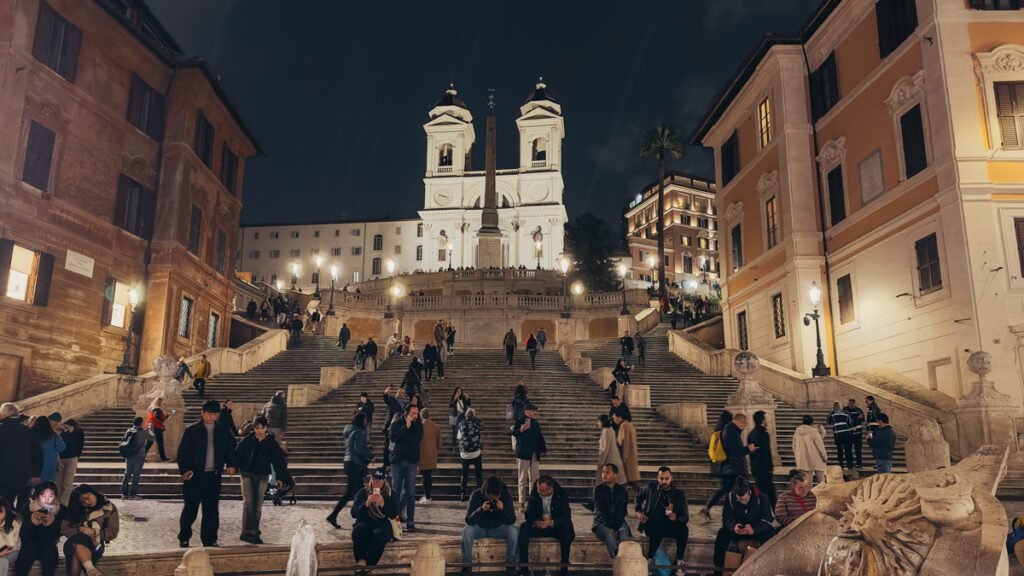
3. 3-day Rome itinerary: Off the Beaten Path & Modern Mix
This itinerary will take you all around town, exploring the musts, as well as some more hidden gems. It’s a good mix of things to do if you don’t want to spend too much time doing the landmarks.
Day 1:
- Trastevere: Start your day with a coffee and pastry in a local cafe and explore the vibrant streets.
- Gianicolo Hill: Hike up for panoramic views of the city and stunning sunsets.
- Vatican & Saint Peter’s Basilica: Come in for a quick look of this iconic place. Try not to spend too much time here. And get the ‘Skip the line’ tickets.
- Piazza Navona: Enjoy a relaxing lunch overlooking the beautiful fountains.
- Complesso di Sant’Ivo alla Sapienza: Come in for a quick look, or check out the library if you have some free time.
- Pantheon: Discover the architectural wonder and its fascinating history.
- Supper at Pane e Vino: Homemade pasta in a delightful atmosphere, just steps away from the Pantheon. Make sure to reserve your table.
Day 2:
- Borghese Gallery: Immerse yourself in the beauty of Renaissance art and sculptures.
- Spanish Steps & Piazza di Spagna: Join the stylish crowd and walk down the iconic steps. Take in the views of the city.
- Trevi Fountain: Toss a coin and make a wish at this world-famous landmark. Go for a quick look at the Galleria Sciarra
- Jewish Quarters: Walk around then enjoy supper in a traditional trattoria.
Day 3:
- Colosseum (guided tour recommended): Experience the legacy of the Gladiators and uncover stories of ancient Rome.
- Roman Forum & Palatine Hill: Climb for panoramic views and discover the remains of imperial palaces.
- Altar of the Fatherland: Ascend to the top for breathtaking views and explore the museum.
- Capitoline Hill: View the Forum and the city with a different vantage point
- Campo di Fiori Market: Experience the different side of Rome with trendy shops, delicious street food and cute restaurants. Stay for the vibrant nightlife
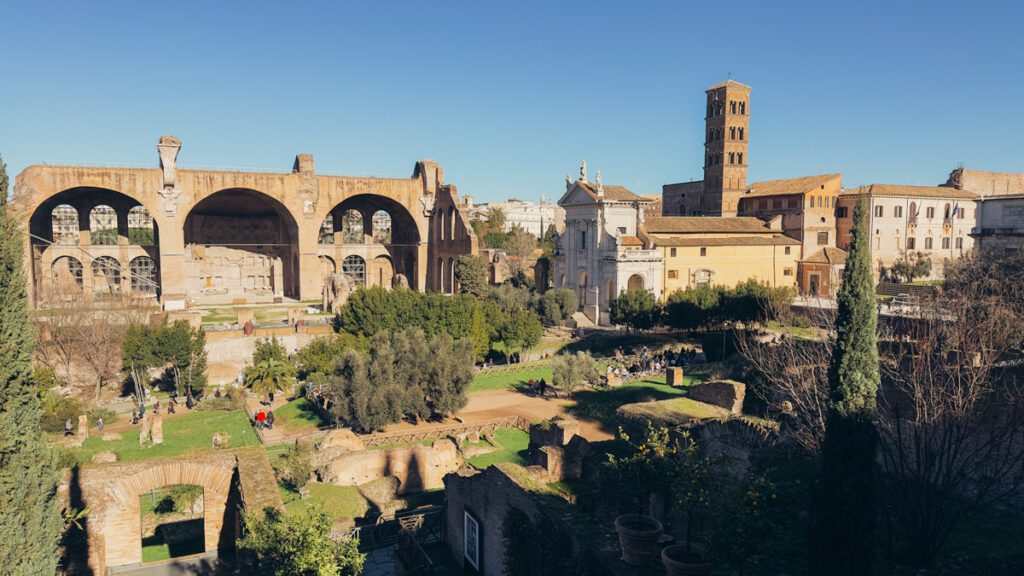
4. Walking itinerary for 3 days in Rome: Romantic Rome & Neighborhoods for those who love to walk
This itinerary is for those who love to walk. You’ll be seeing and doing a lot. If you’re feeling tired, don’t be shy to use public transport or to call an Uber.
Day 1:
- Start at the Spanish Steps
- Walk to the Trevi Fountain, with a quick stop at Galleria Sciarra
- Head to Chiesa di Sant’Ignazio di Loyola for a look at the ‘dome’ and frescoes
- Take a look inside the Pantheon
- Soak in the vibrant atmosphere at Piazza Navona
- Come in for a quick look at the Complesso di Sant’Ivo alla Sapienza
- Walk around Campo de Fiori
- Supper at Giulio Passami L’olio
Day 2:
- Start at the Colosseum (guided tour recommended)
- Head to the Roman Forum & Palatine Hill
- Take the exit at Capitoline Hill and enjoy the view here
- Go to Altar of the Fatherland and take the elevator up
- Walk around the Via dei Fori Imperiali
- Head to the Jewish Quarters, walk around and grab a quick bite to eat
- Enjoy the night in Trastevere
Day 3:
- Start off at the Vatican & St Peter’s Basilica
- Head to Castel Sant’Angelo
- Enjoy lunch in the neighborhood
- Next, you can either head to the Appian Way & Catacombs (bike rental/tour recommended) OR visit the Borghese Gallery

Where to stay in Rome – The best areas for your 3 days in Rome
There is no shortage of places to stay in Rome. It will all depend on your budget and what you’re most looking forward to exploring. We always book through Booking.com or Hostelworld.com, depending on what we’re looking to do.
Here are some ideas of where to stay in Rome.
- Centro Storico (Historic Center): You can’t get any more central than the historic part of Rome.
- Pros: Here, you’ll be immersed in history, and within walking distance to the top attractions like the Colosseum, Pantheon, Trevi Fountain and more. The atmosphere is vibrant. There are charming piazzas and plenty of restaurants and shops around.
- Cons: It can be crowded and noisy, especially in the summer months. It will make getting around a little harder, unless you’re only walking. It’s also quite expensive. And since it’s such a touristic area, you won’t have as many local experiences.
- Trastevere: Located across the Tiber, this is an up-and-coming neighborhood with plenty of local experiences.
- Pros: It exudes charm – cobbled streets, bohemian vibes, trendy restaurants and bars. At night, it’s very lively, It has an authentic Roman feel.
- Cons: It’s not as close to major attractions located across the Tiber. You’re closest to Vatican City. In the summer months, it can get crowded in touristy areas. There are fewer budget-friendly options in this area.
- Campo de’ Fiori and Piazza Navona: Another central location. You’re a few steps away from all the major landmarks.
- Pros: You’ll be very well-located, surrounded by beautiful piazzas with stunning architecture. The atmosphere is lively. And you’re close to so many restaurants and shops. Just be careful of tourist traps.
- Cons: Again, it will be very touristy and expensive, no matter when you go. It can get noisy at night – and know that insolation and soundproofing are not great in Italy.
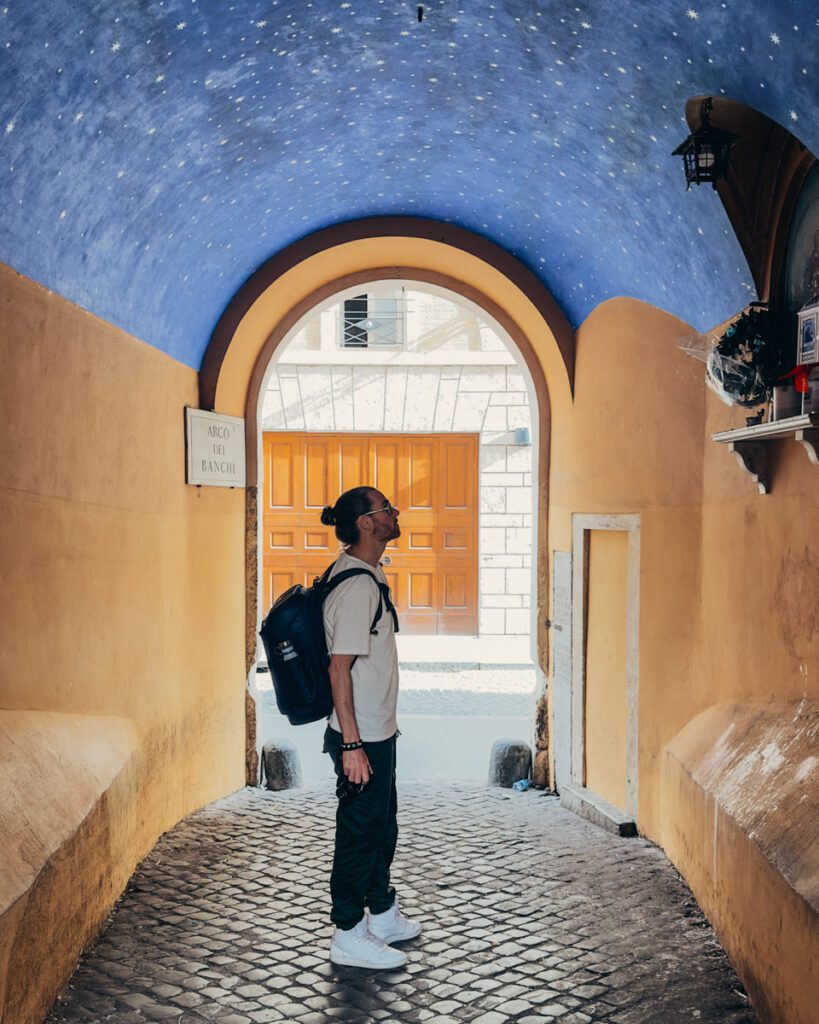
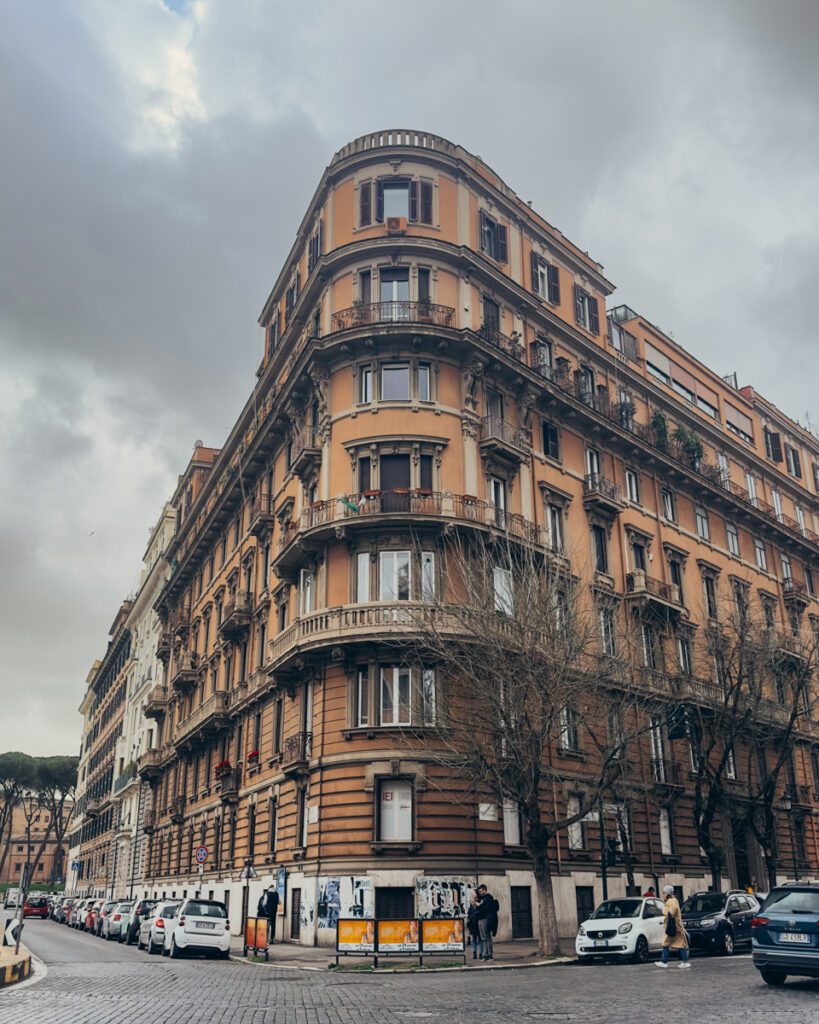
- Prati: This is where we chose to stay. It’s close to the Vatican City and offers a more residential experience.
- Pros: You’ll be close to Vatican City and St. Peter’s Square. It’s a lot more quiet and more residential than in other parts of the city. It’s well-connected by public transportation. And there are plenty of delicious dining options available. You can find great prices here.
- Cons: It’s a bit further out, but perfect for those who love to walk. The nightlife is limited.
- Monti: It’s a trendy and artistic neighborhood near the Colosseum. You’ll have a more authentic feel but close to the major landmarks.
- Pros: This up-and-coming area has a nice mix of history and modern charm. It’s close to the Colosseum and Forum, as well as trendy restaurants and cafes. Despite that, there’s a good local vibe here.
- Cons: Despite being close to the Colosseum, it’s not as convenient for reaching all the other attractions. There are fewer budget-friendly options here and it can be hilly. Keep that in mind if you have rolling suitcases.
- Other options of places to stay in Rome:
- Spanish Steps: It’s a great choice for those who want to be in the heart of luxury shopping, fine dining, and near cultural attractions like the Villa Borghese gardens. Expect a higher price tag here, just like everything in this area.
- Quirinale and Esquilino: This is a budget-friendly area with good public transport connections. It’s close to Termini station.
- Testaccio: Enjoy an authentic Roman atmosphere with an excellent food scene. If you want to be away from crowds, this is the place for you.
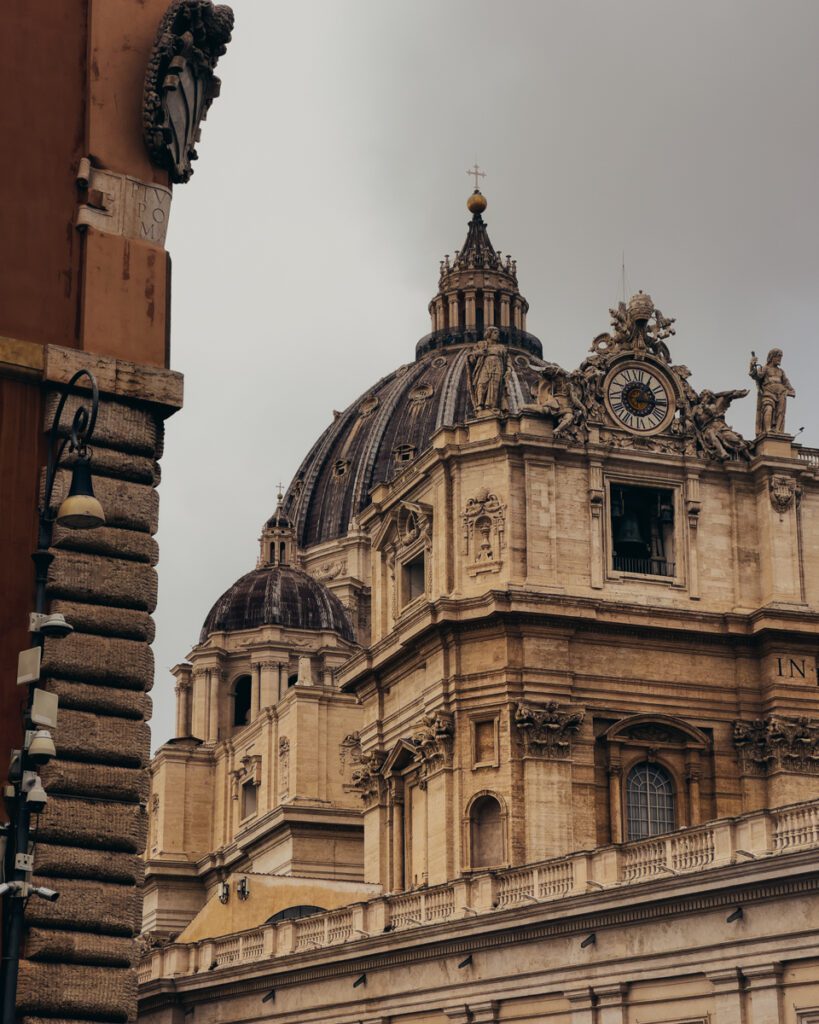
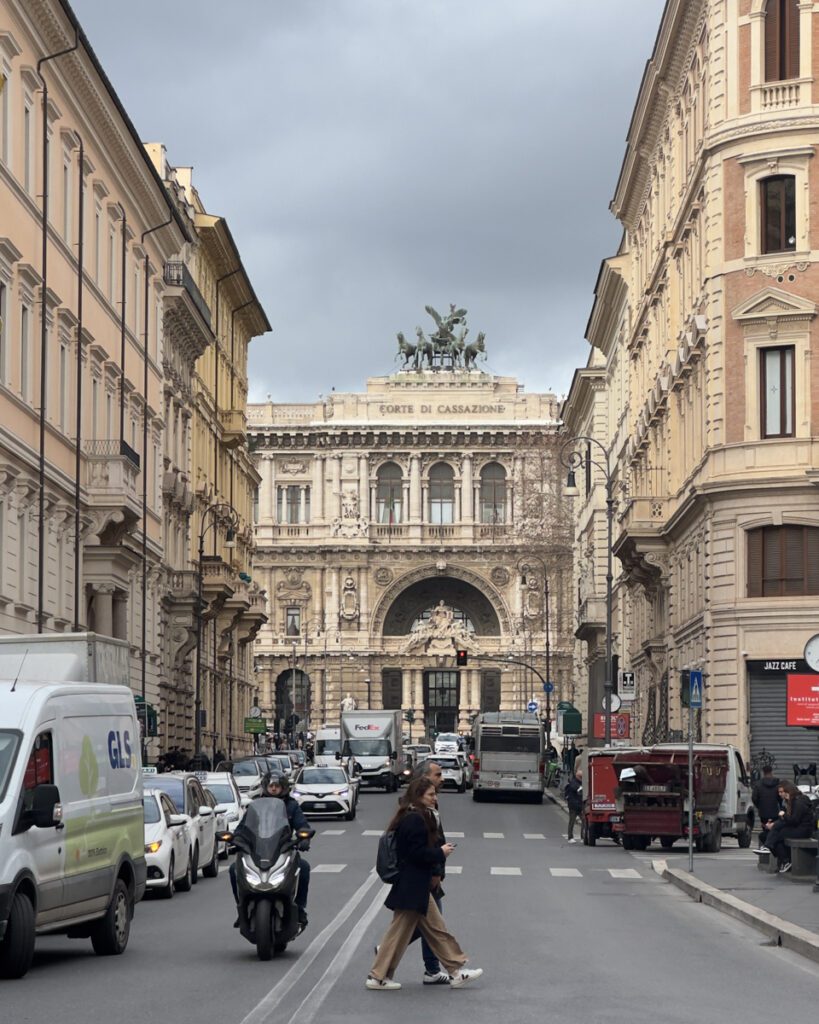
Where to eat in Rome – Some of the best vegan-friendly restaurants
There is no shortage of delicious places to eat in Rome. In fact, the last time we came here, we basically went to eat to our heart’s content. It’s really hard to go wrong in the city… but it is easy to fall into tourist traps!
A rule of thumb to avoid tourist traps is to check reviews beforehand. Also, check and compare pricing. Usually, if you’re very close to a major landmark, chances are it’s a trap! If you still want to enjoy the view and scenery here, just order a glass of wine, a coffee or a little snack.

If you’re looking for delicious places to eat, that also have vegan-friendly options, here are some of our favorites in Rome:
- Coromandel: A delicious breakfast-brunch restaurant in a charming setting. They have typical decadent breakfasts, as well as plenty of vegan options. Derek loved his French toast with eggs and bacon. Carine devoured her chickpea waffle with crunchy veggies on top. The carrot cake (vegan) was also amazing as a breakfast dessert!
We highly recommend reserving or coming before 10 am during the off-season if you don’t reserve. It gets busy really quickly! - Ecrù: A raw and plant-based restaurant that serves everything from breakfast to supper, including desserts and some treats to take home as well. We stopped here for a late-night dessert and loved each bite. Carine had the vegan tiramisu and Derek had the chocolate bomb. Both were delish!
- Forno Monteforte: We stopped by here for a coffee and a vegan croissant. A lively restaurant, café and pizzeria you should add to your list! The ambiance here is so vibrant. Frequented by locals (more than tourists), it’s such an energetic place. The coffee was tasty (and innexpensive), and the croissant was mouth-watering. You would never know it’s actually vegan!
- Bono Bottega Nostrana – San Pietro: A small sandwich shop run by a local family. Whether you’re looking for something sweet, savory or vegan, this is a great little shop. With homemade bread and tasty ingredients, we had such a great meal here. Derek splurged on the Nutella and Ricotta sandwich, while Carine had the chicory and mushroom panini. Both were amazing in their own way.
- Rifugio Romano: We didn’t end up going here, but this plant-based restaurant is on of the best in town… even compared to regular restaurants. If you want to eat here, make sure you book ahead of time. Enjoy a typical Roman meal, but made plant-based. We’re making sure to reserve our table next time we go to Rome.


- Grezzo Raw Chocolate: A chain of dessert bars mainly based around chocolate. Their all-vegan menu is what chocolate lovers’ dreams are made of. Whether you’re vegan or not, they have delicious chocolate-based desserts and gelatos. We had the salted caramel chocolate bomb and different gelato flavors: hazelnut, salted caramel, frutti di bosco and chocolate, and we adored each bite. We even bought some of their vegan Nutella-type spread to bring home.
- Fatamorgana: Another gelato and dessert bar well worth stopping for. They have a ton of vegan options, as well as typical gelatos and ice creams. We loved every flavor we tried: Fior di Chocolate, Maracuya, Lemon and Mango.
- Origano: Another chain of restaurants with plenty of vegan options to choose from. We came here with friends and although the atmosphere could be improved, the food is quite tasty! Everyone enjoyed what they ordered: pizza, pasta Carbonara (with real meat) and vegan caccio e pepe.
- Roscioli Salumeria: This was high on Derek’s list and it did not disappoint. A typical Make-your-own sandwich restaurant. They also have a café and a sit-down restaurant. Perfect for deli and pasta lovers.
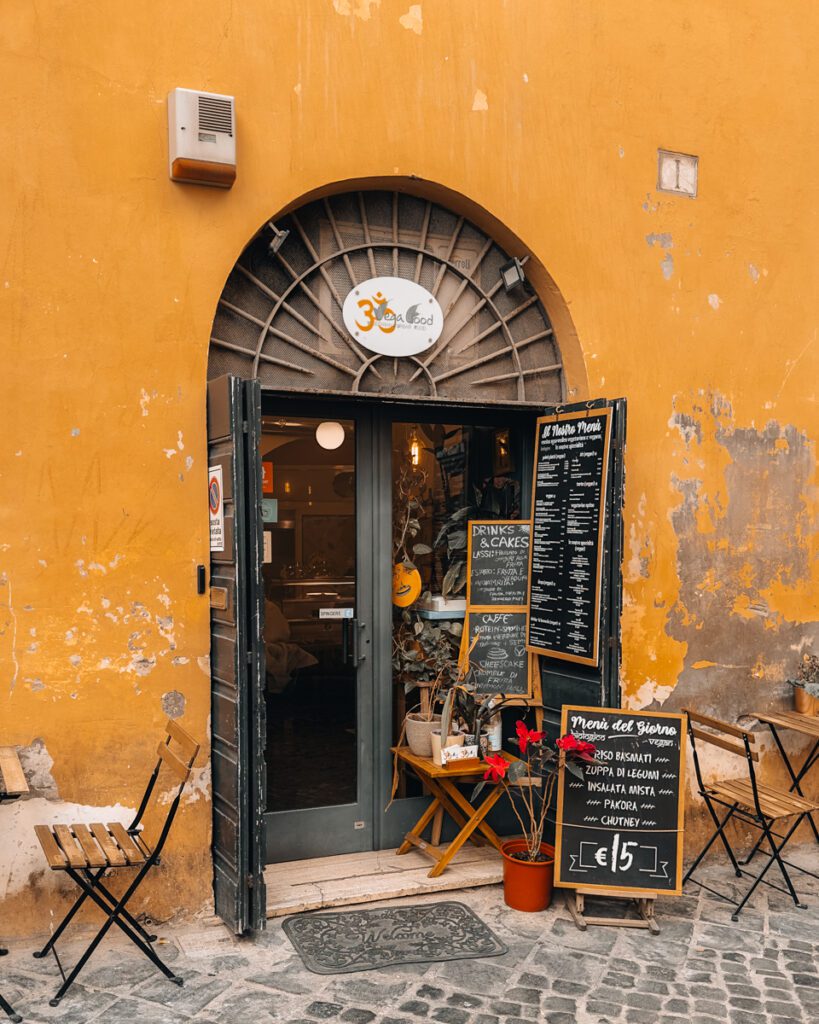
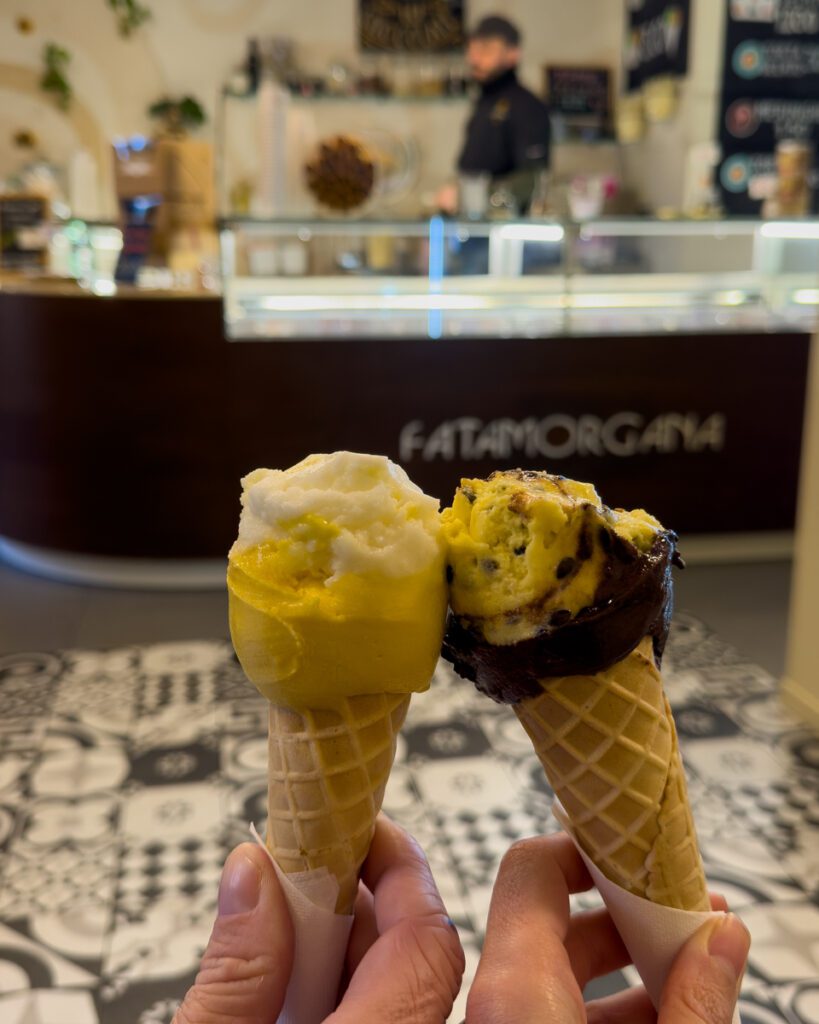
For our plant-based eaters out there, don’t worry! Even if the Italians will make fun of you for being vegan, you can still eat well in Rome. The restaurants above will have vegan options for you – not just salad, but actual meals!
If not, there are a few things you can order that pretty much every restaurant will offer:
- Pizza with no cheese: Carine had this a few times when the restaurants had no exciting options available. Order a vegetarian pizza with no cheese.
- Pasta arrabbiata: Pasta with a simple tomato and basil sauce. With good ingredients, it’s still delicious
- Tomato bruschetta: Simple bread with a tomato and basil bruschetta. Ask them to hold the cheese
- Grilled vegetables: You can always find some as a main or a side dish. Ask them to cook it with oil (no butter) and when they serve it, you can put some olive oil or balsamic oil on it.
- Side dishes: Often, you’ll find healthy and nutritious side dishes that are vegan (ask them to prep it with oil, just to be safe). Chiccory, potatoes, beans. hey often have 3-4 side dishes you can order and make a full meal out of it.
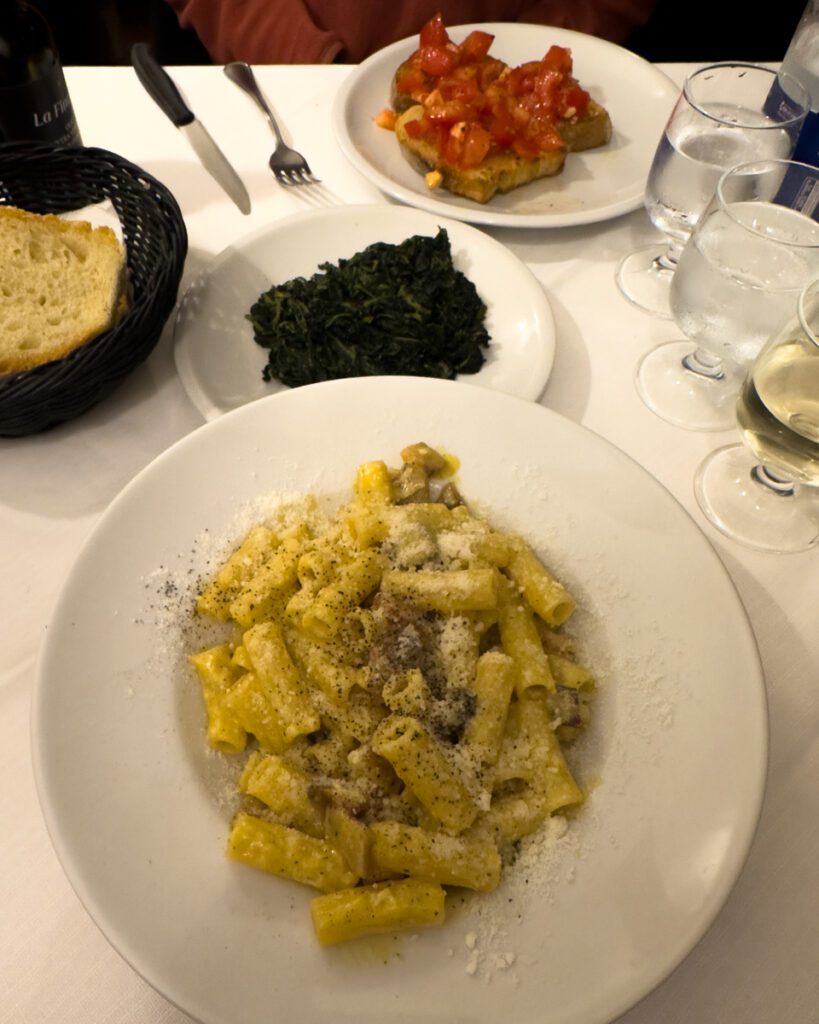

How to get around during your 3 days in Rome
The best way to get around Rome is to walk. So many of the main tourist attractions are located within the city’s historic center and getting around there is quite easy. It’s also a great way to discover hidden gems, like little cafés, restaurants, cute churches and other lesser-known places. Just note that you’ll end up walking a lot. Like 25,000+ steps a day!
To navigate around the city, use the Google Maps app. It’s also great for telling you which buses and trams to take. If you don’t have a European SIM card, we recommend getting an eSIM with Airalo (if your phone supports it). It’s the easiest way to get data when you travel.
Use the code CARINE5115 to get $3 off your package.
If not, the bus, tram and metro systems are quite well organized in Rome. You can easily get around using public transportation. If you purchase an Omnia 3-day pass during your time in Rome, you’ll even have access to free public transportation within the city limits, as well as to get into the best museums and landmarks.
Finally, you can also use Uber to get by. It’s good for getting around when the weather isn’t so good. And if you’re lucky, you might get discounted rates for getting to the airport.
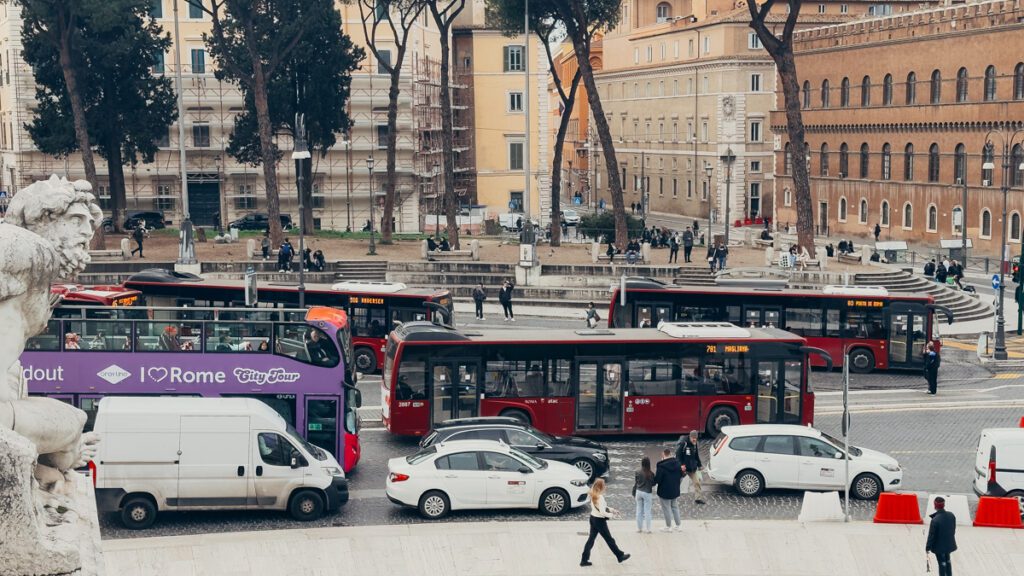
How to get from FCO airport to Rome
To get to and from the airport, there are a few options, all depending on what time you arrive at the airport.
The cheapest and one of the most efficient ways to get to and from the FCO airport to the city is to take this airport shuttle. Make sure you check the schedule so it works out with when you need to get around. Just know that on busy days, it can take you close to an hour to get out of the city center.
There is also a great train system that can get you to the city, either at Roma Termini, Roma Trastevere or anywhere else on the train line.
Finally, we don’t recommend taking a taxi from the airport. However, we took an Uber to get out of the city, to the airport. Uber was having a 20% off promotion going on and we got the ride for €40, instead of the usual €50.
Some hotels will also offer shuttle service to and from the airport. Check with your accommodations to get their pricing.
Everything you need to know about spending 3 days in Rome
We’ve covered a lot already in this article, but if you still have some questions, we have another article for you to read. We answer some of the most important things you need to know about visiting Rome. Everything from the best time to go, how to skip lines, if you should be tipping and so many other travel hacks and tips.
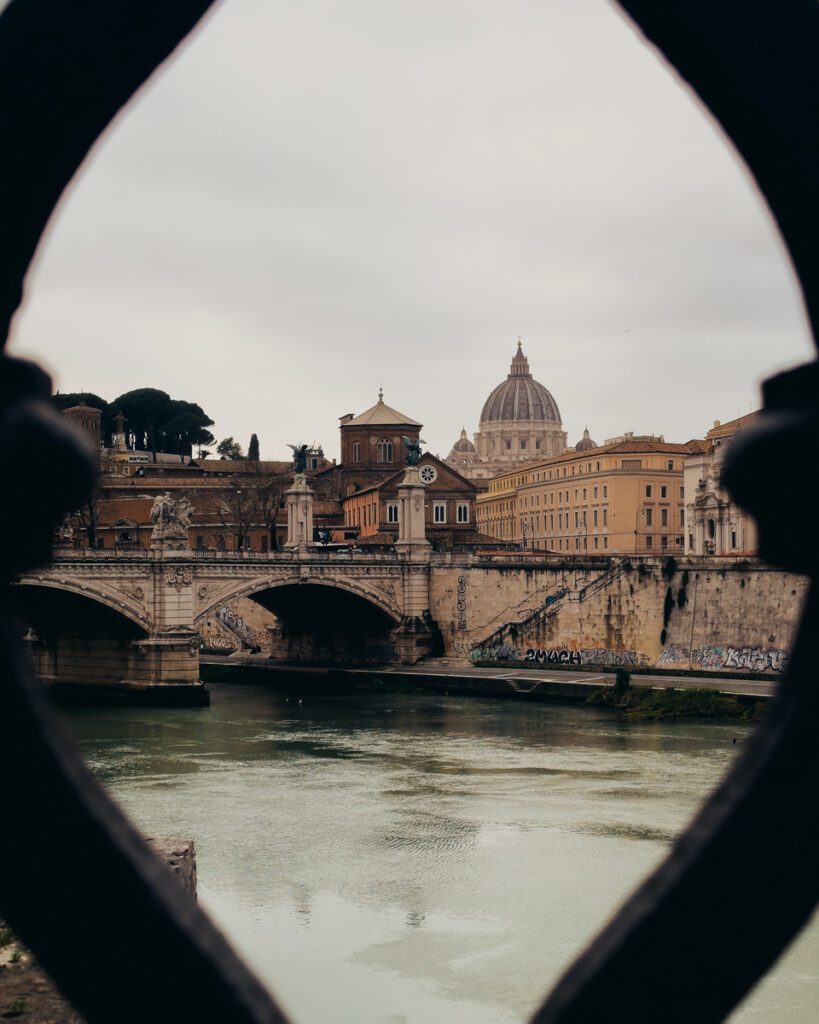
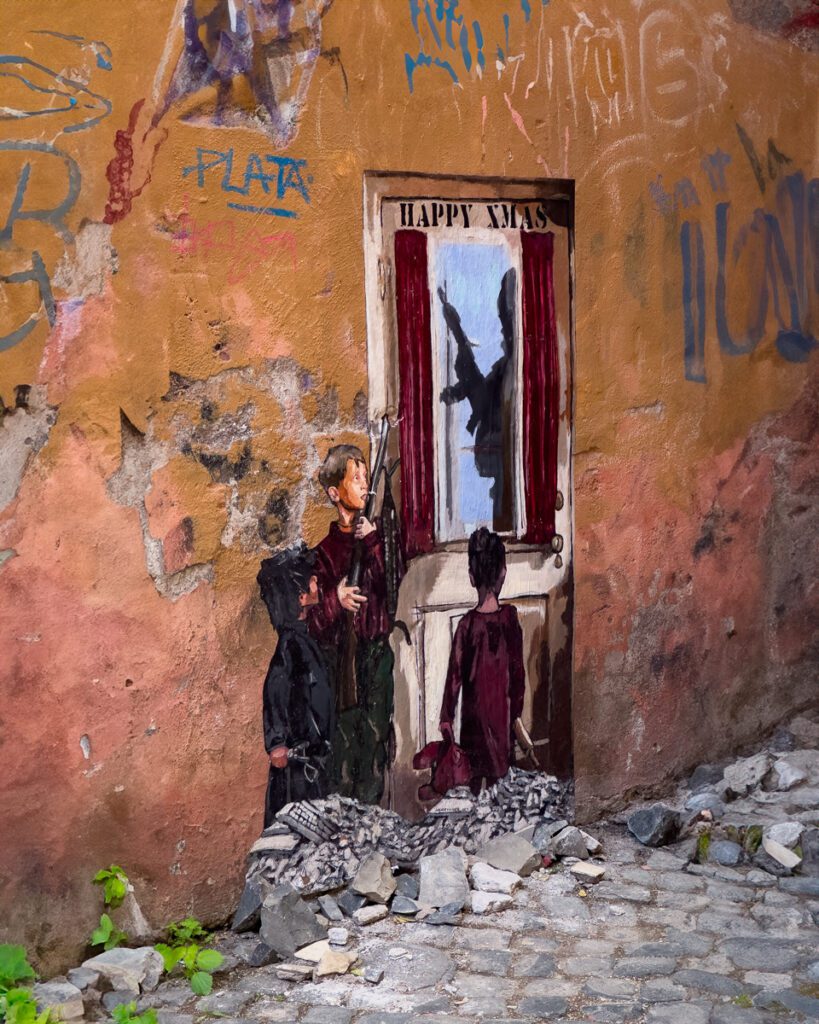
The 21 best attractions to see in 3 days in Rome
As a reminder, here are the 21 best things to do in Rome if you only have 3 days in the city. These will cover the major landmarks, as well as a few hidden gems:
- Colosseum
- Roman Forum & Palatine Hill
- Via dei Fori Imperiali
- Altar of the Fatherland
- Capitoline Hill
- Vatican Museums & Sistine Chapel
- St. Peter’s Basilica
- Trevi Fountain
- Pantheon
- Spanish Steps
- Piazza Navona
- Castel Sant’Angelo
- The Jewish Quarters
- Villa Borghese, museum & gardens
- Appian Way
- Catacombs of Rome
- Trastevere
- Basilica di Santo Stefano Rotondo al Celio
- Chiesa di Sant’Ignazio di Loyola
- Campo de’ Fiori Market
- Complesso di Sant’Ivo alla Sapienza
There you have it! not only do you now know all the top attractions to visit in Rome, but you also have 4 different itinerary options to discover them. We hope that you’ll be able to have an amazing 3 days in Rome and make the best of your time there.
Let us know in the comments what you’re most excited to discover. Which landmarks are you looking forward to seeing? Are there other places we should include in our list? Do you have any other questions to help make your trip a little smoother?
Thank you so much for reading the article all the way through!
We put a lot of time and effort into the content we create. Please like, comment and share – every action on your part helps us out tremendously and is very appreciated.
You can also help us by pinning this article for others to find.
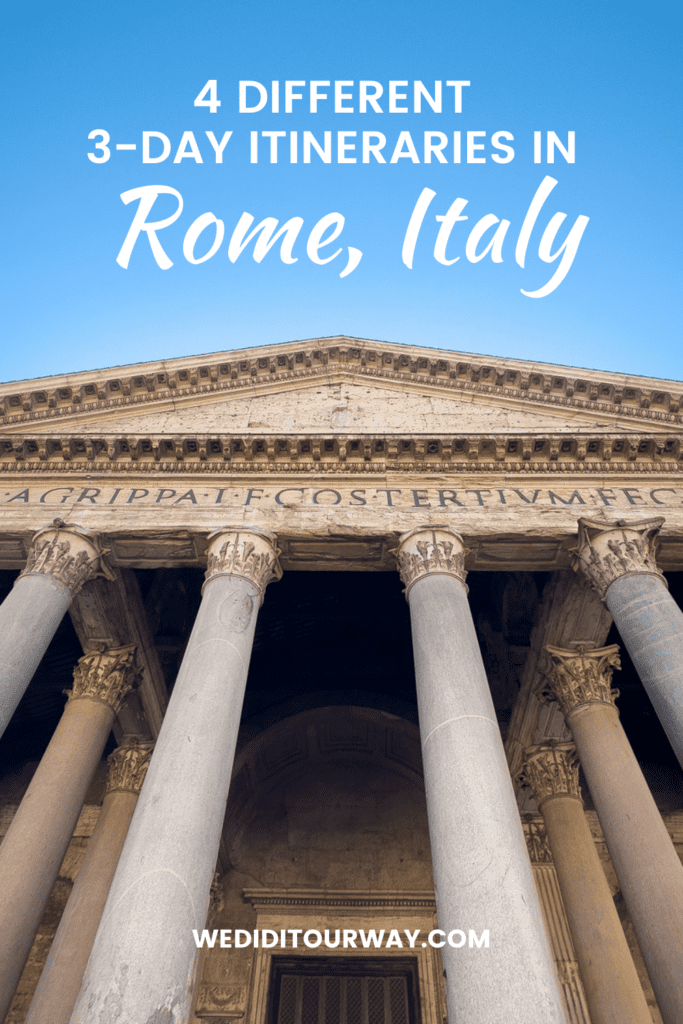

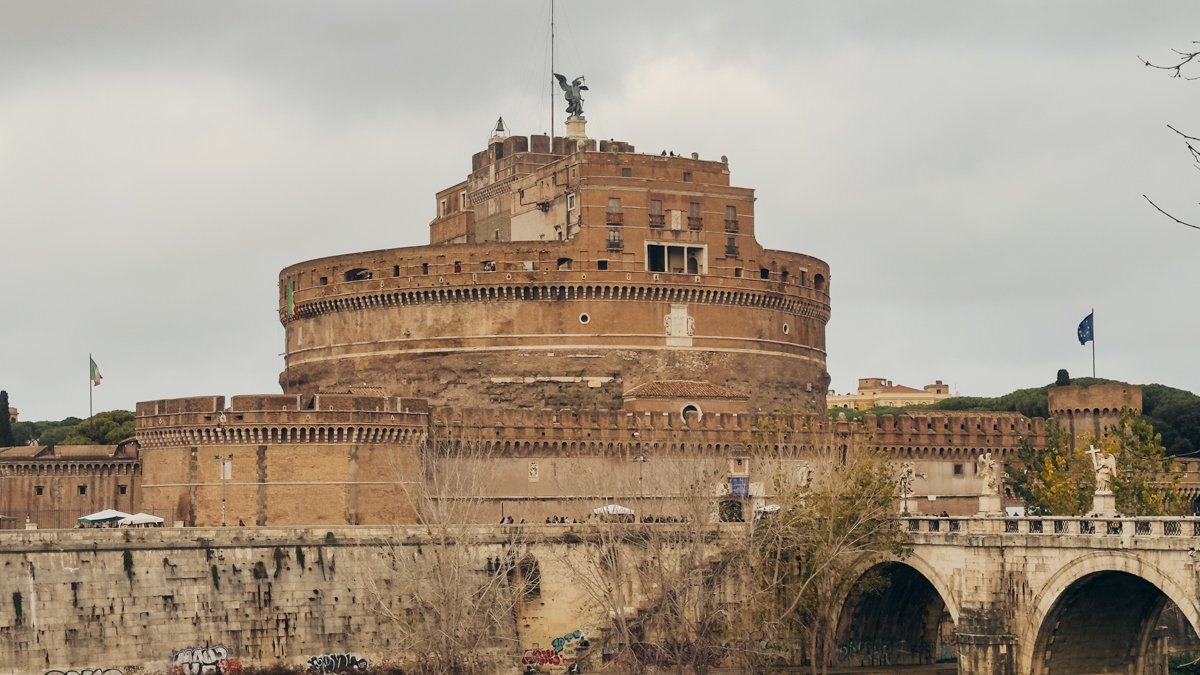
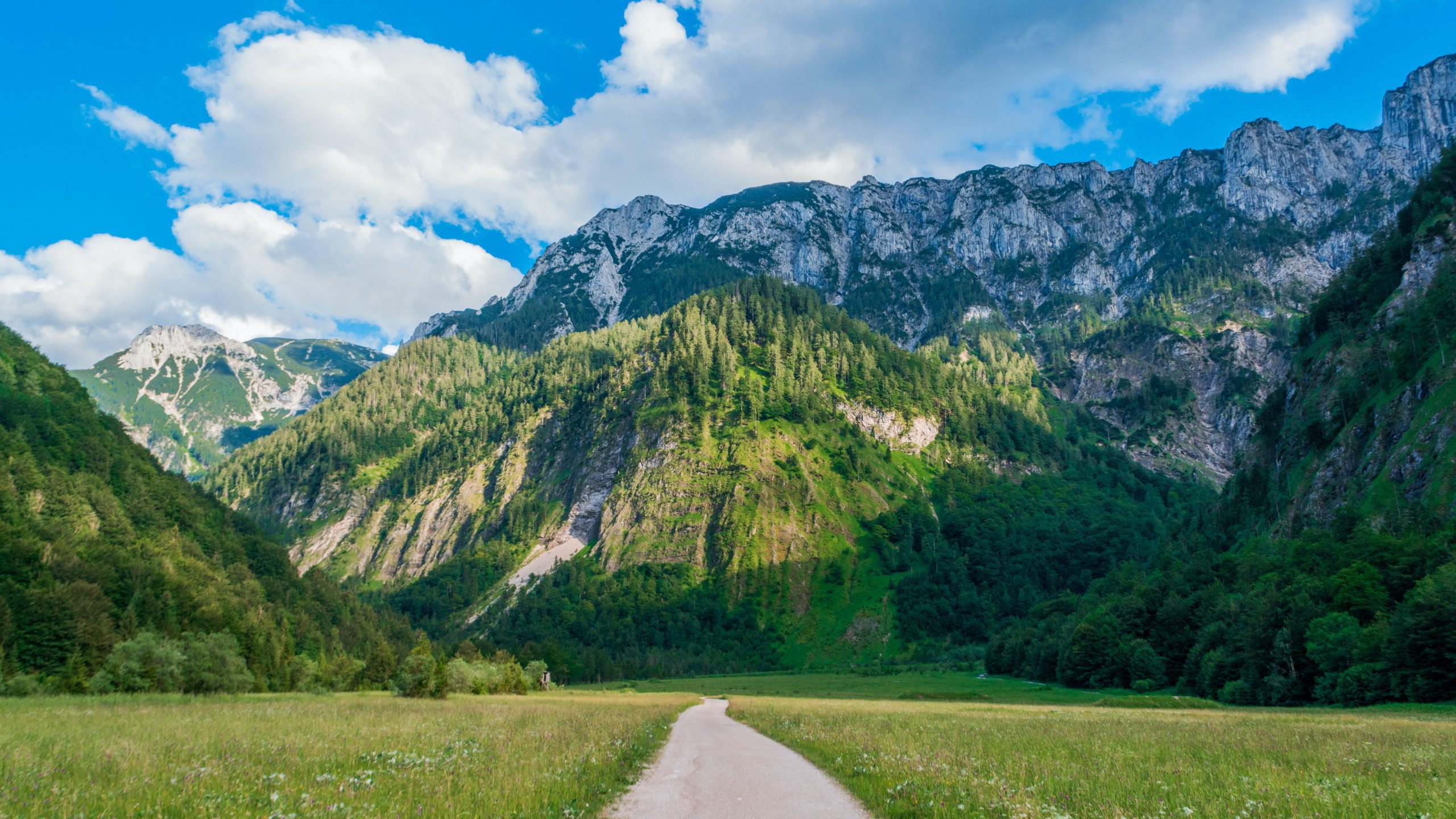
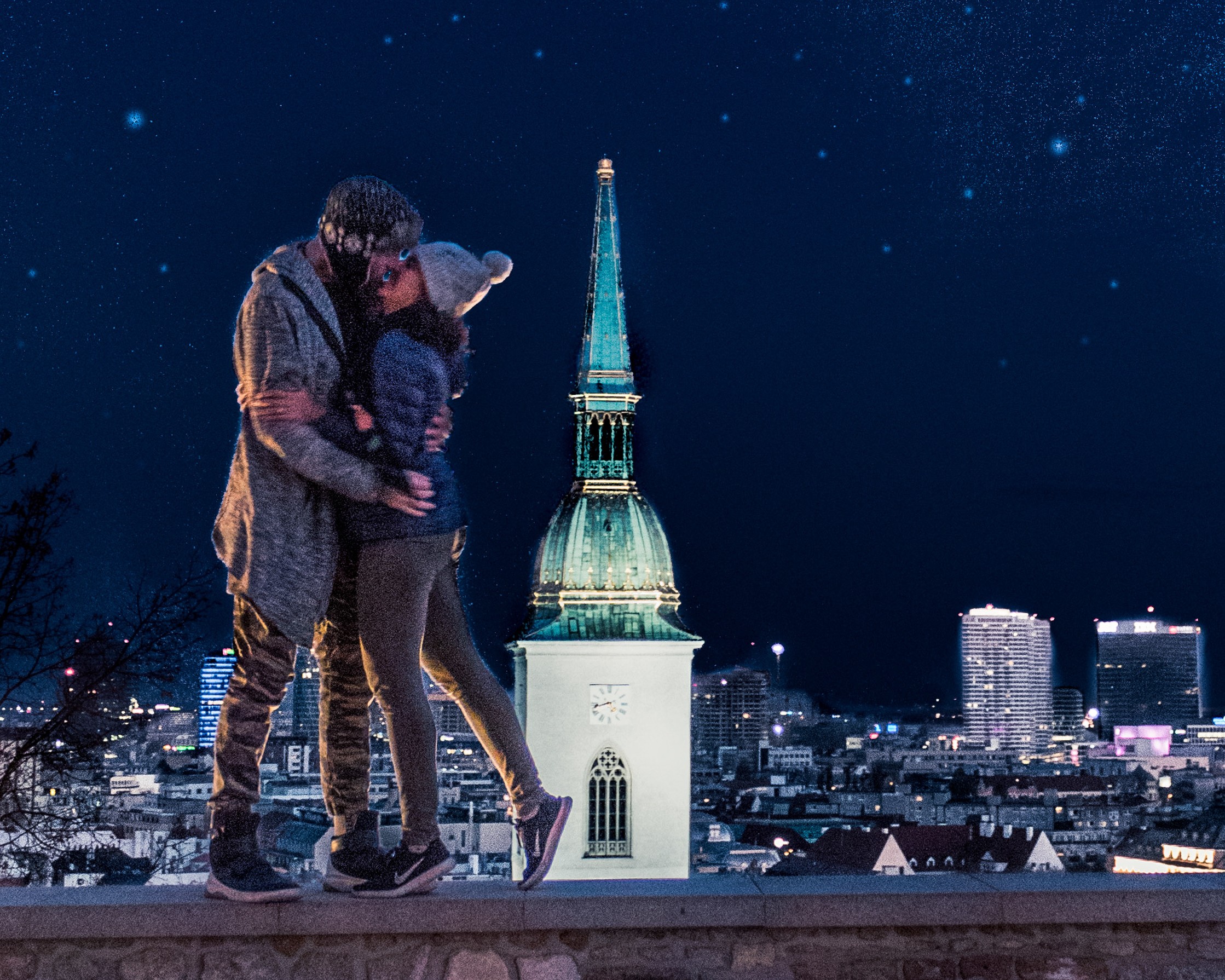
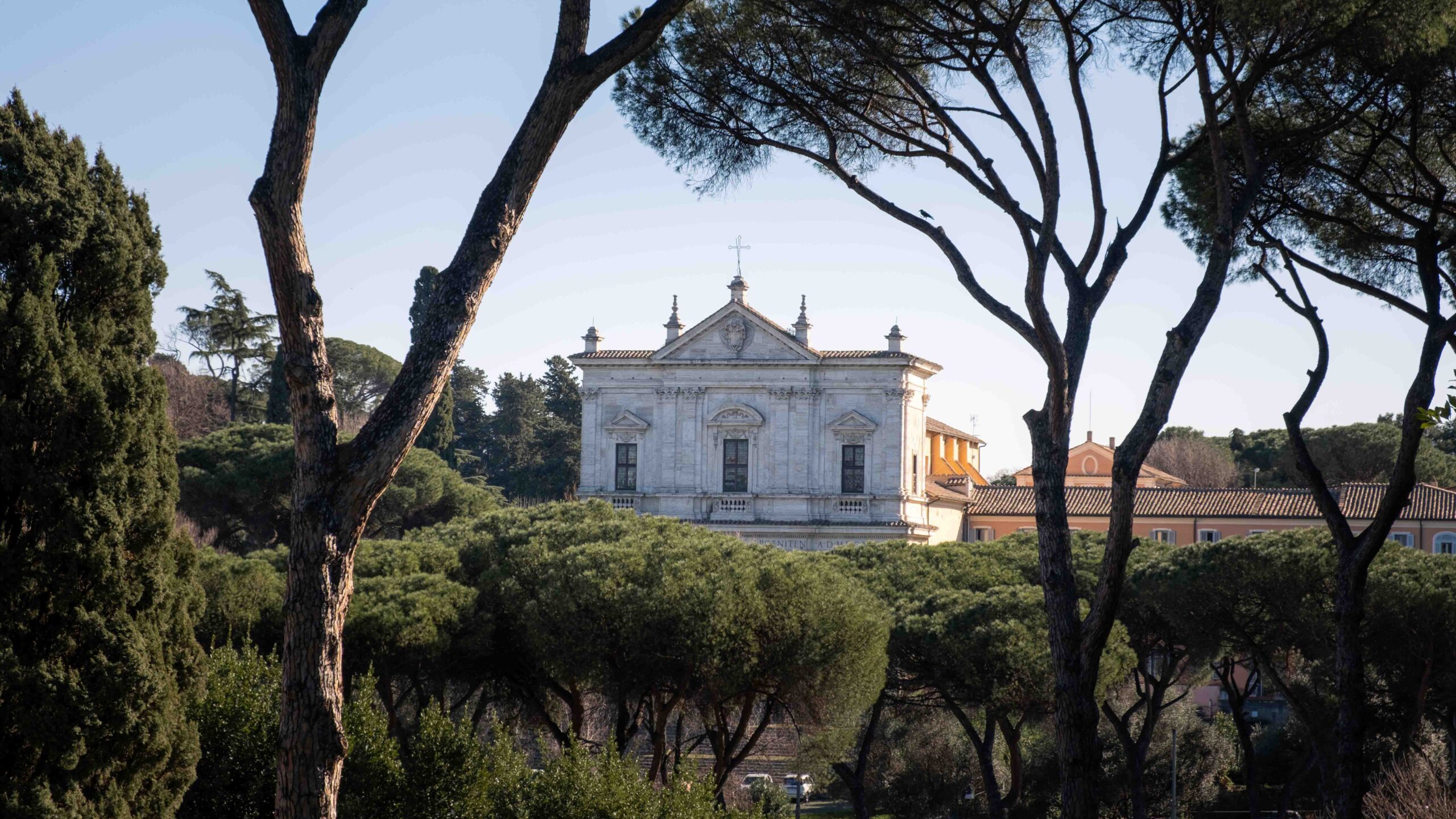
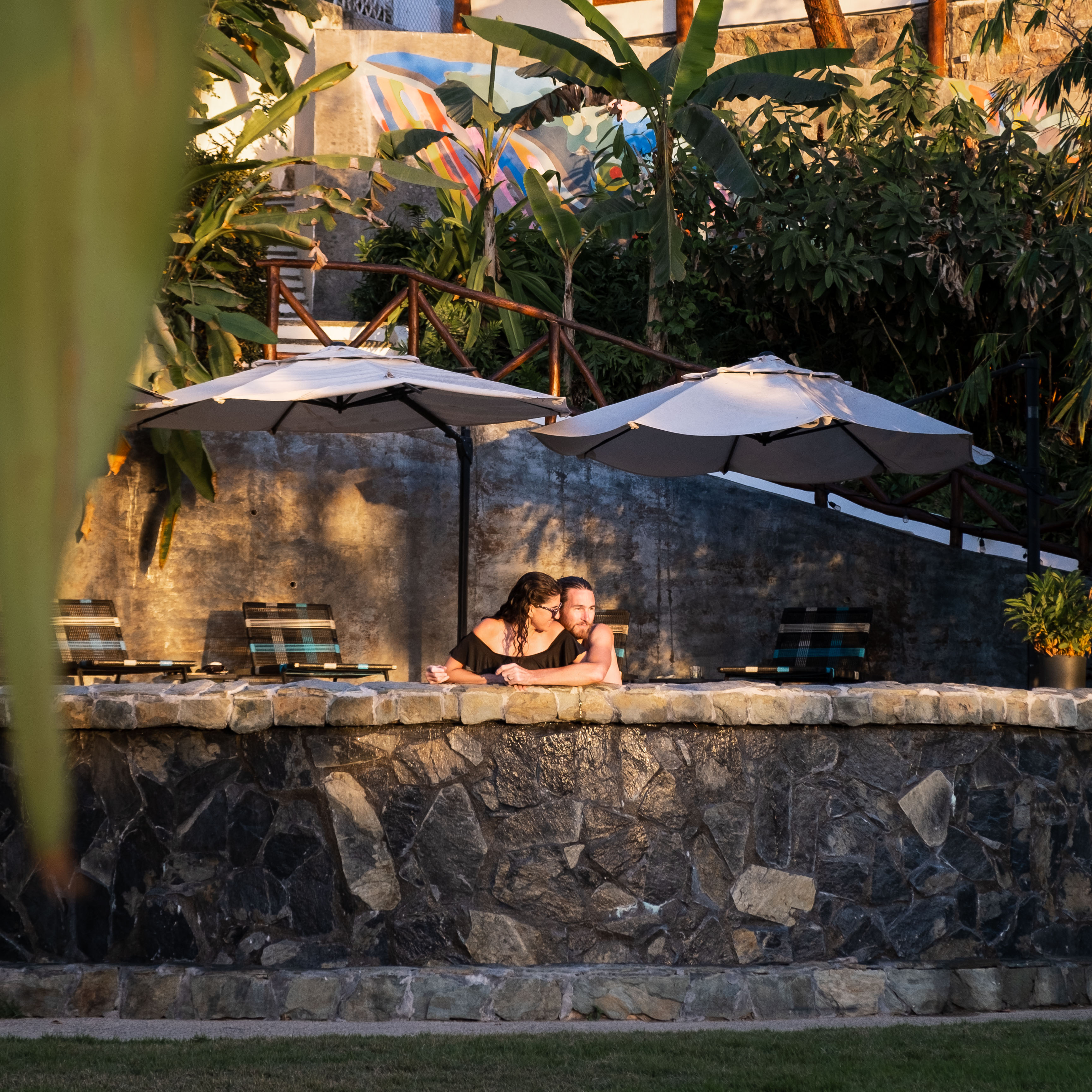


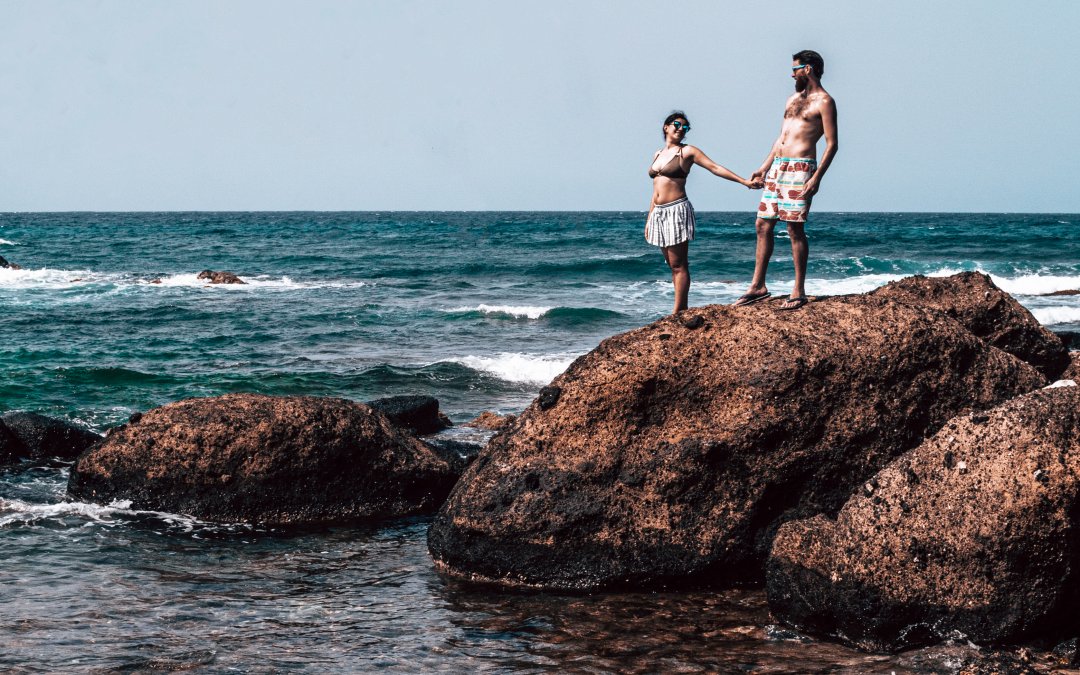
0 Comments